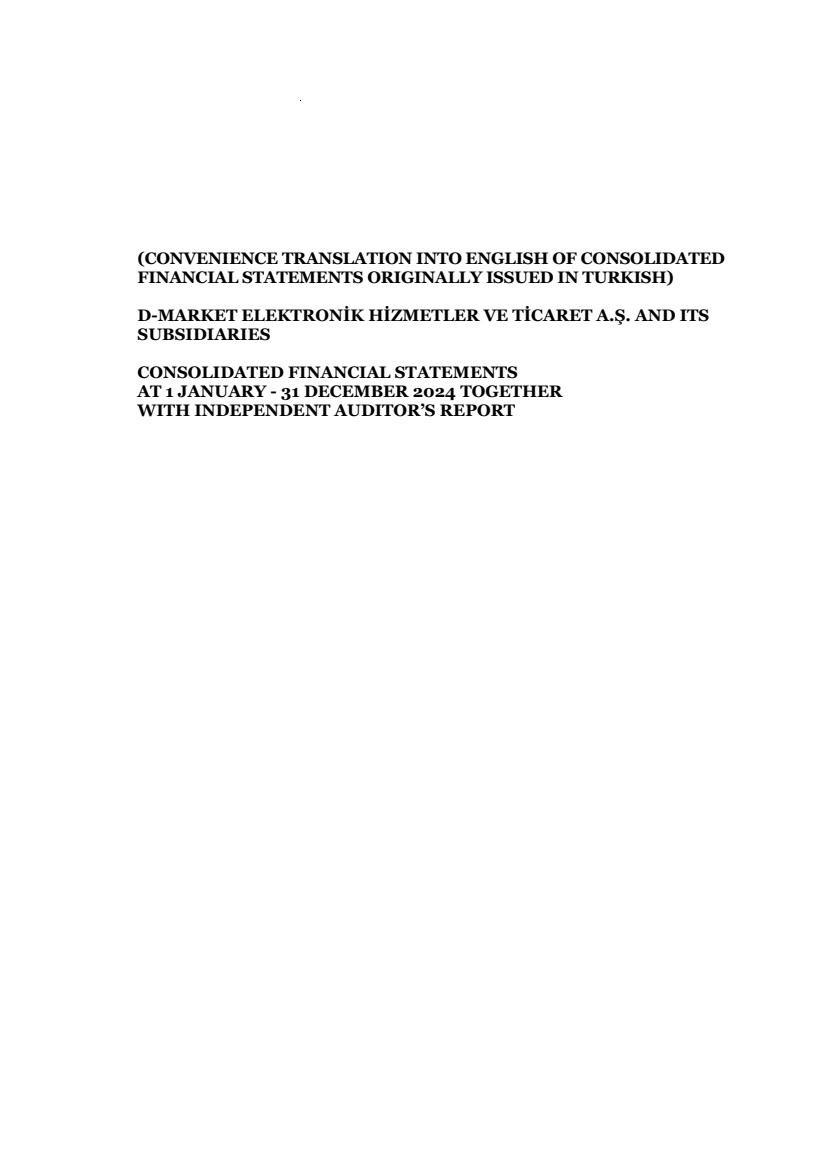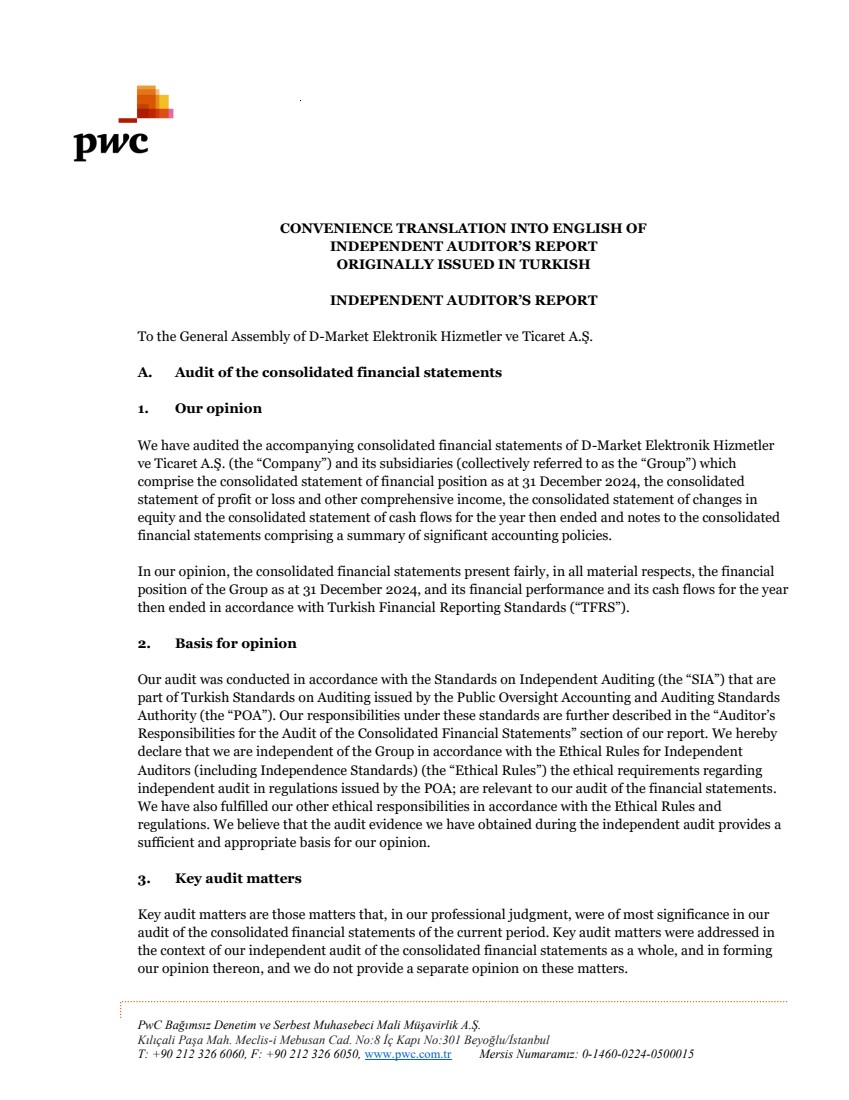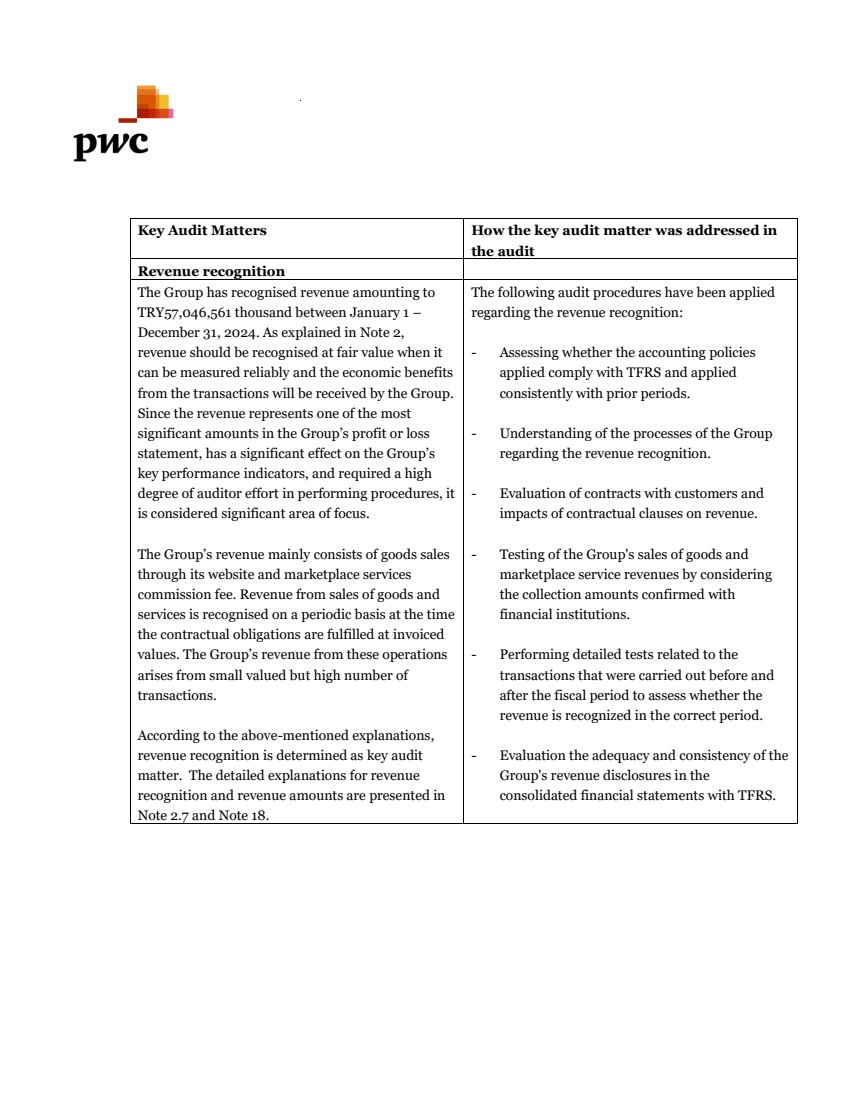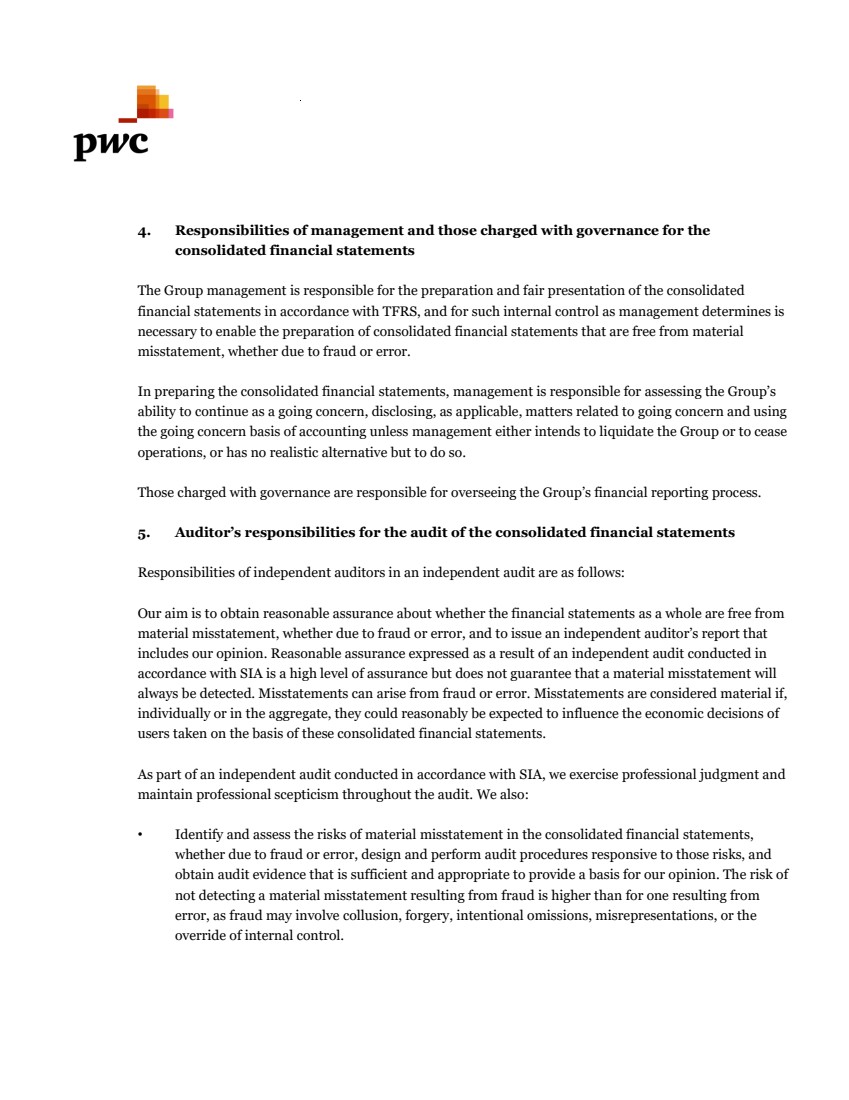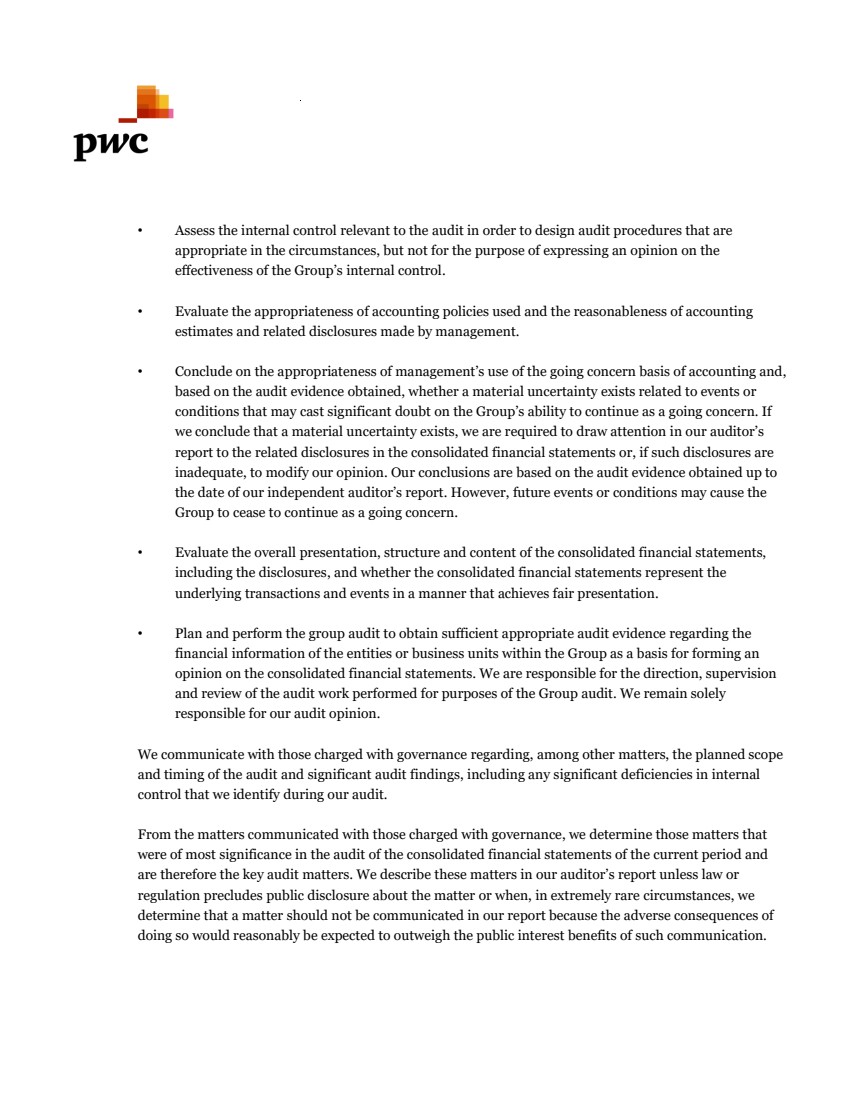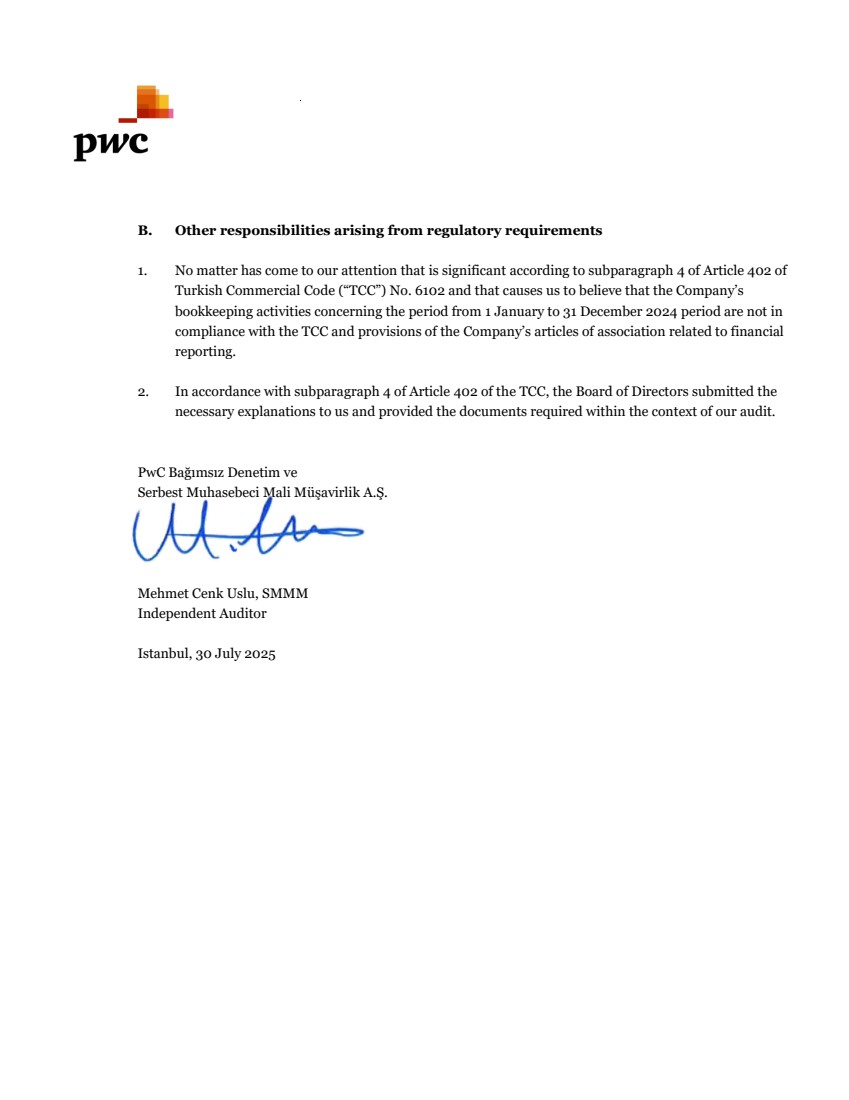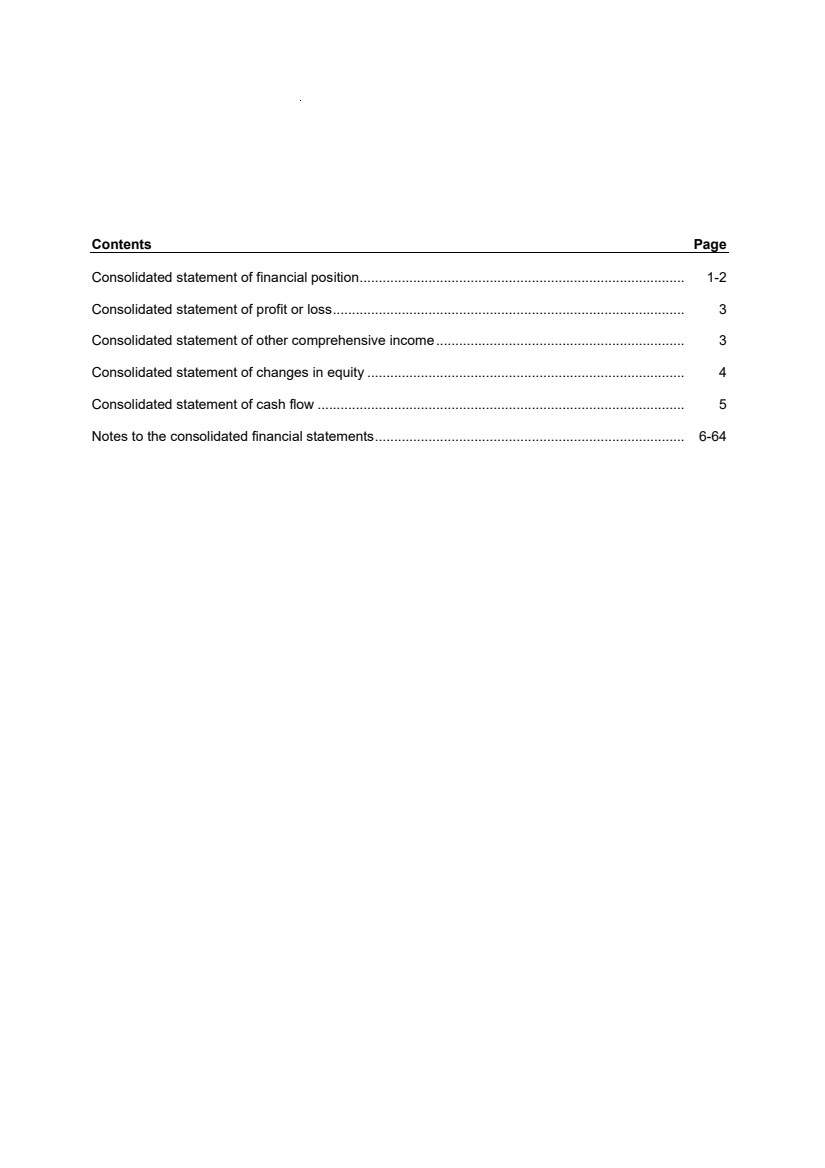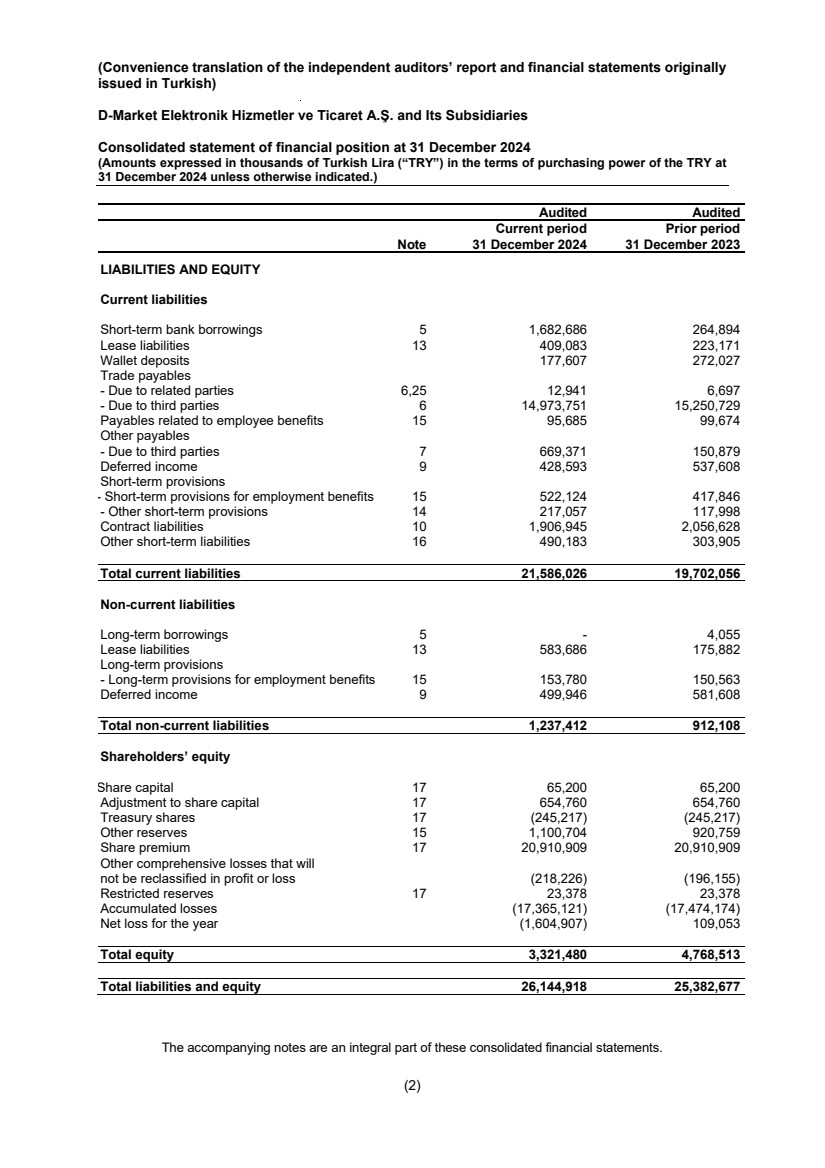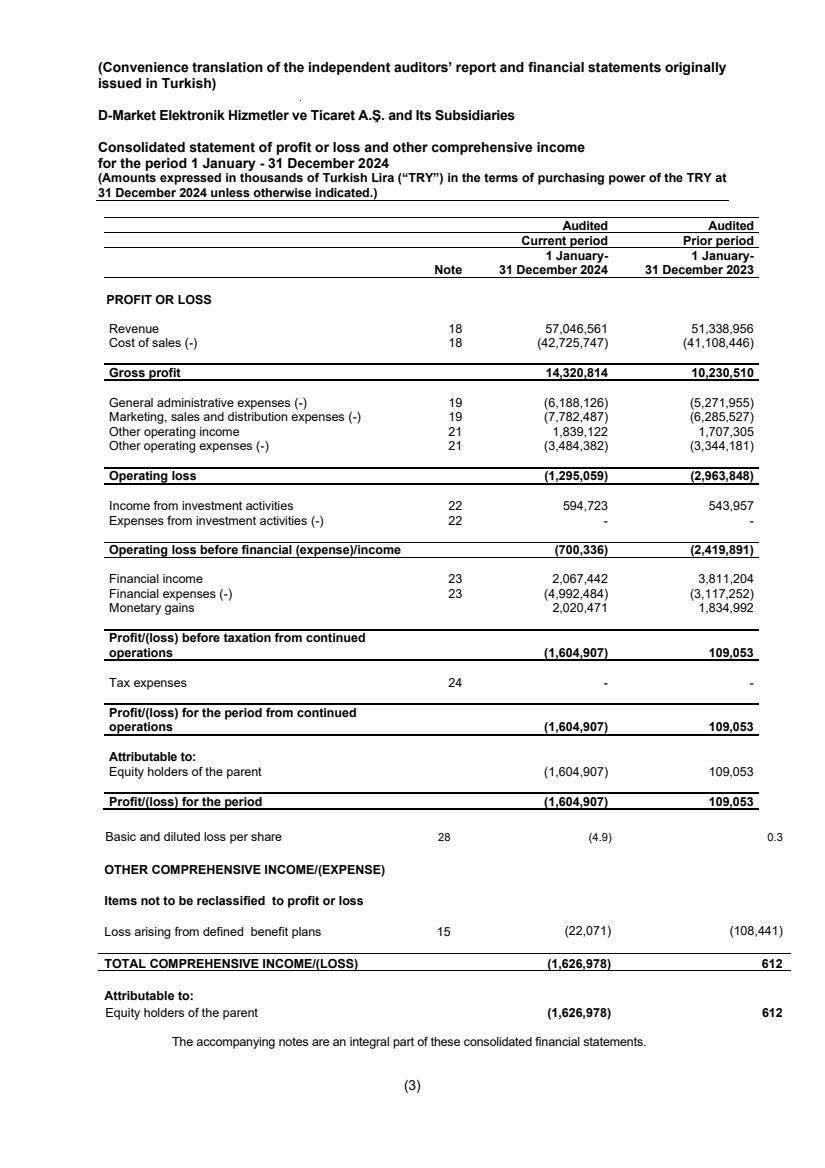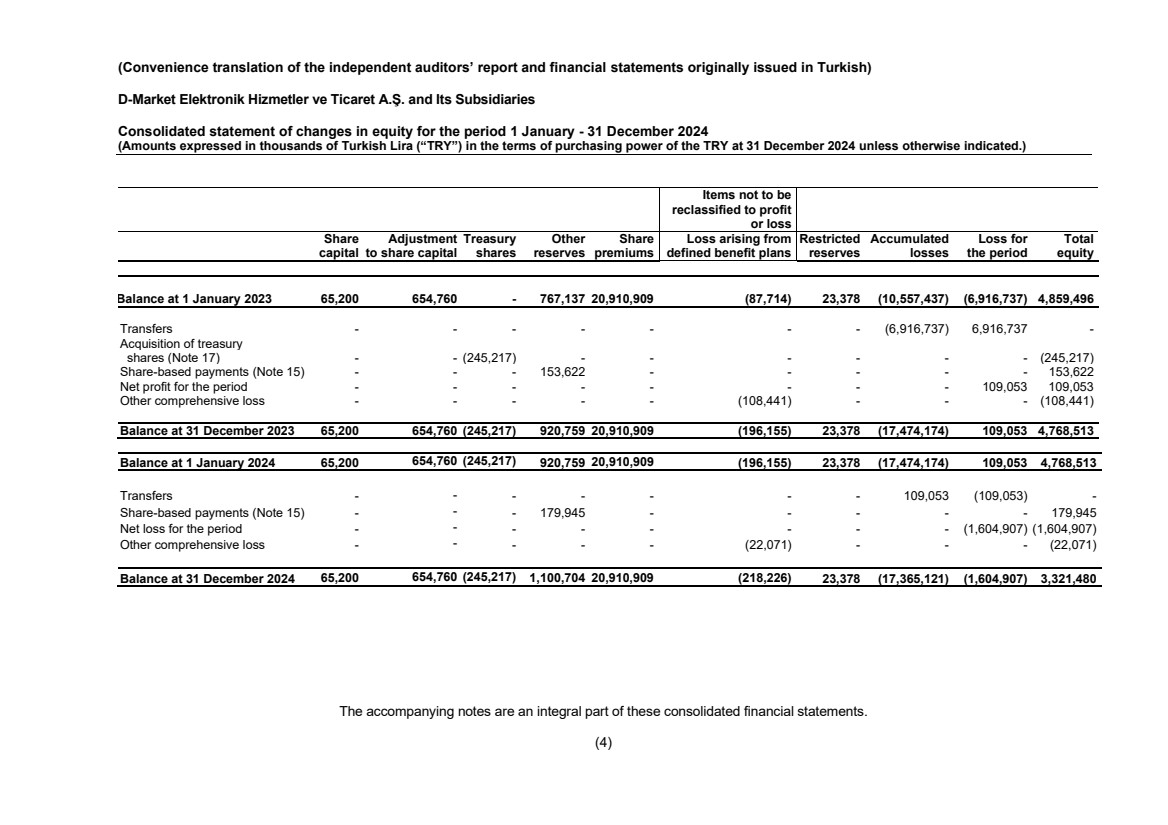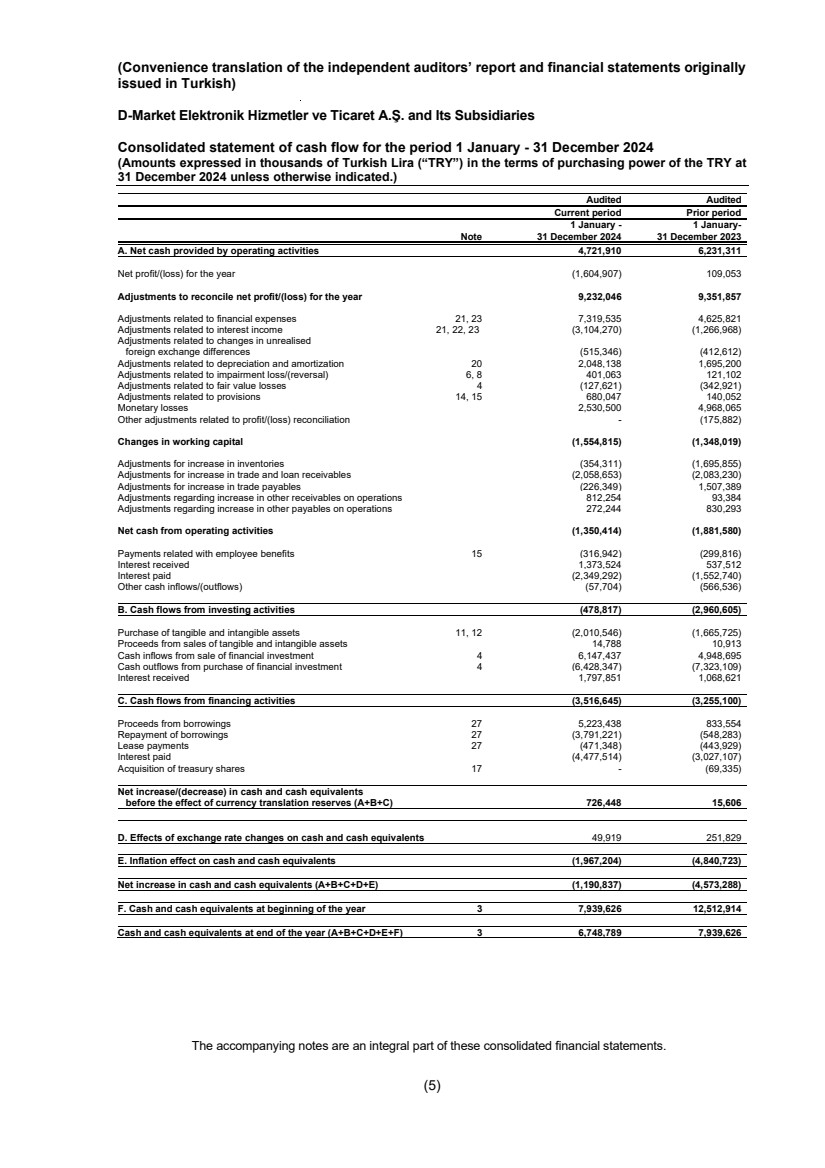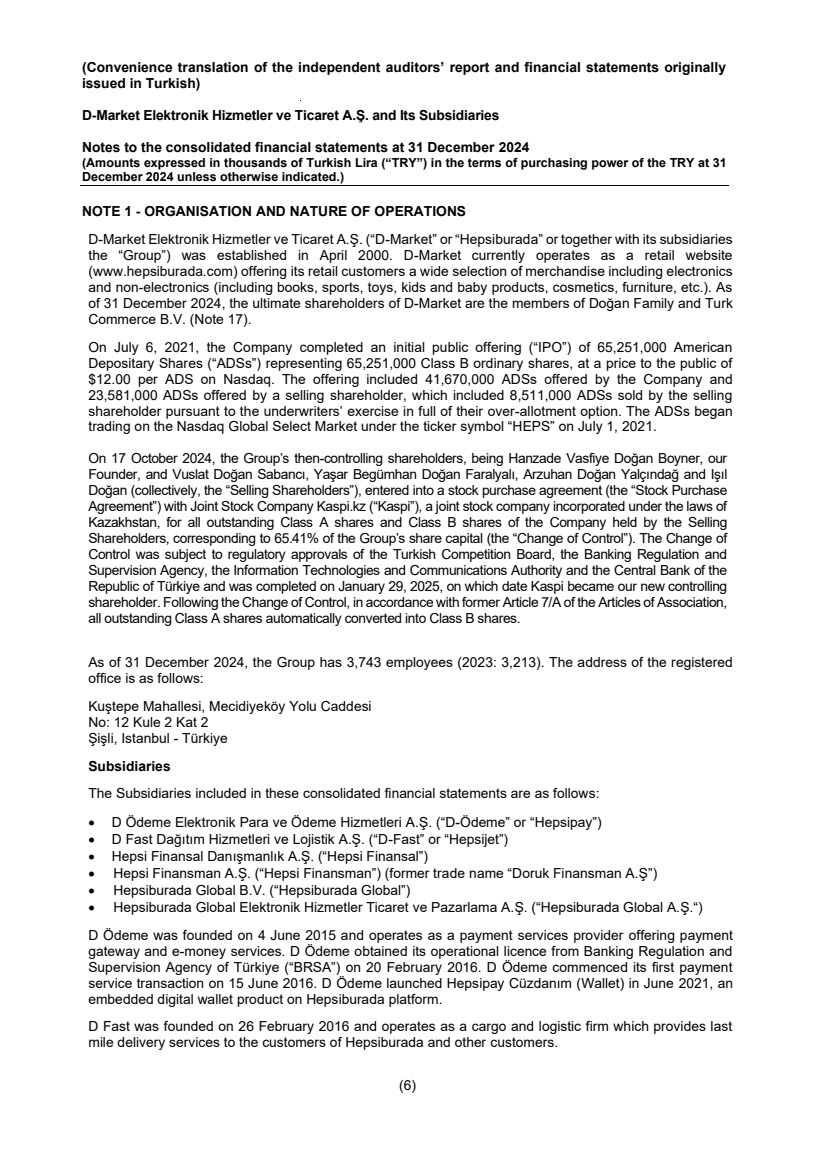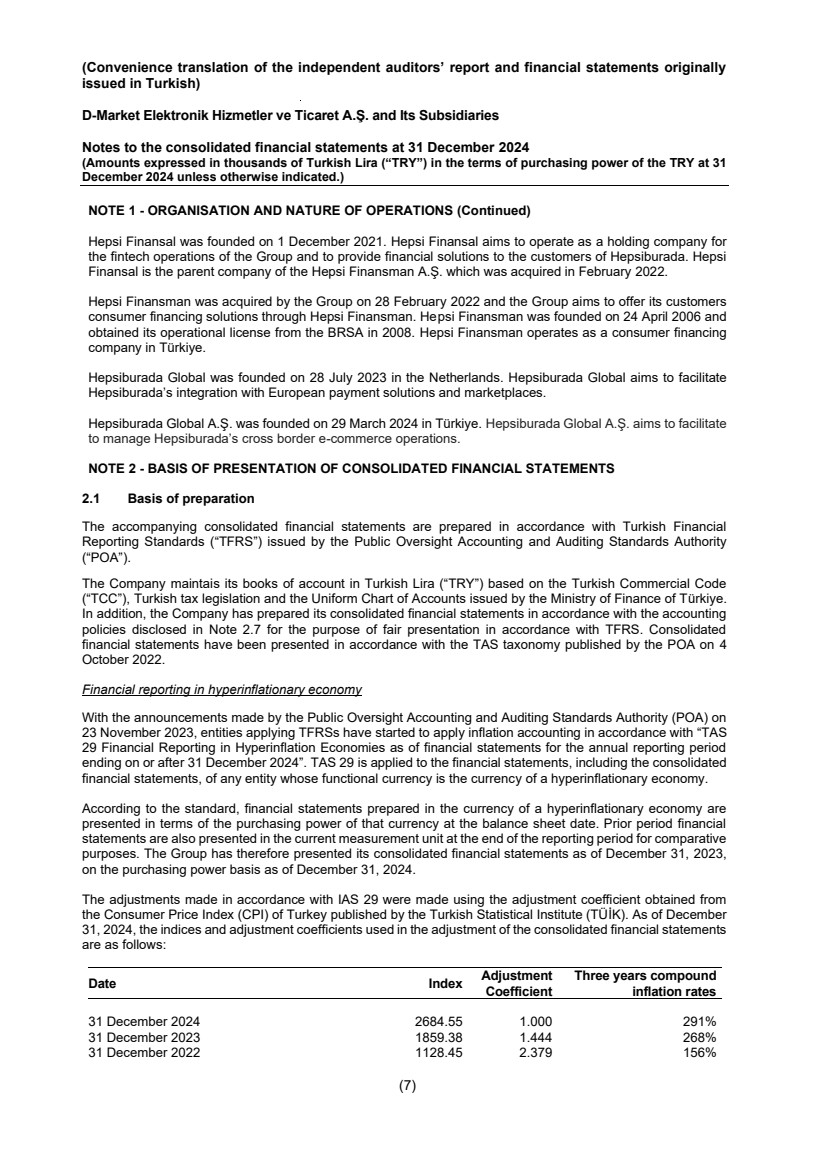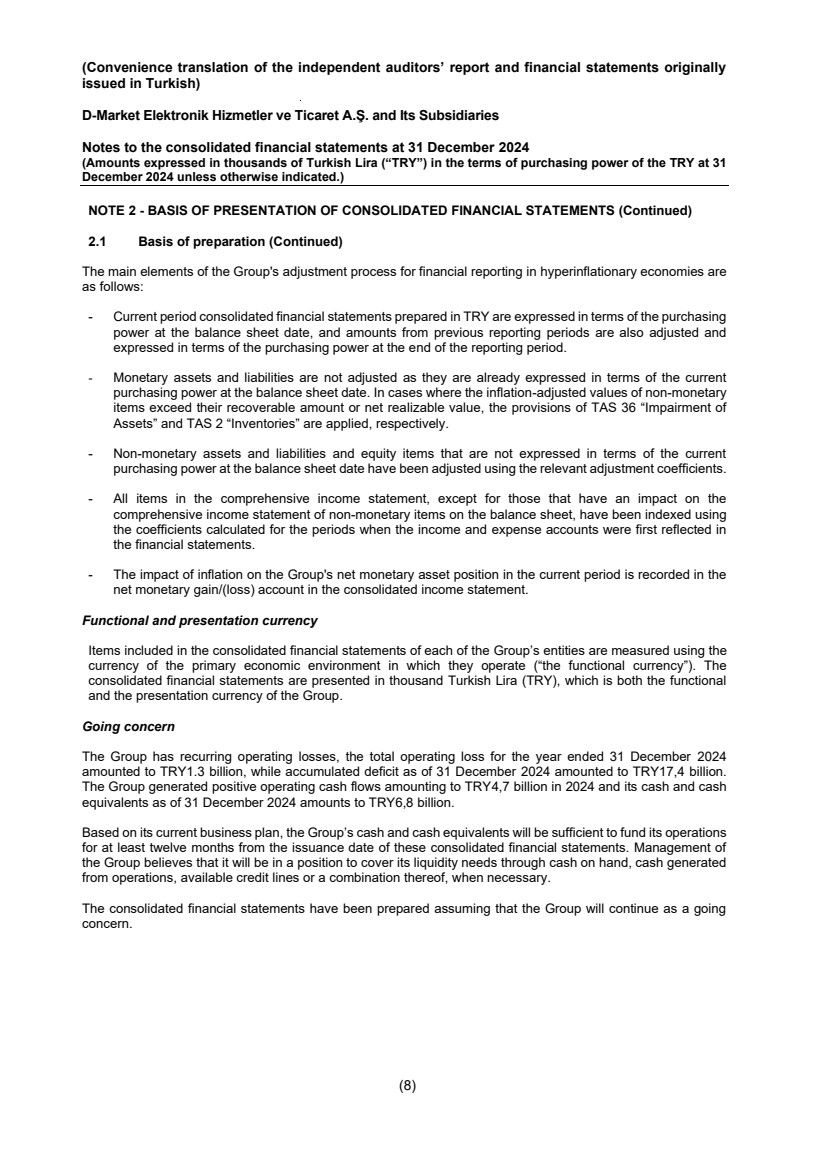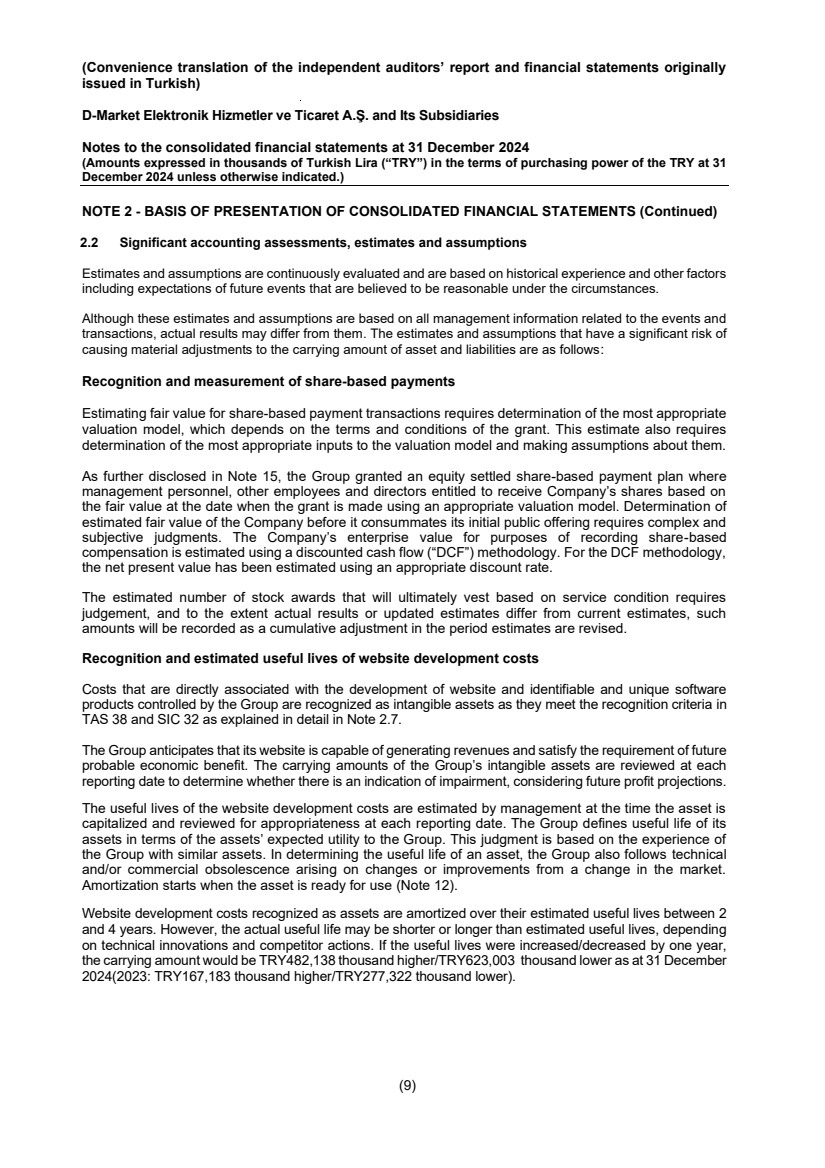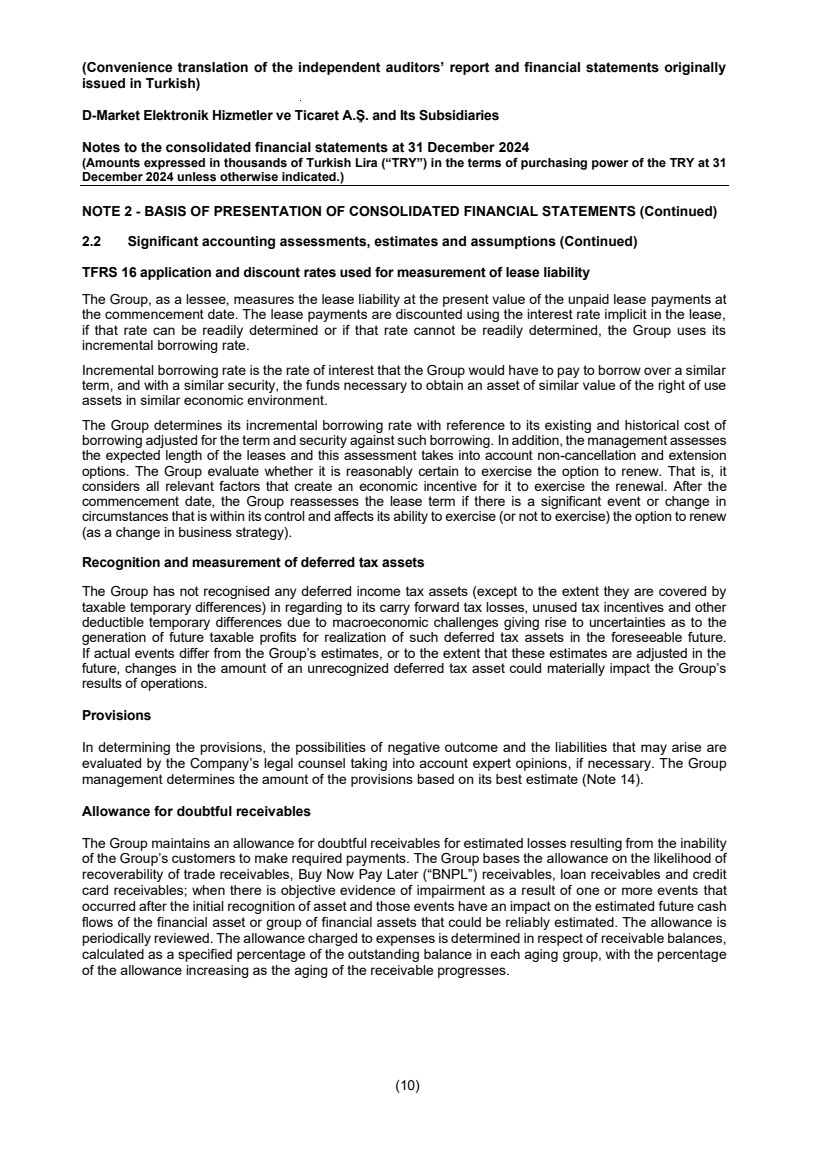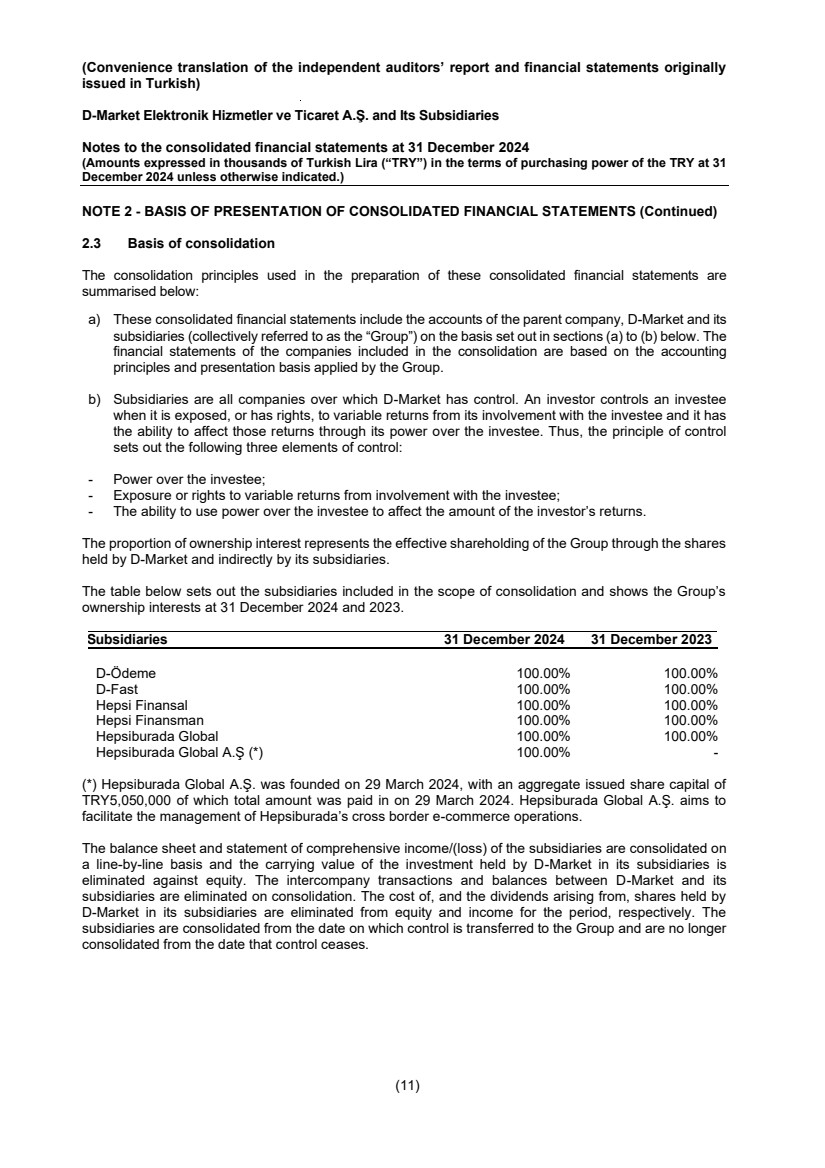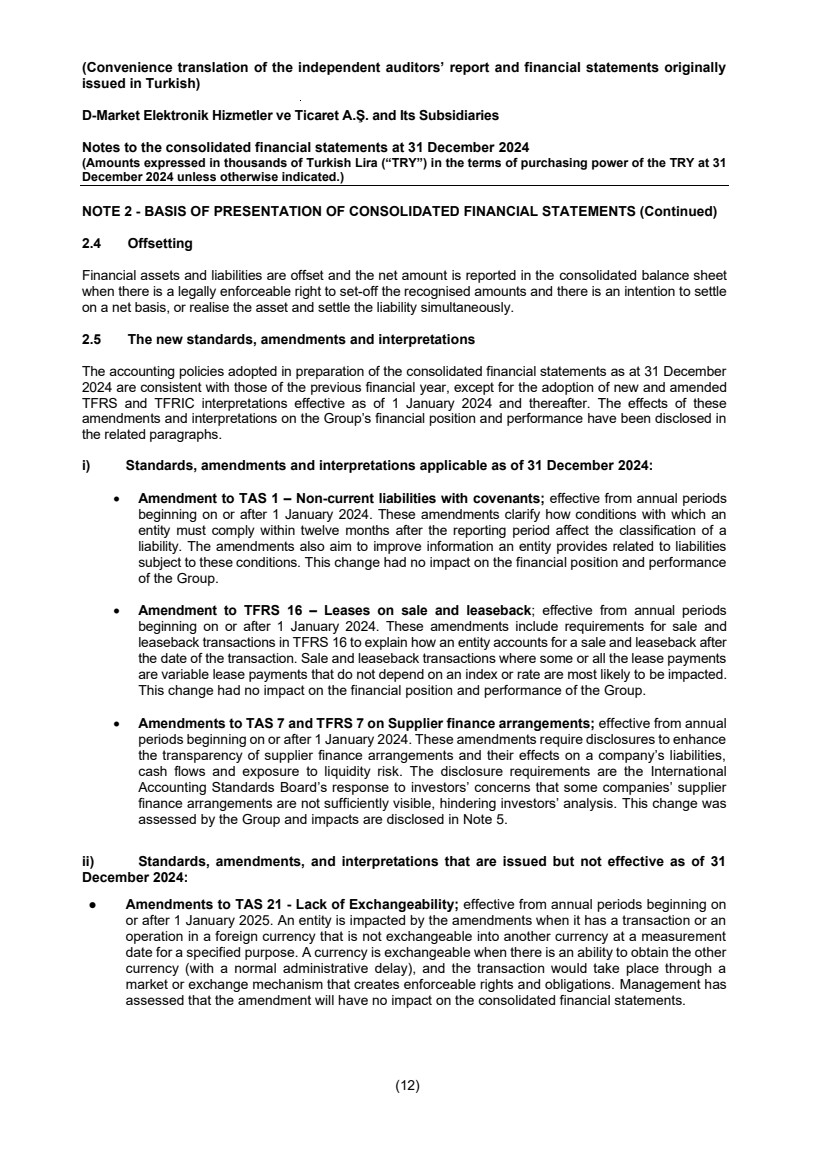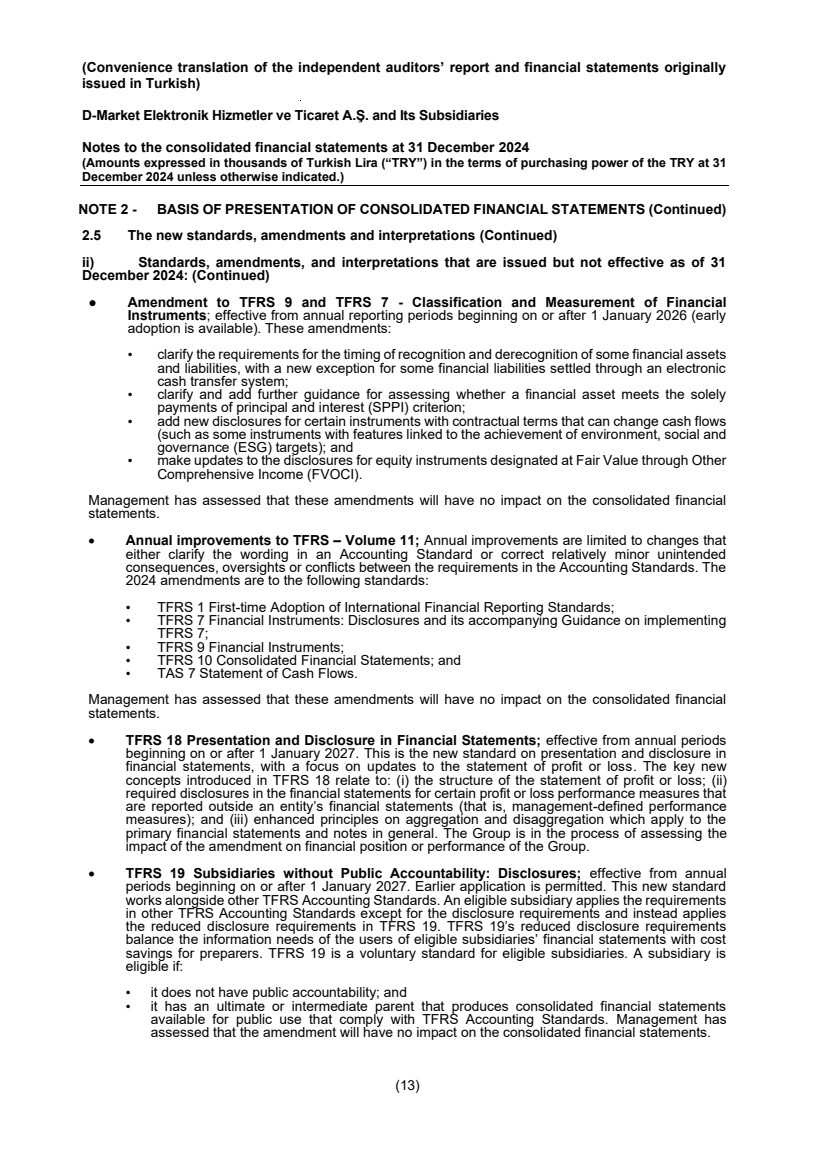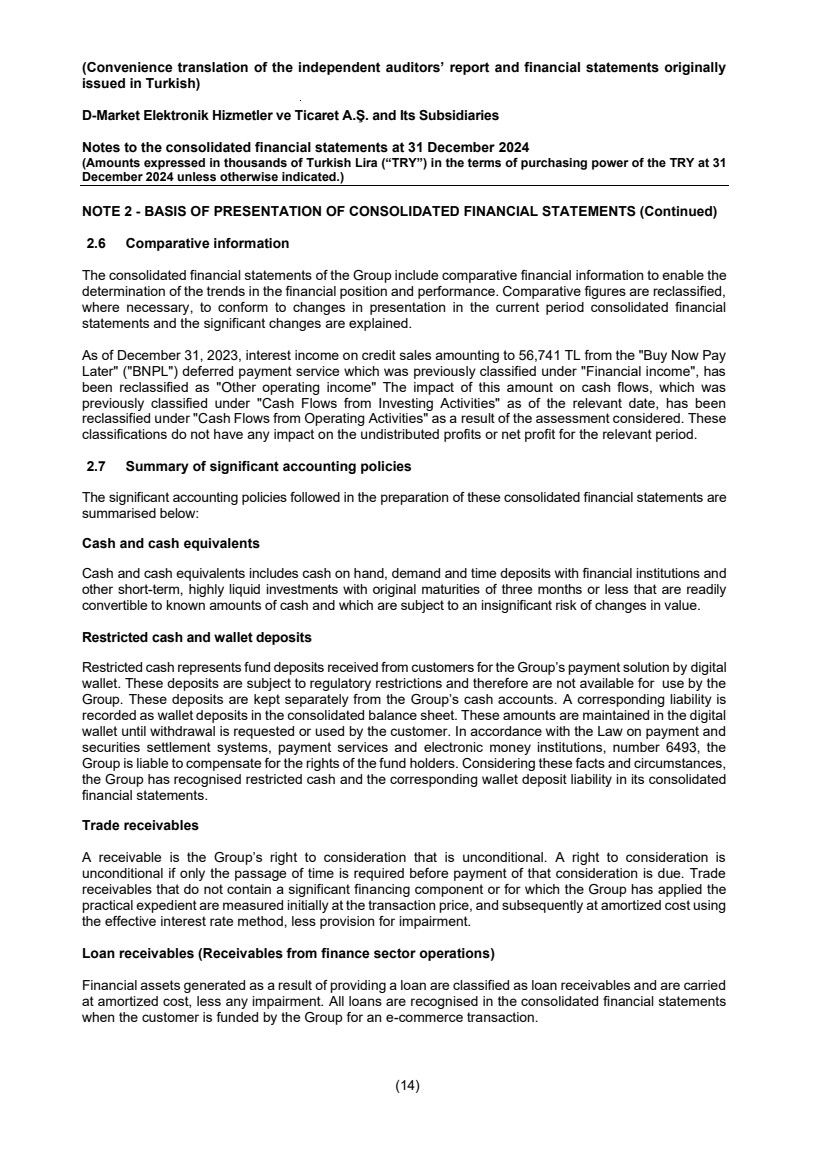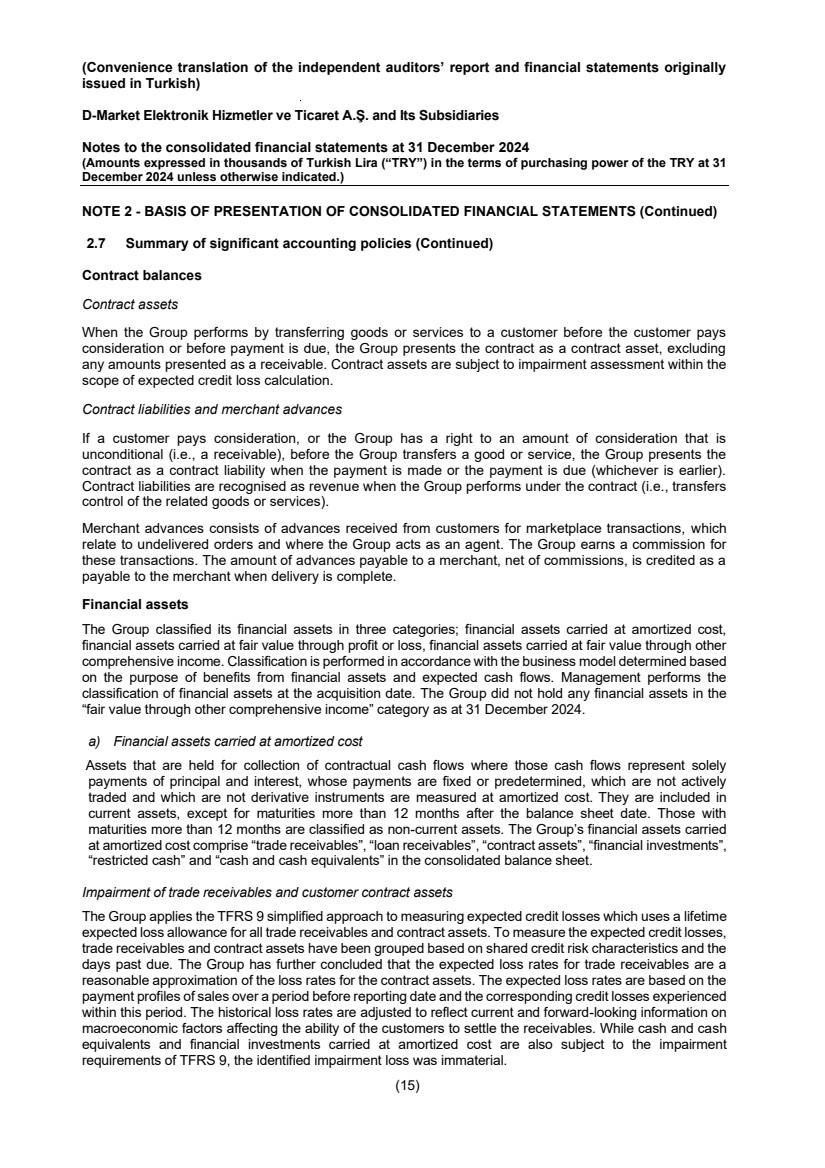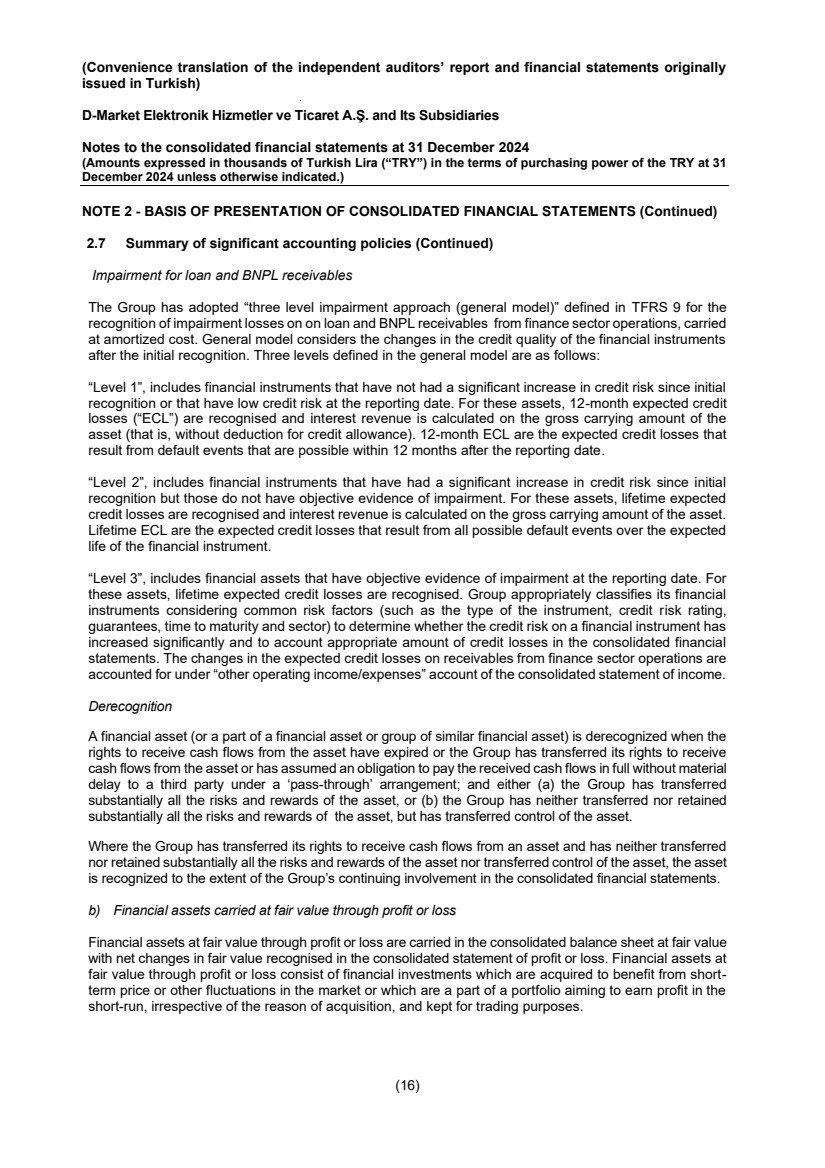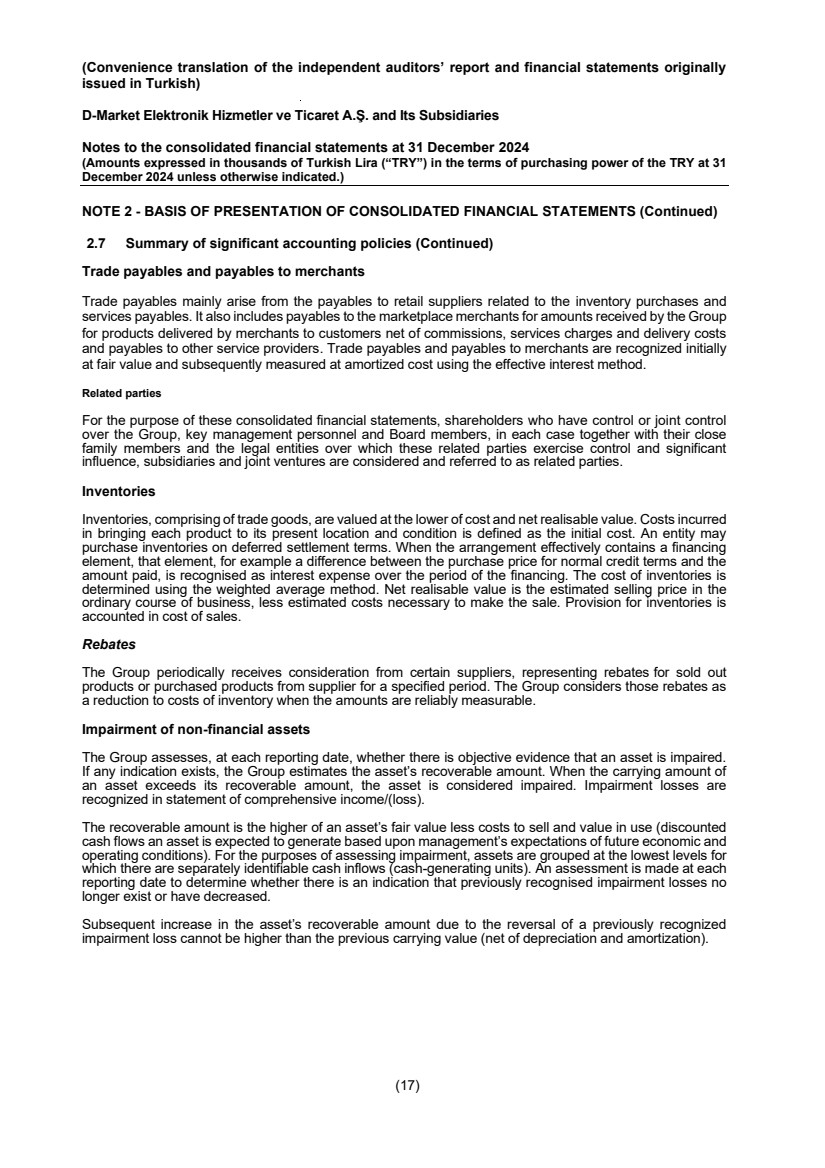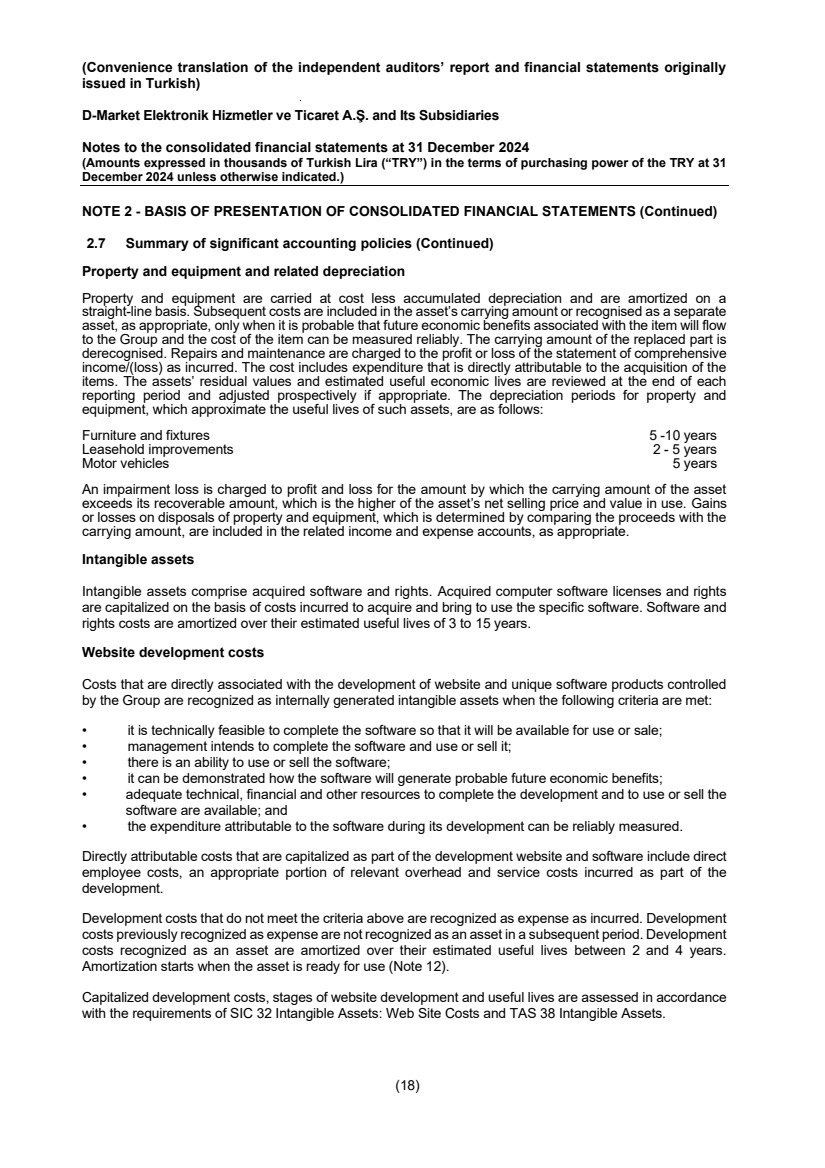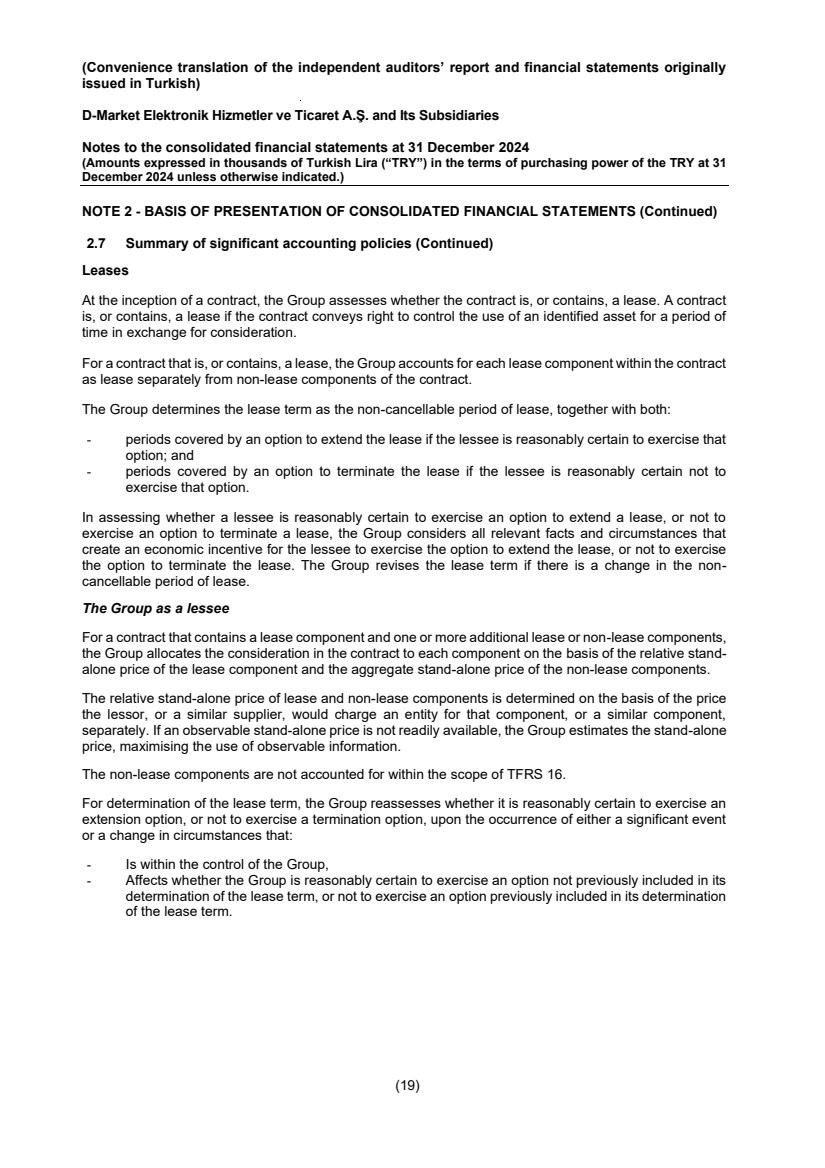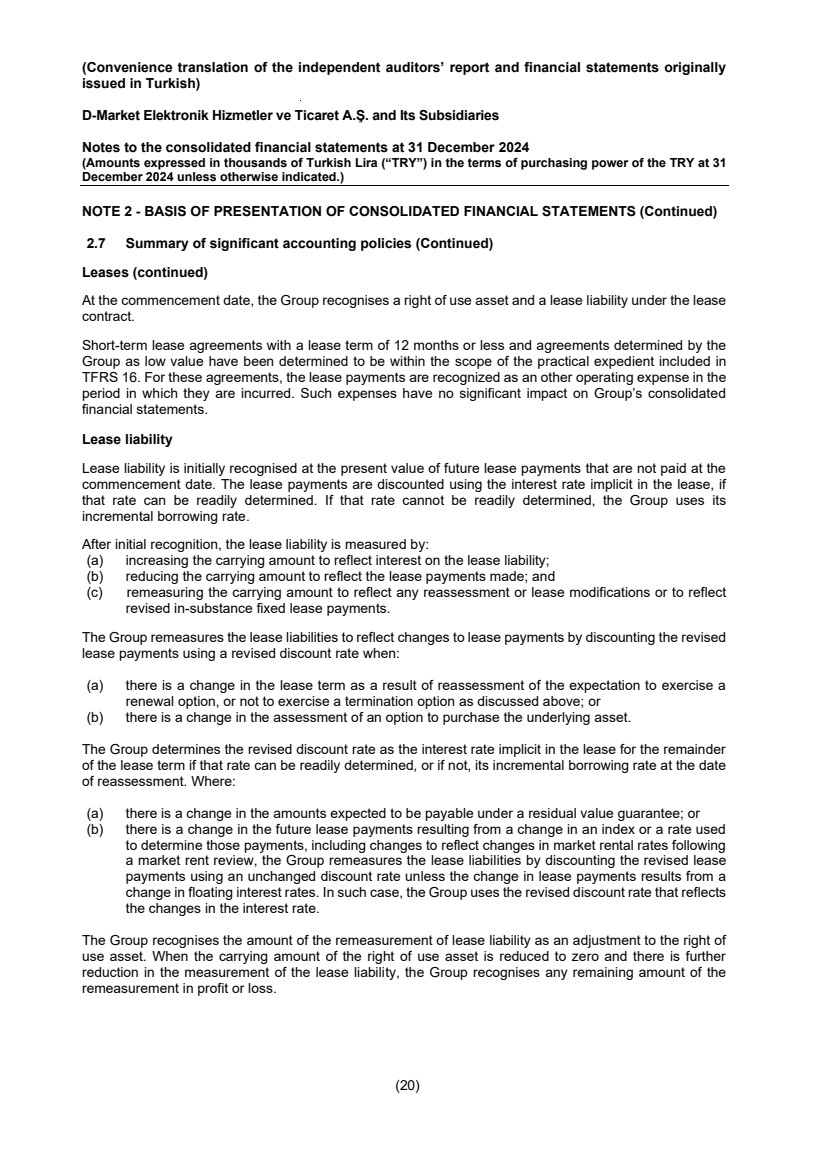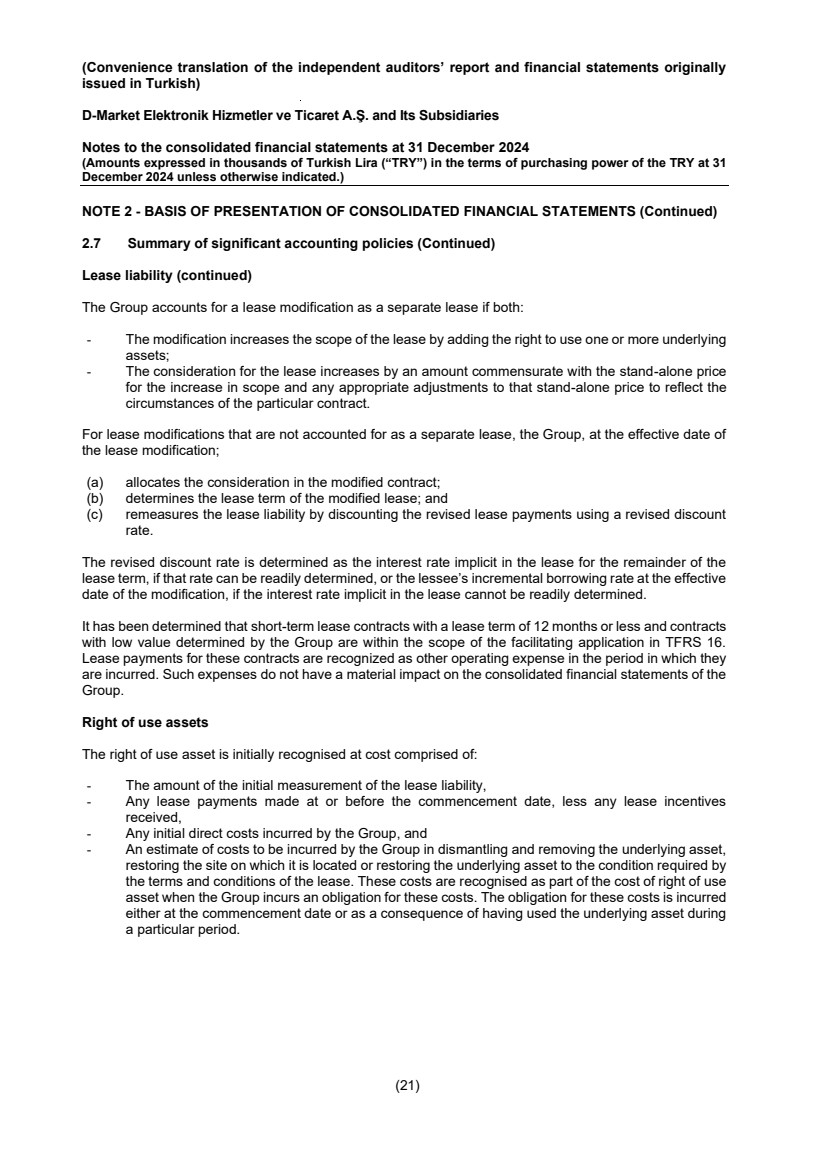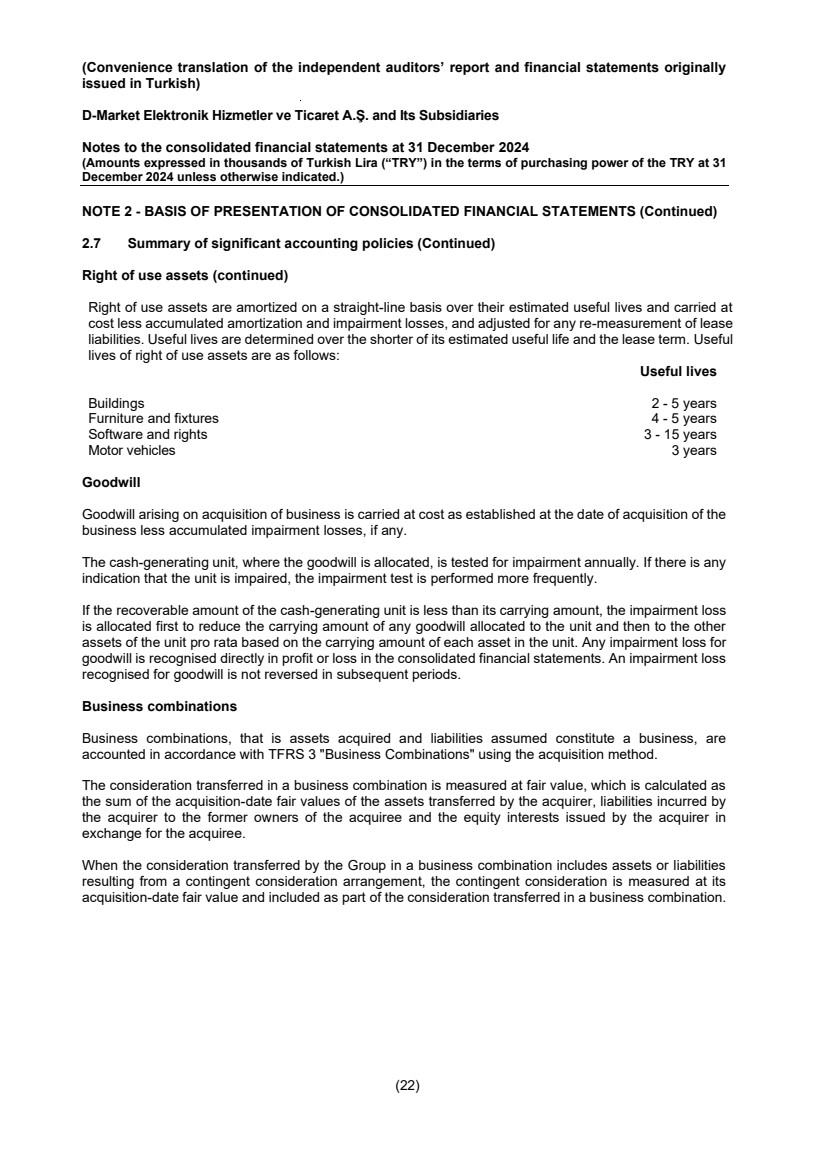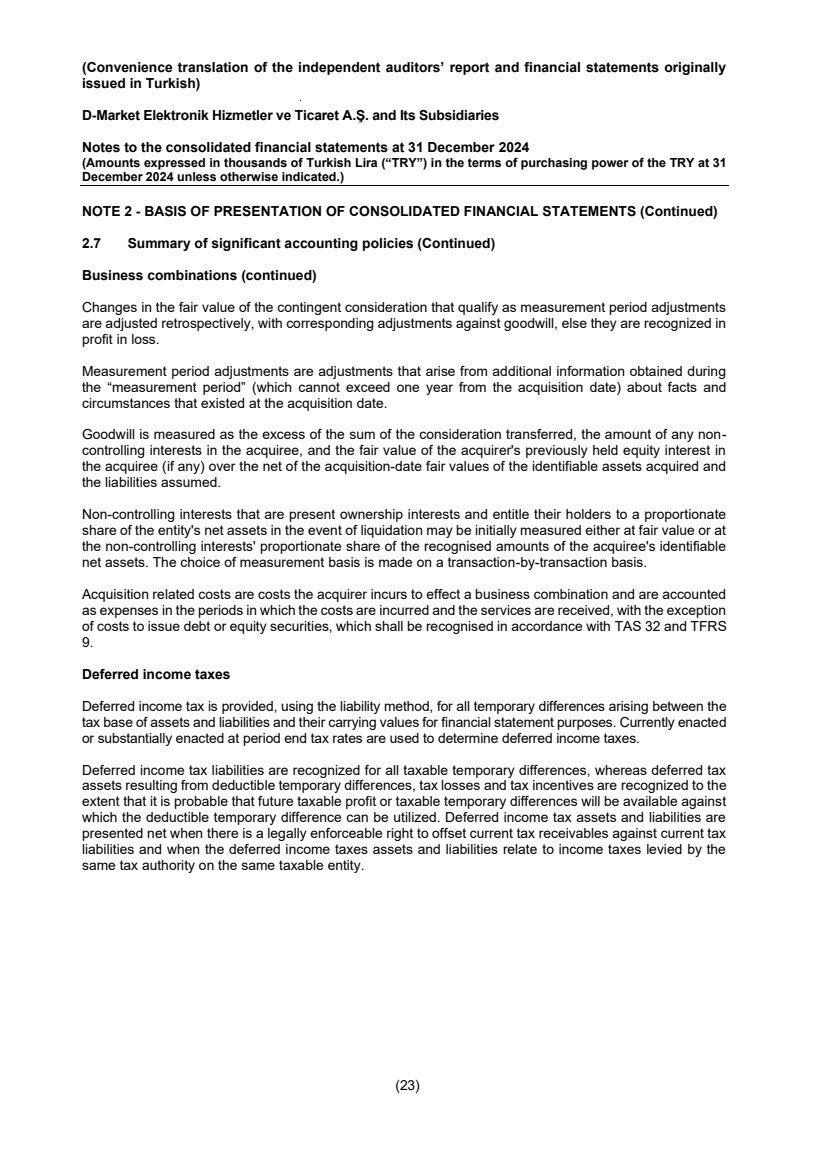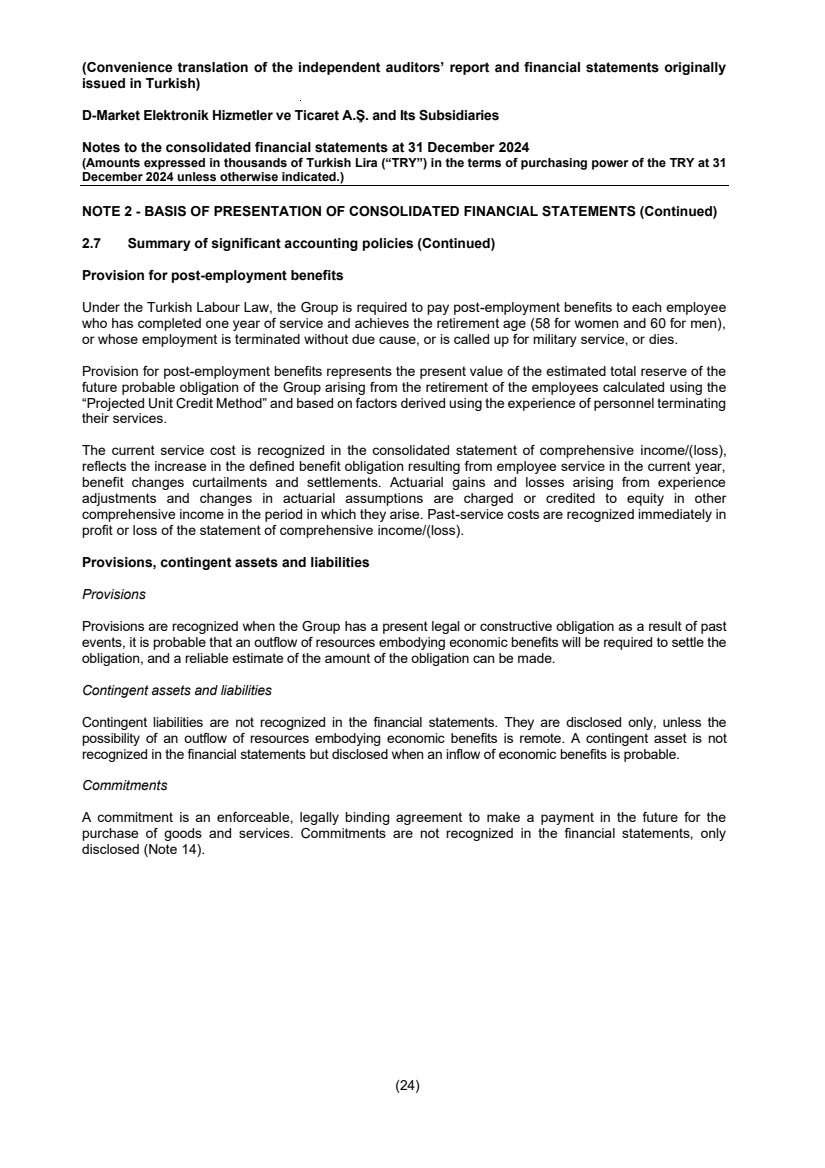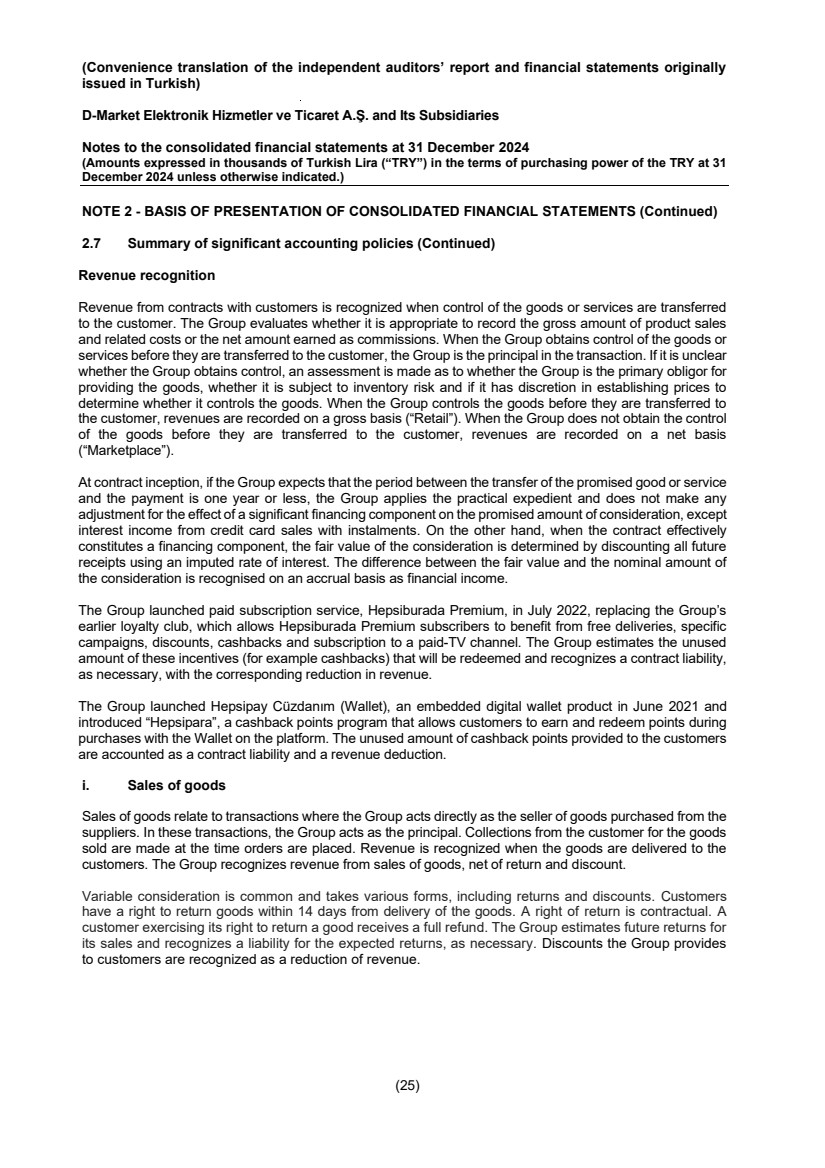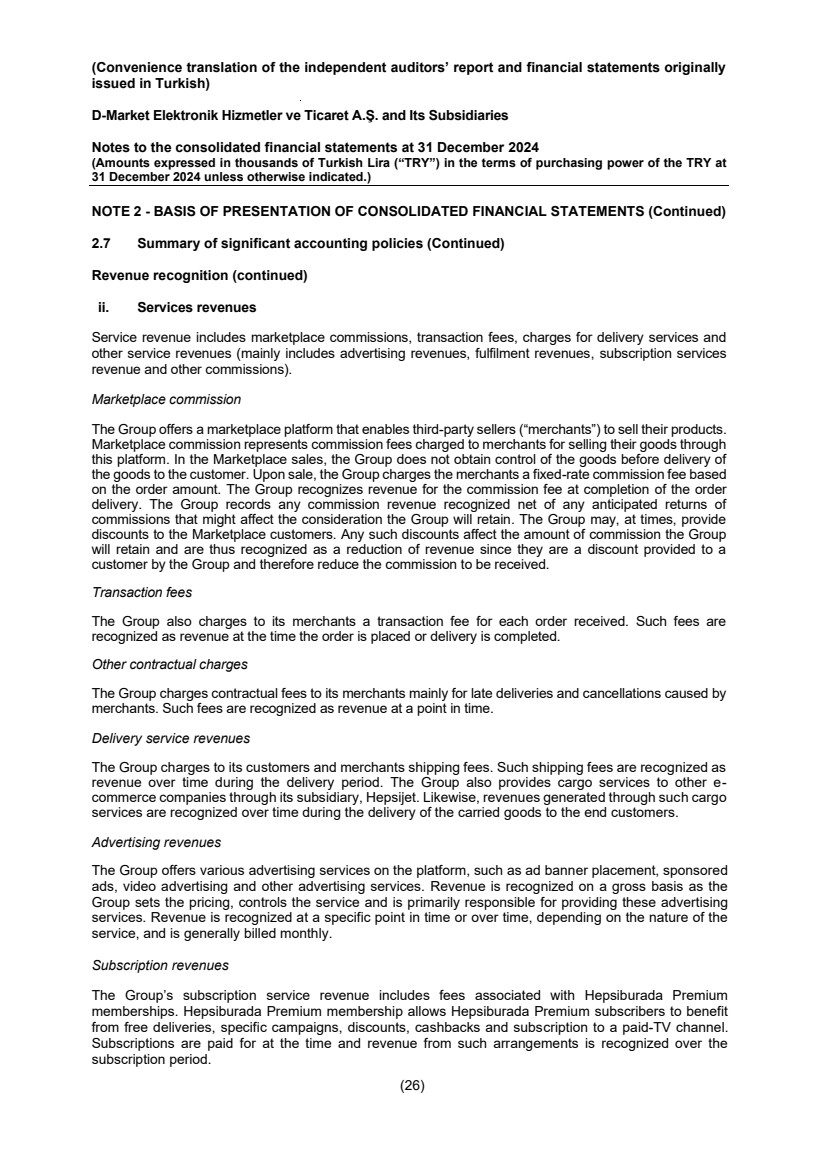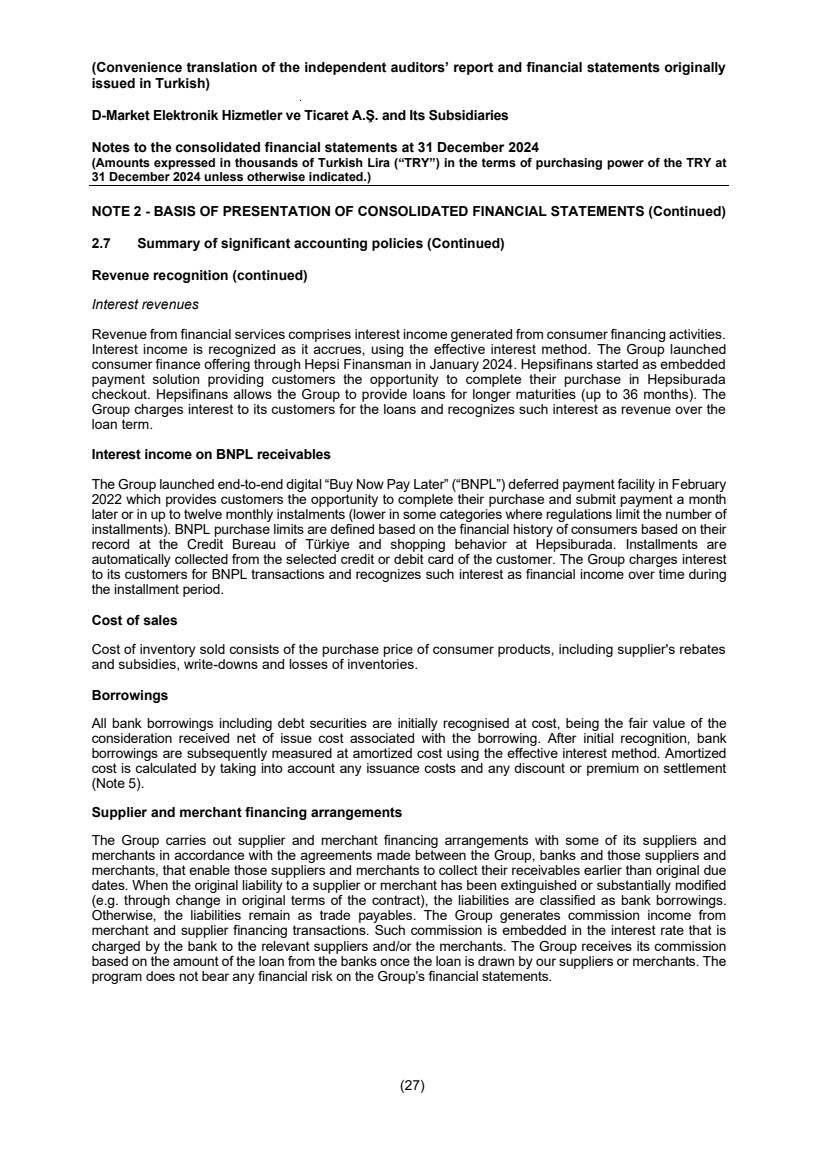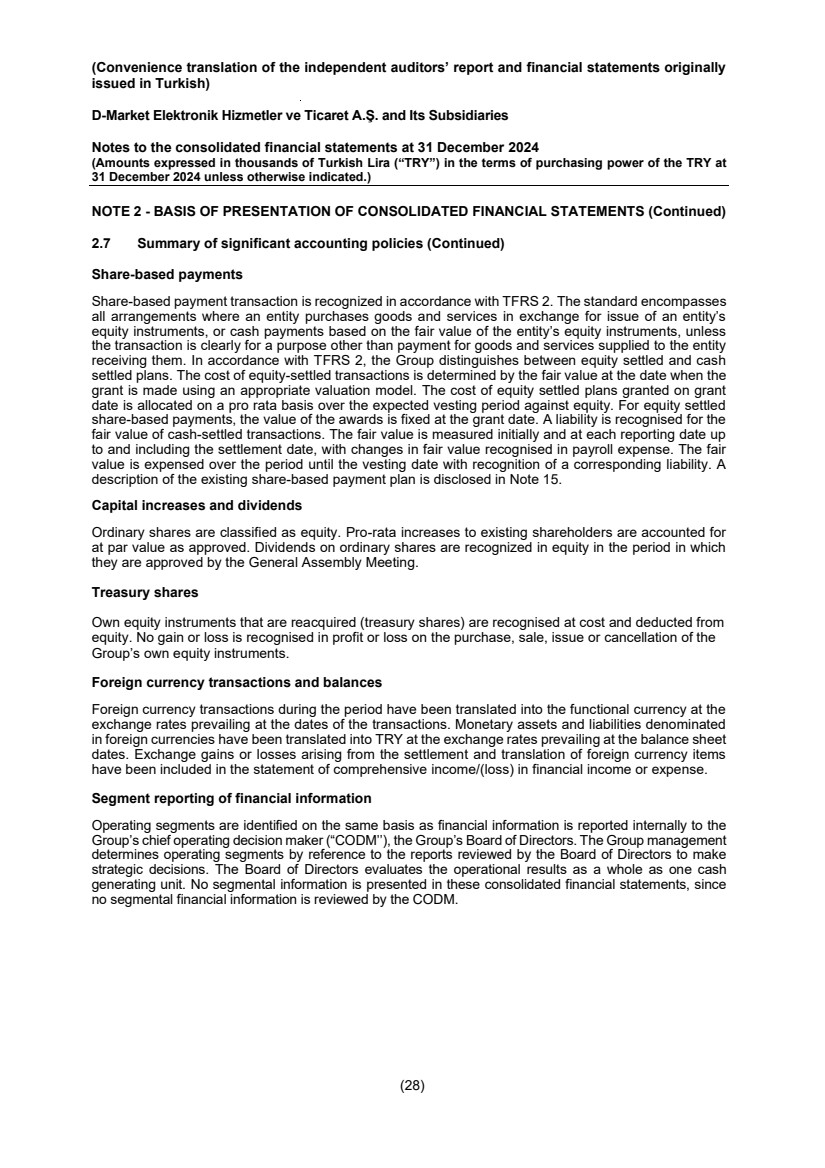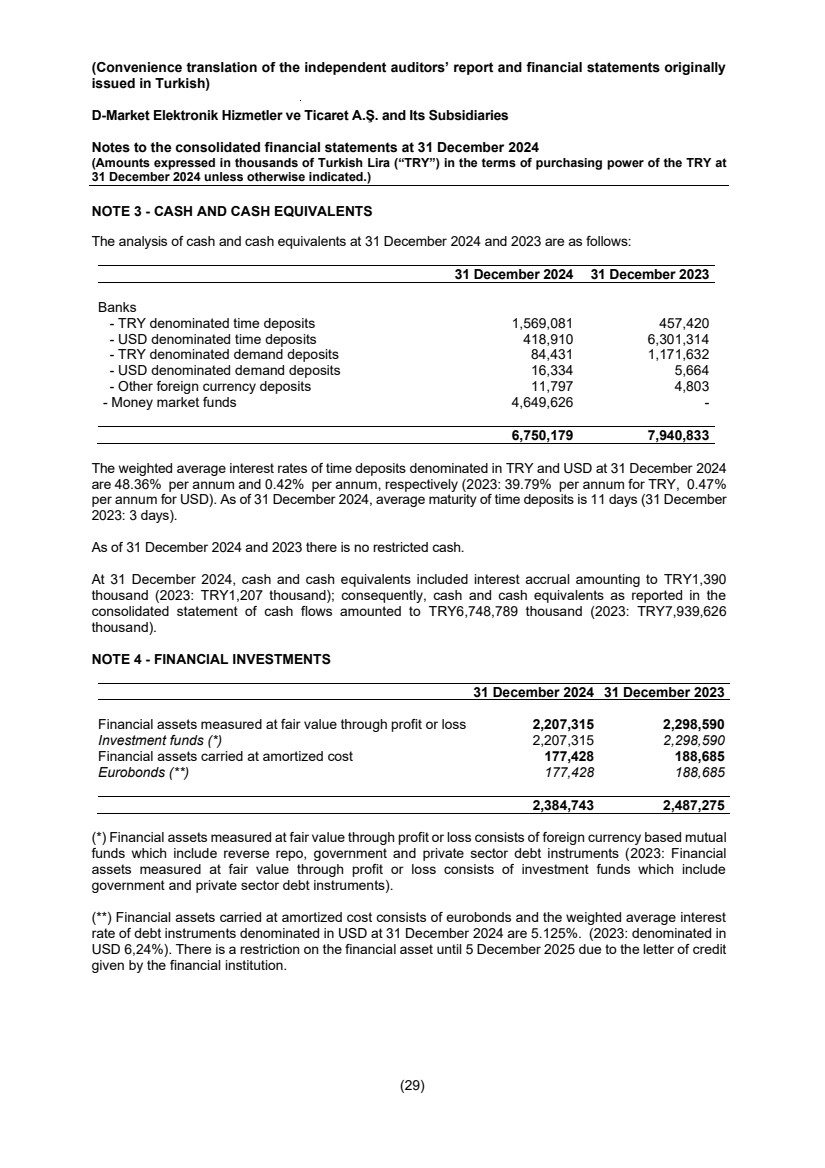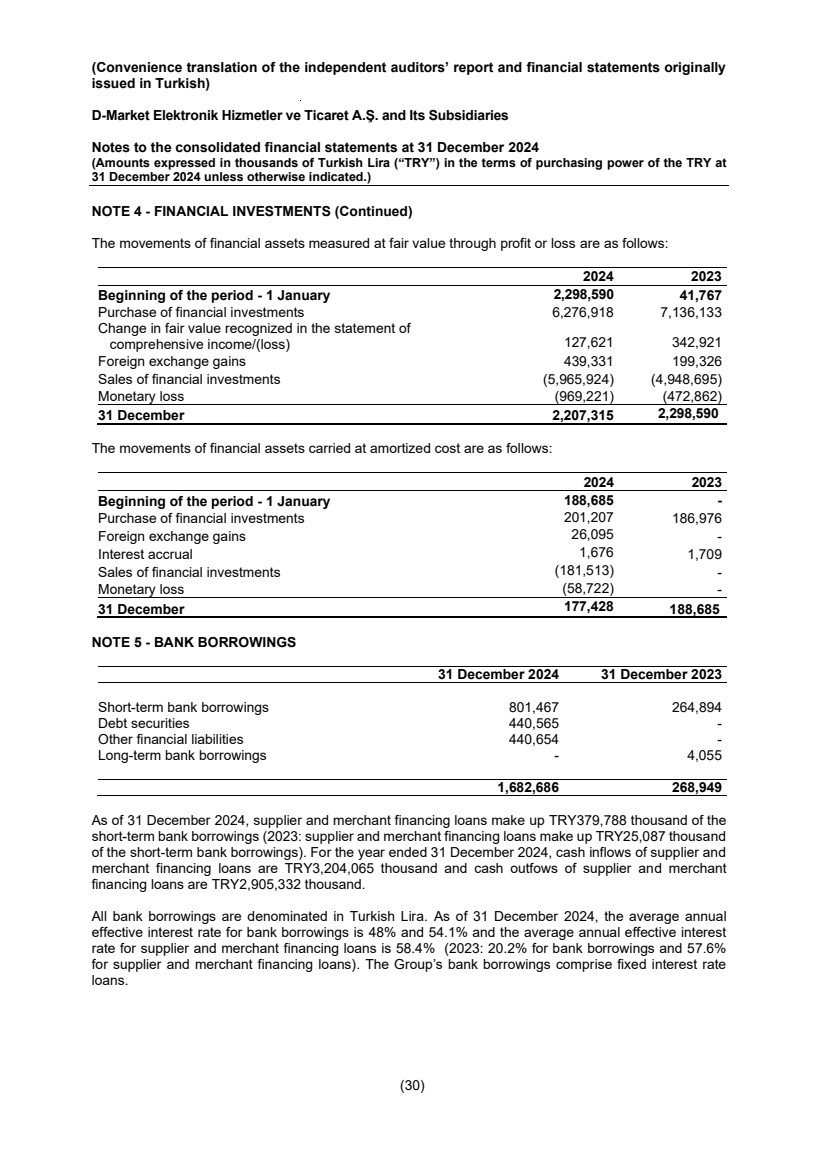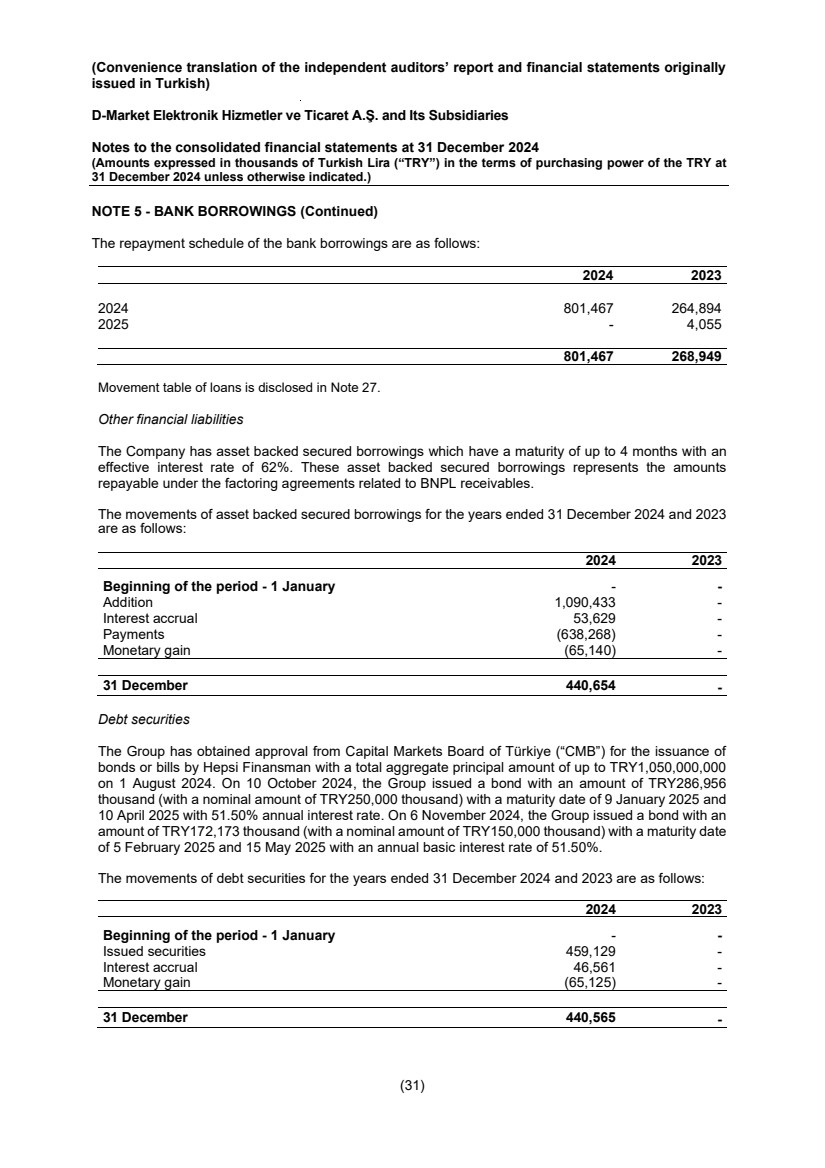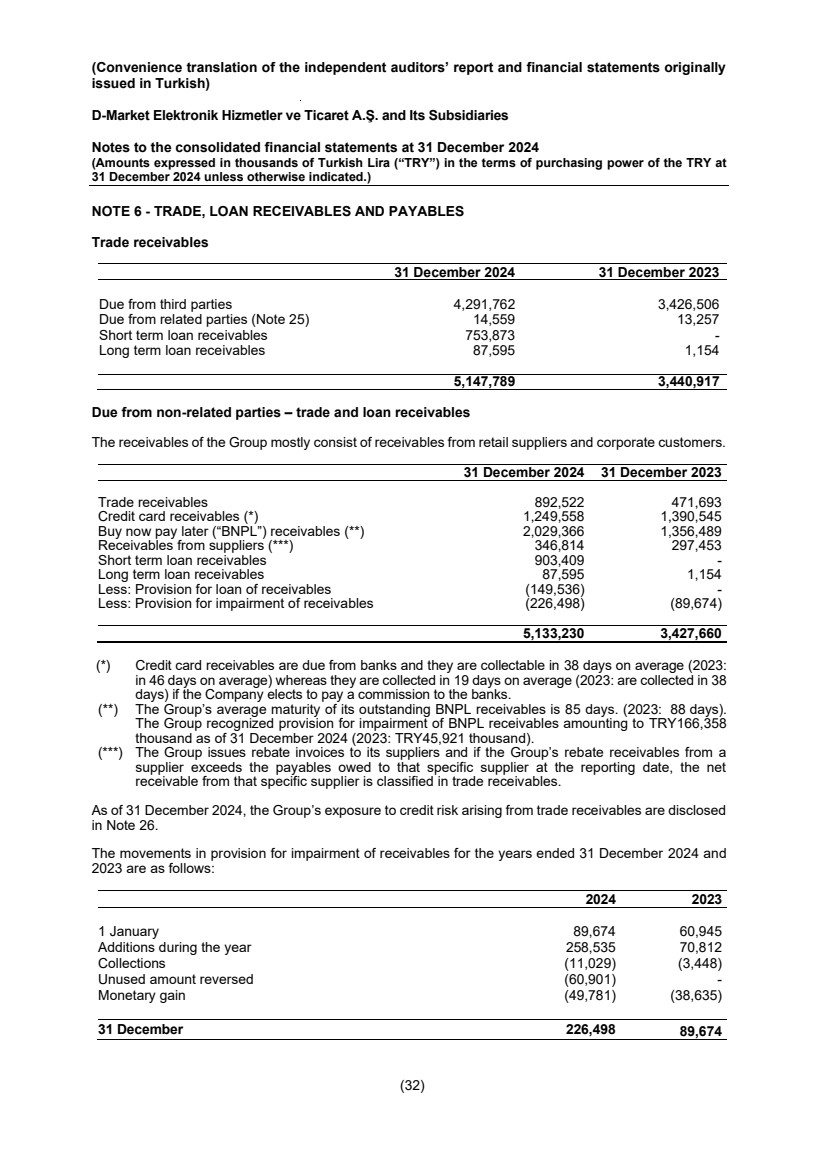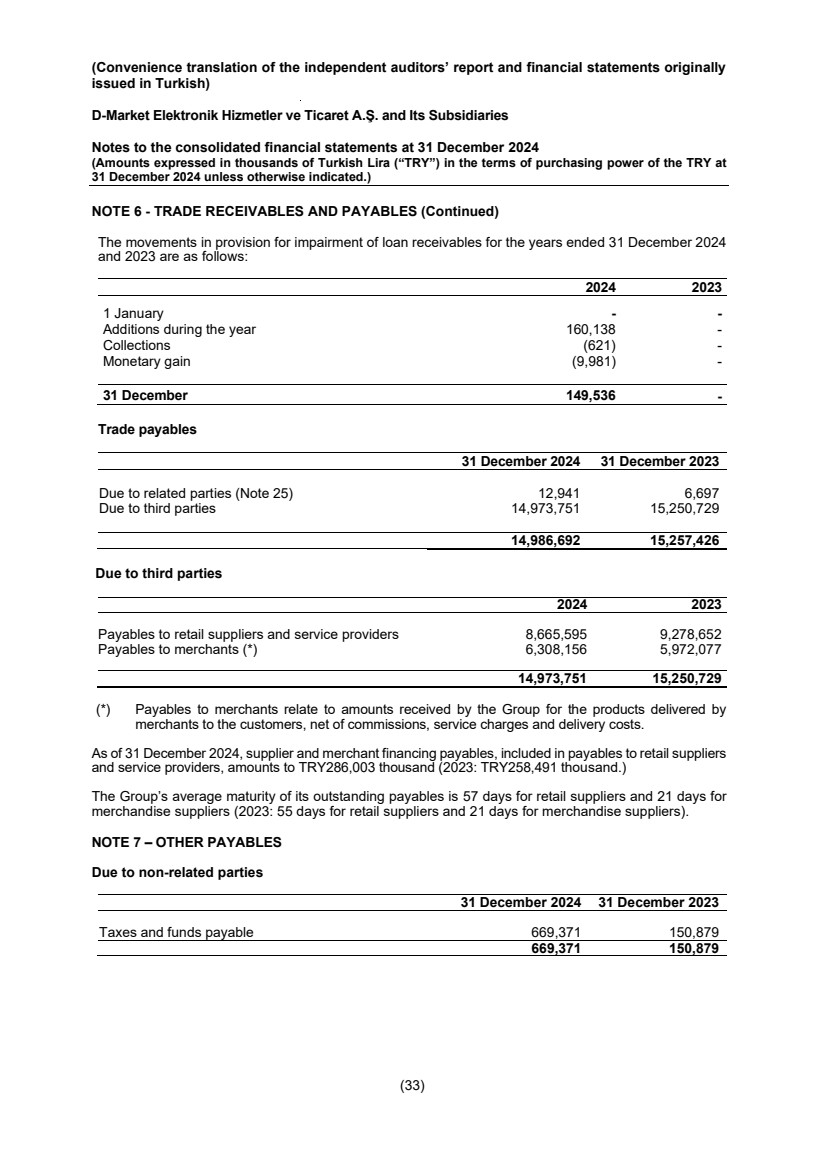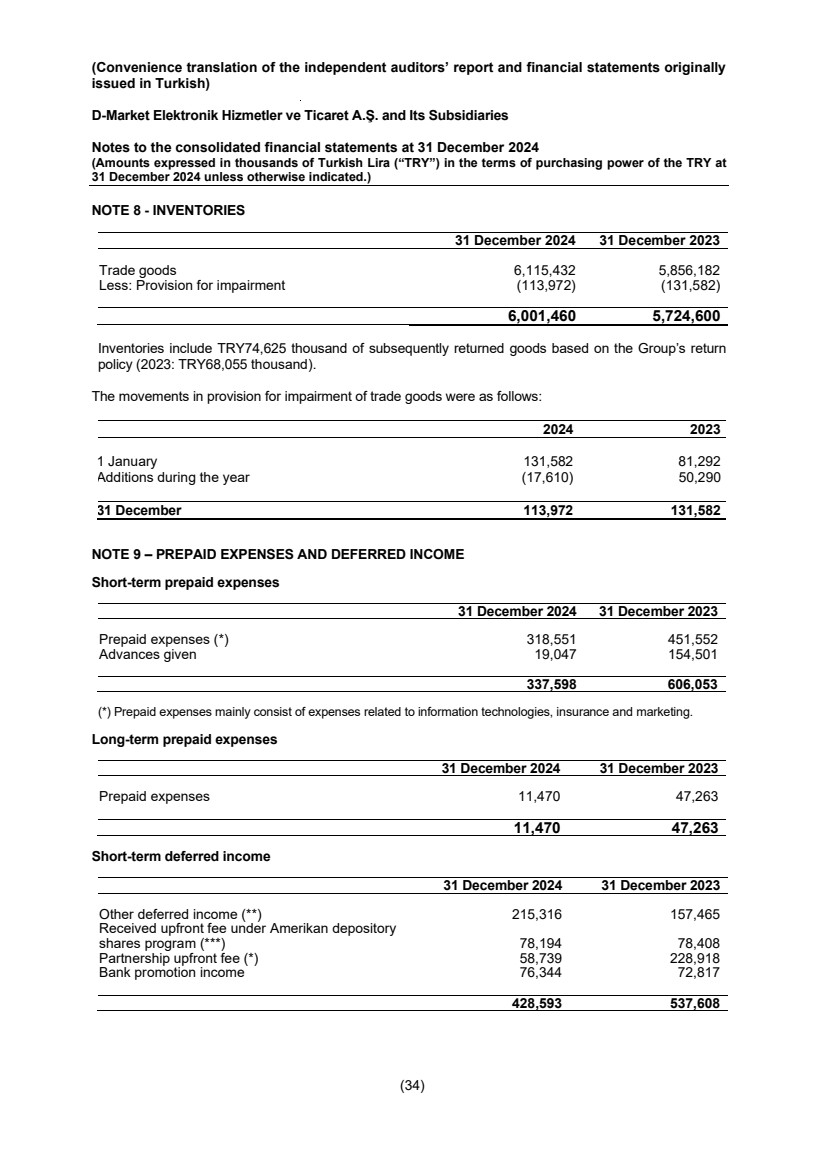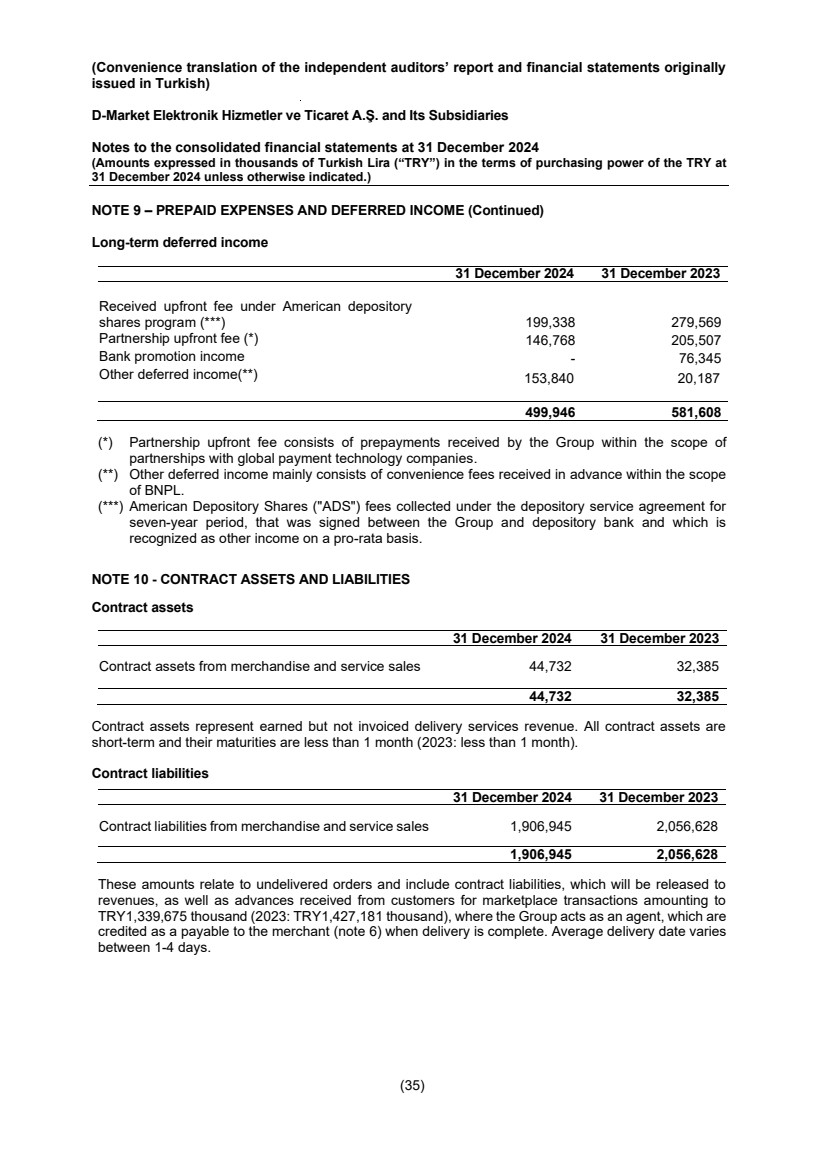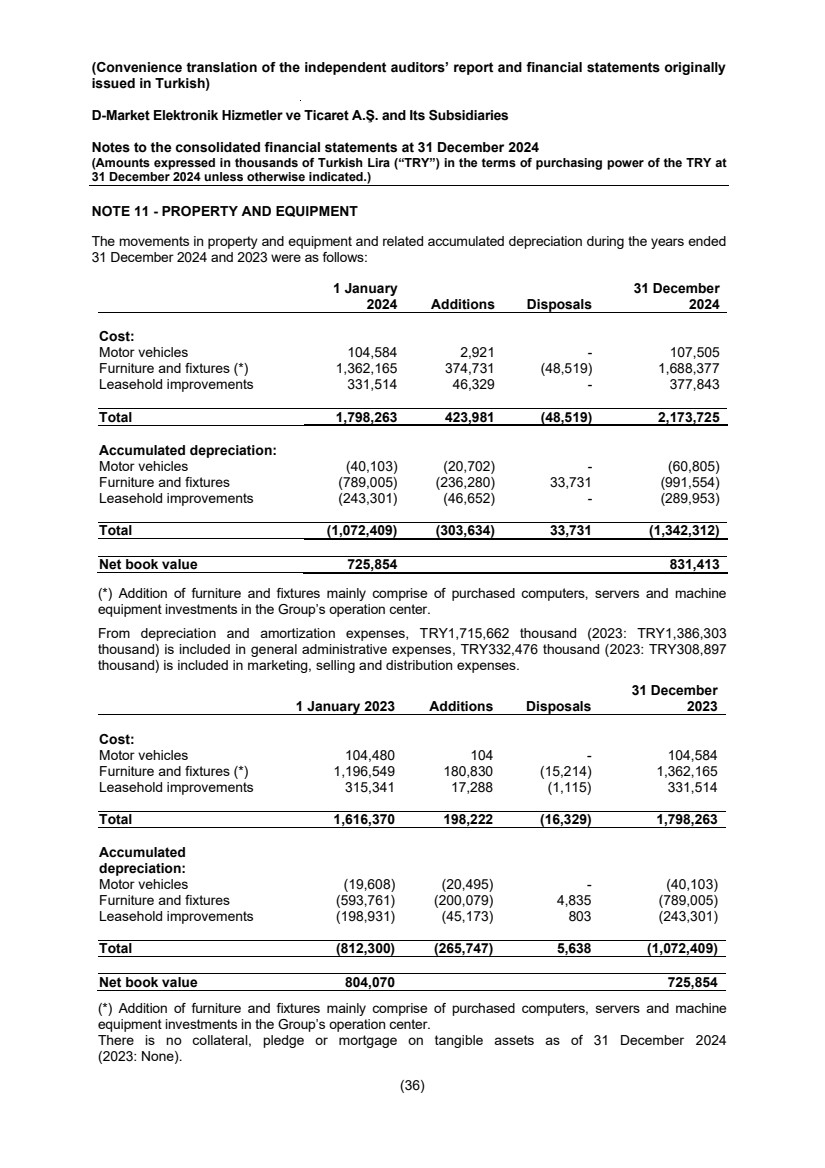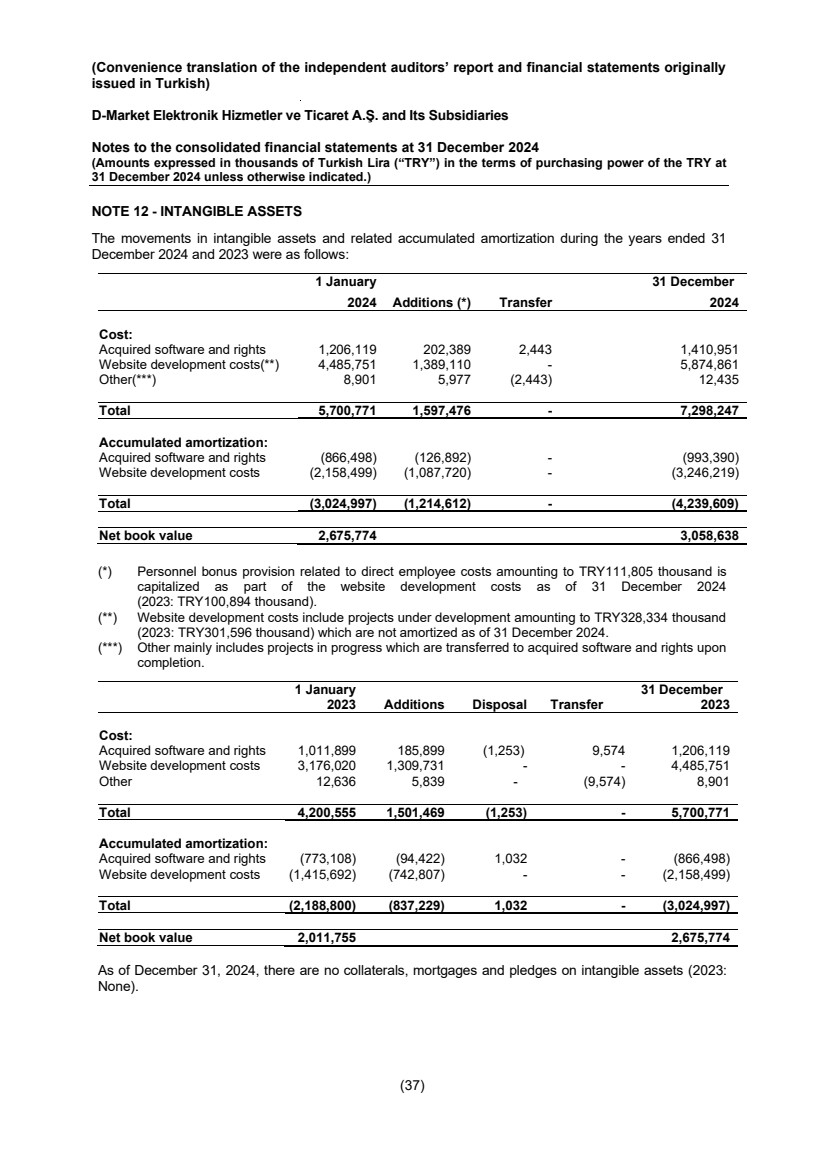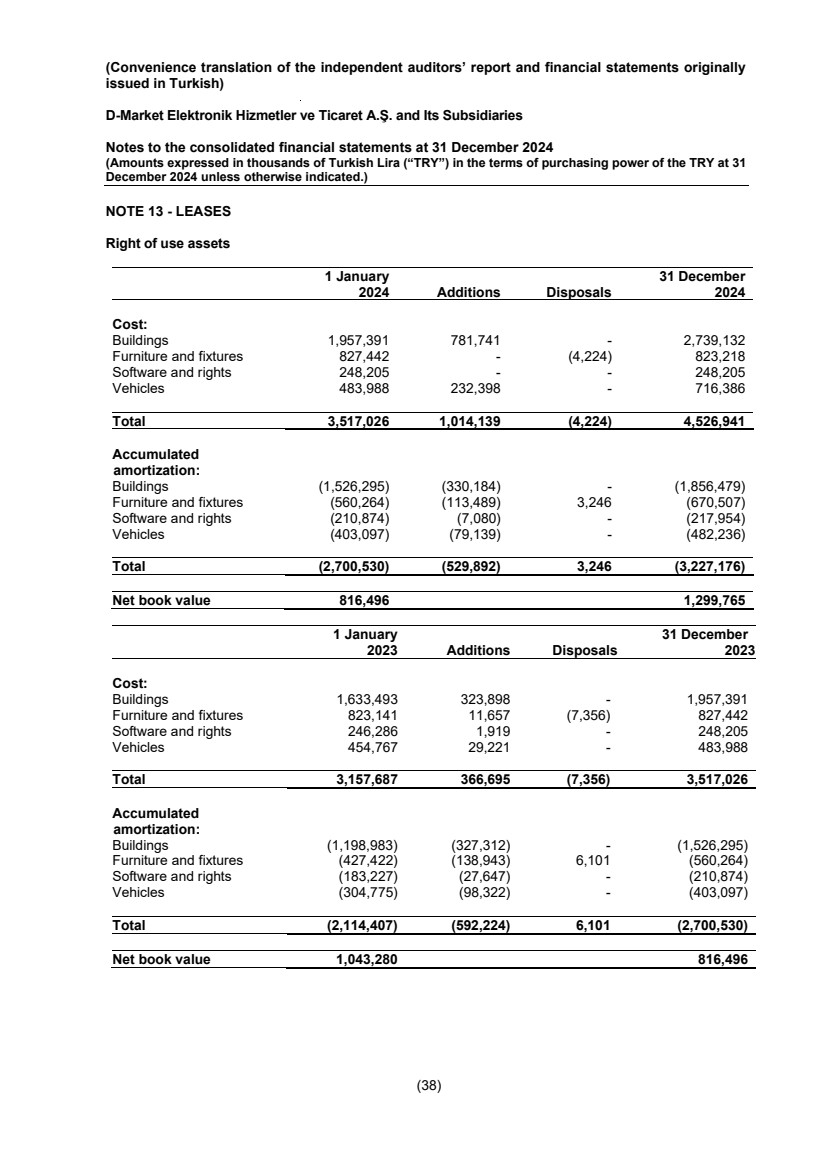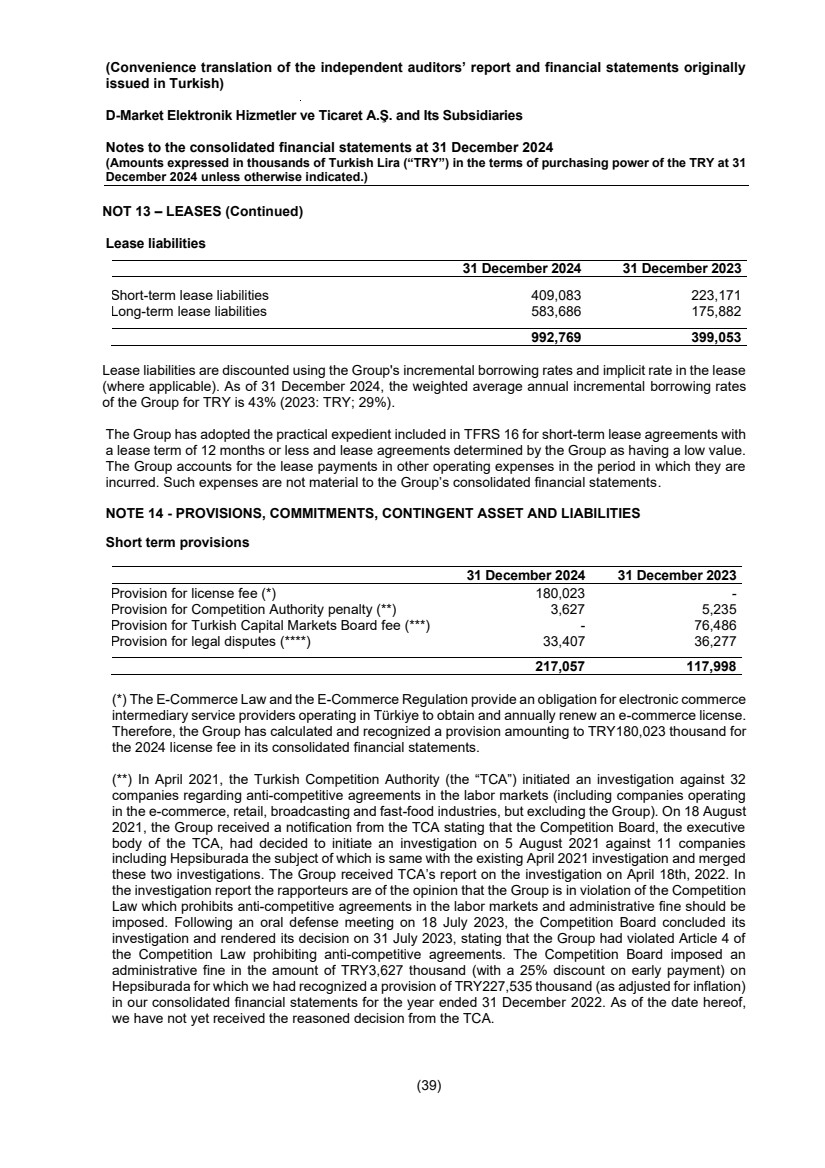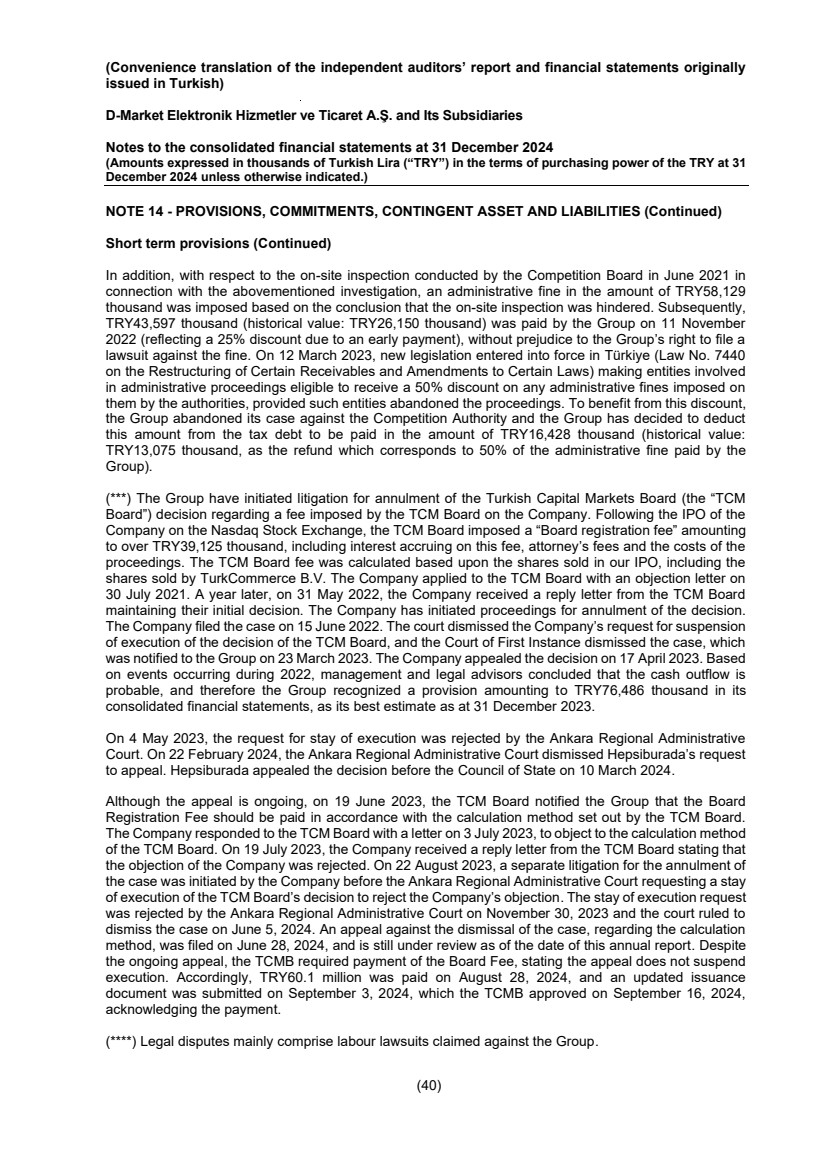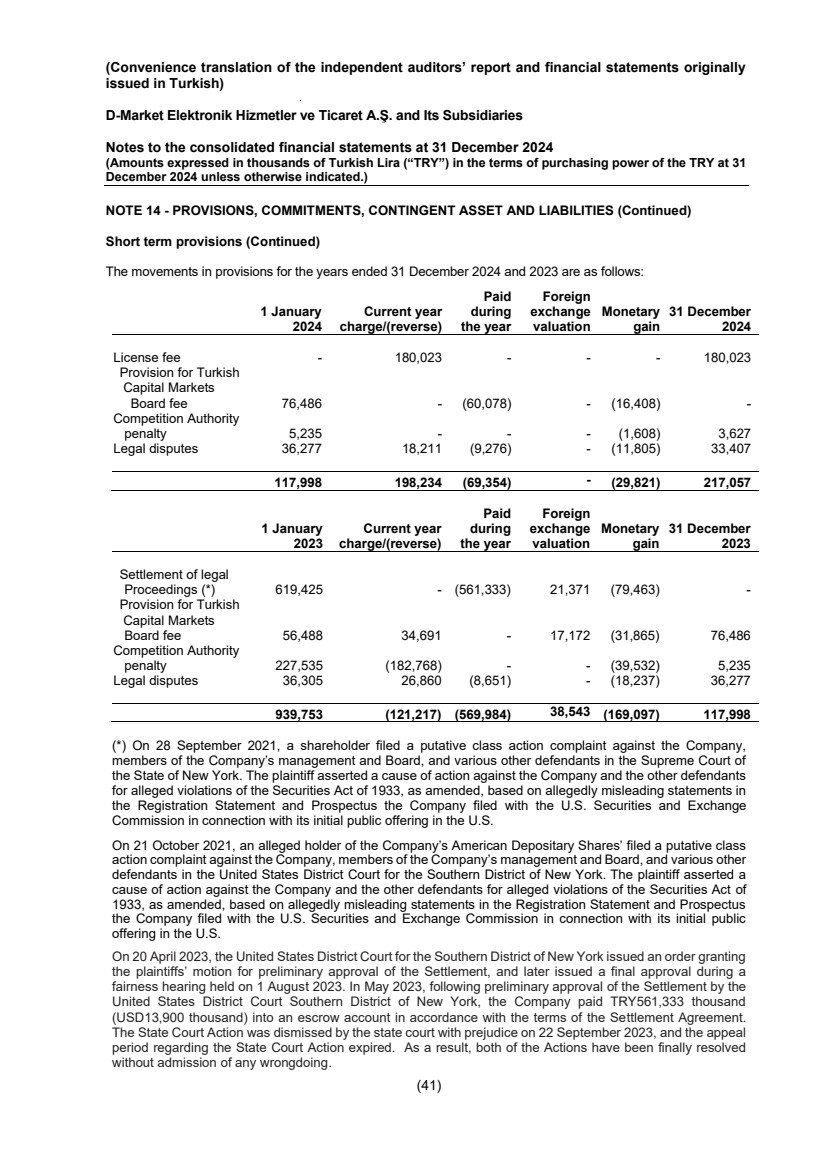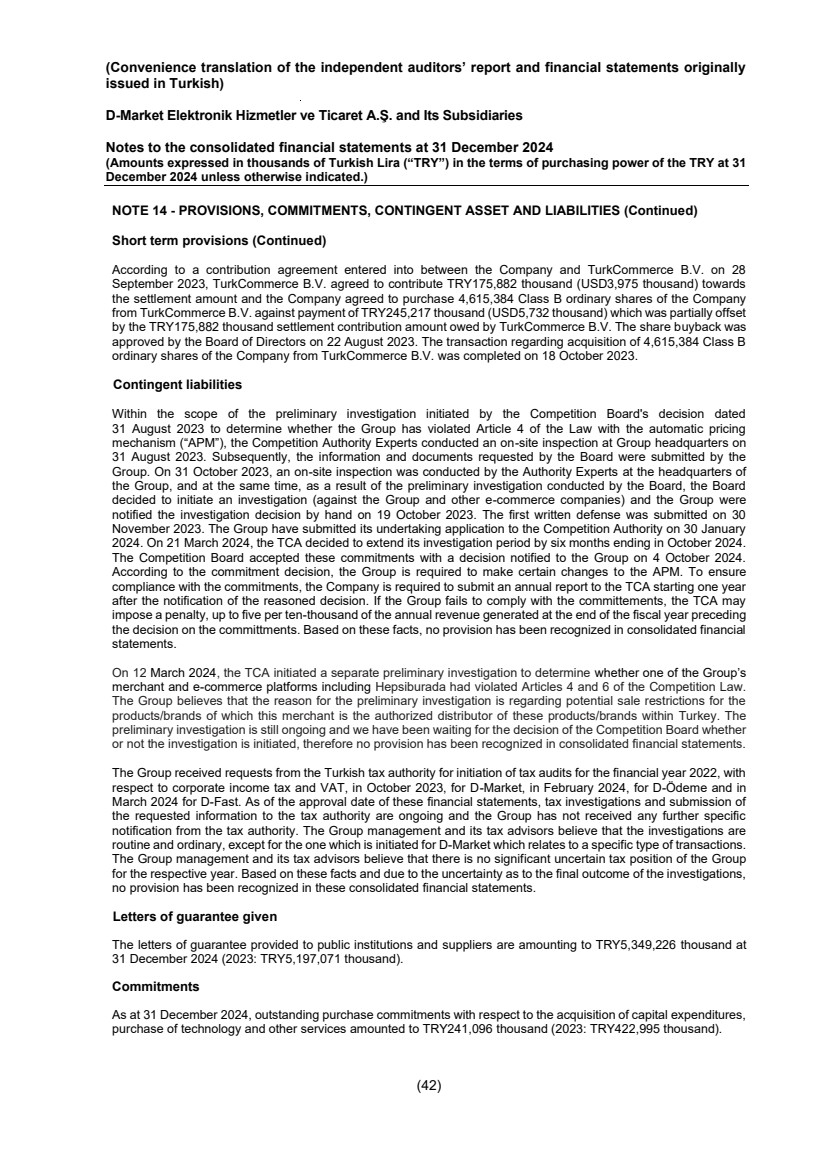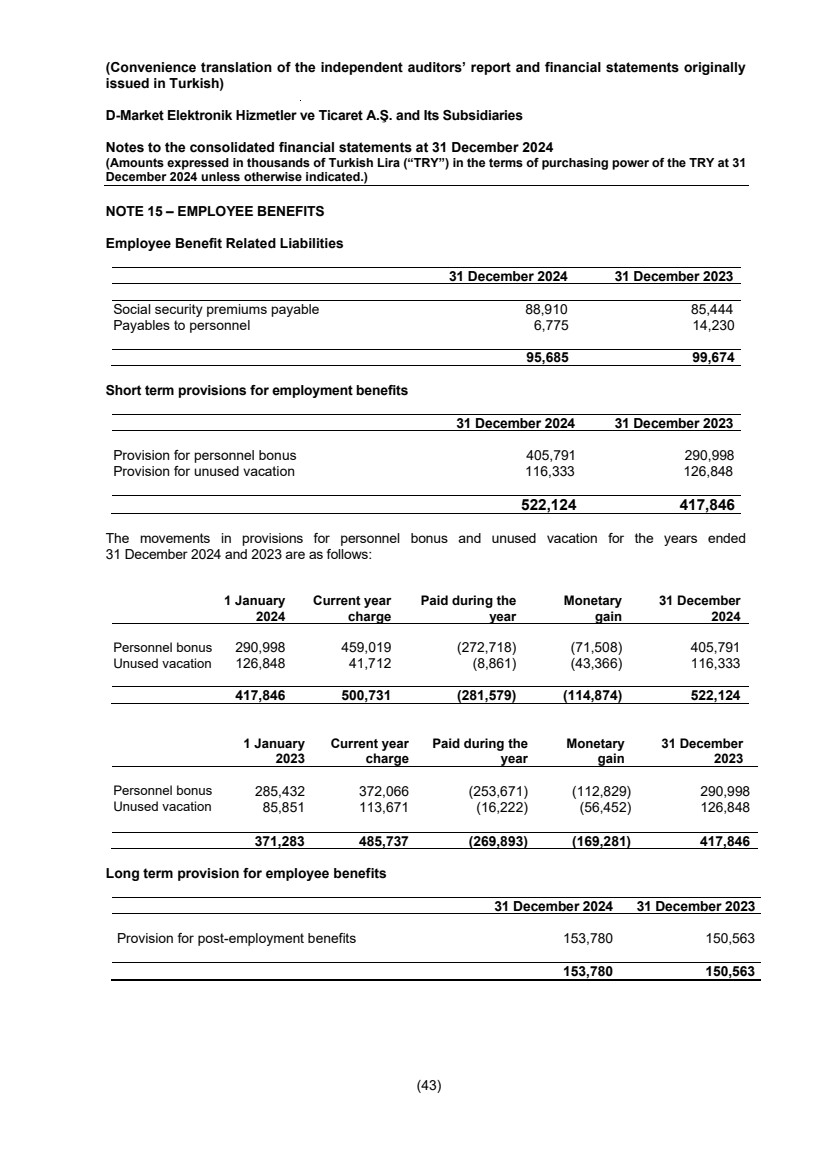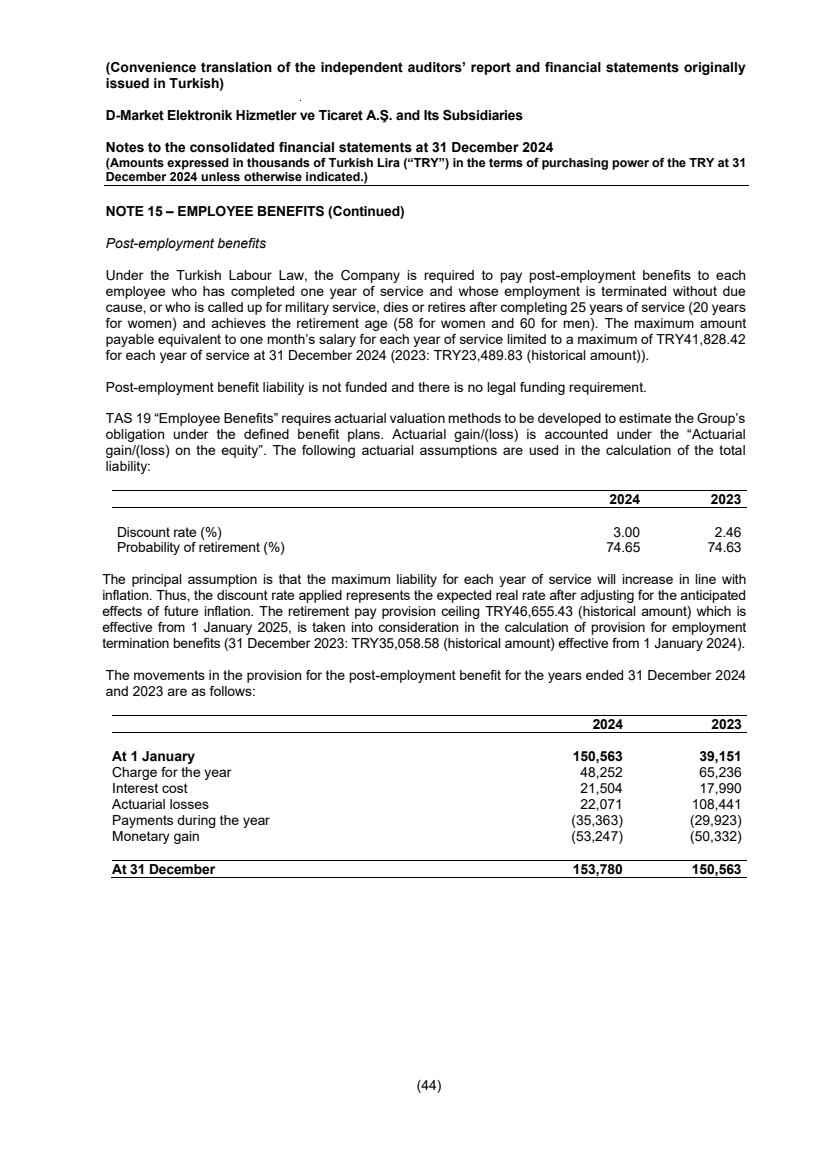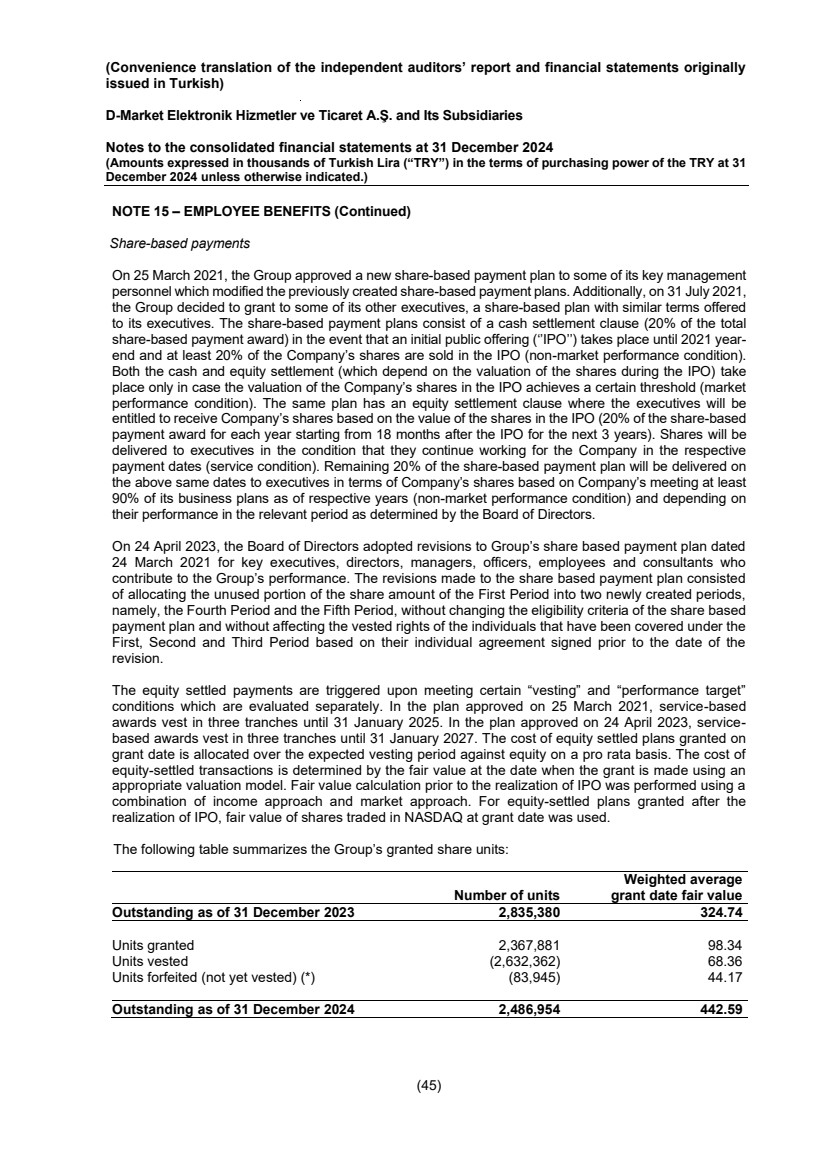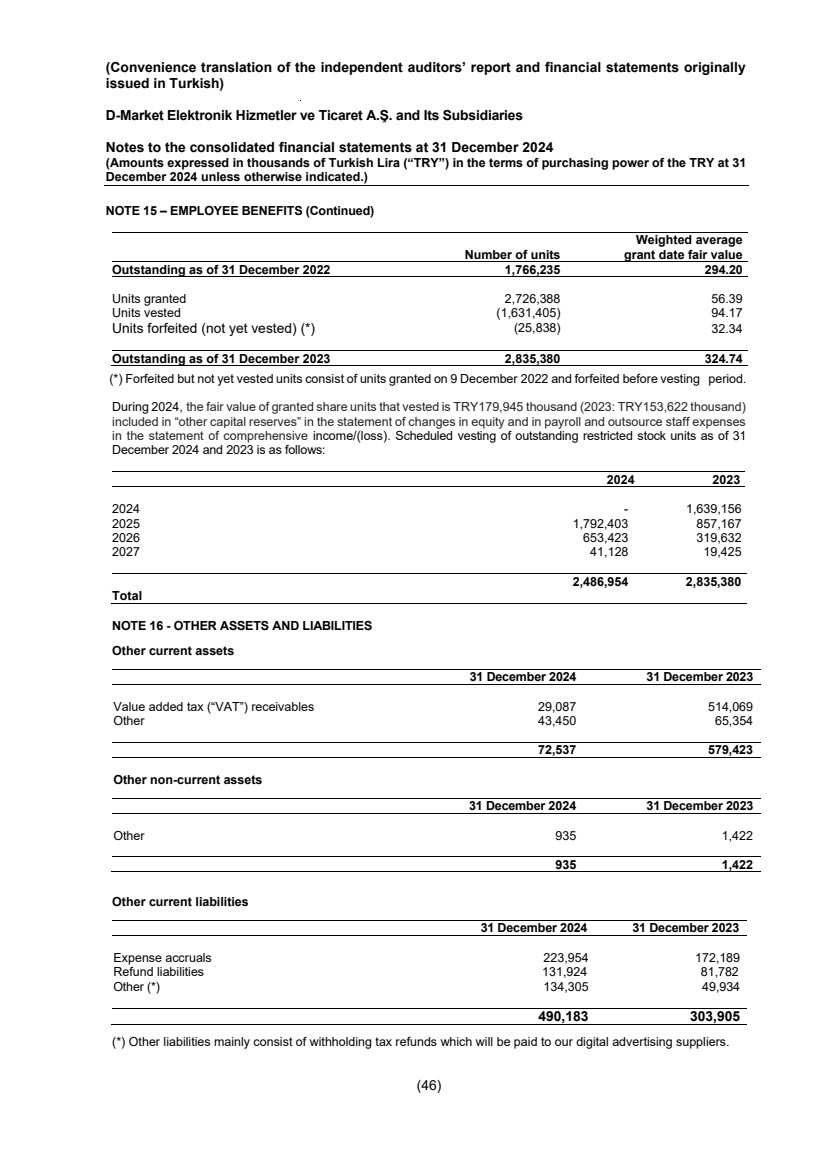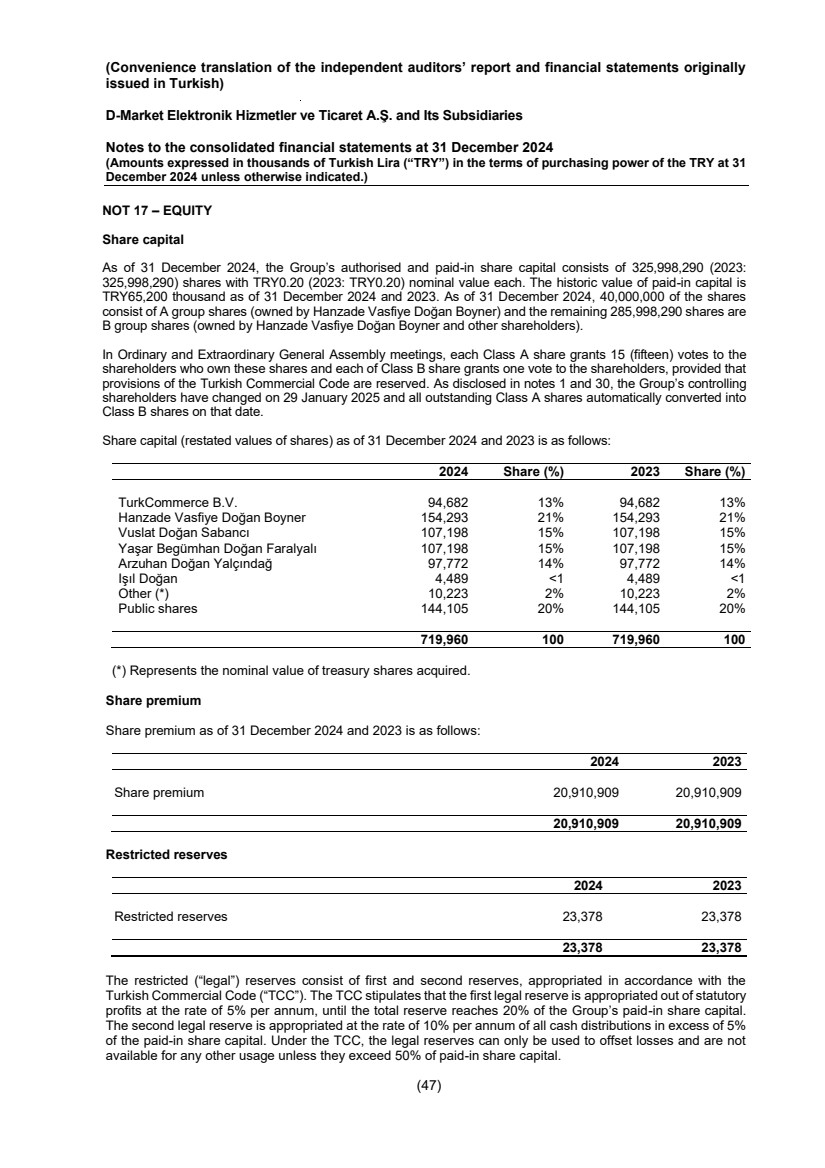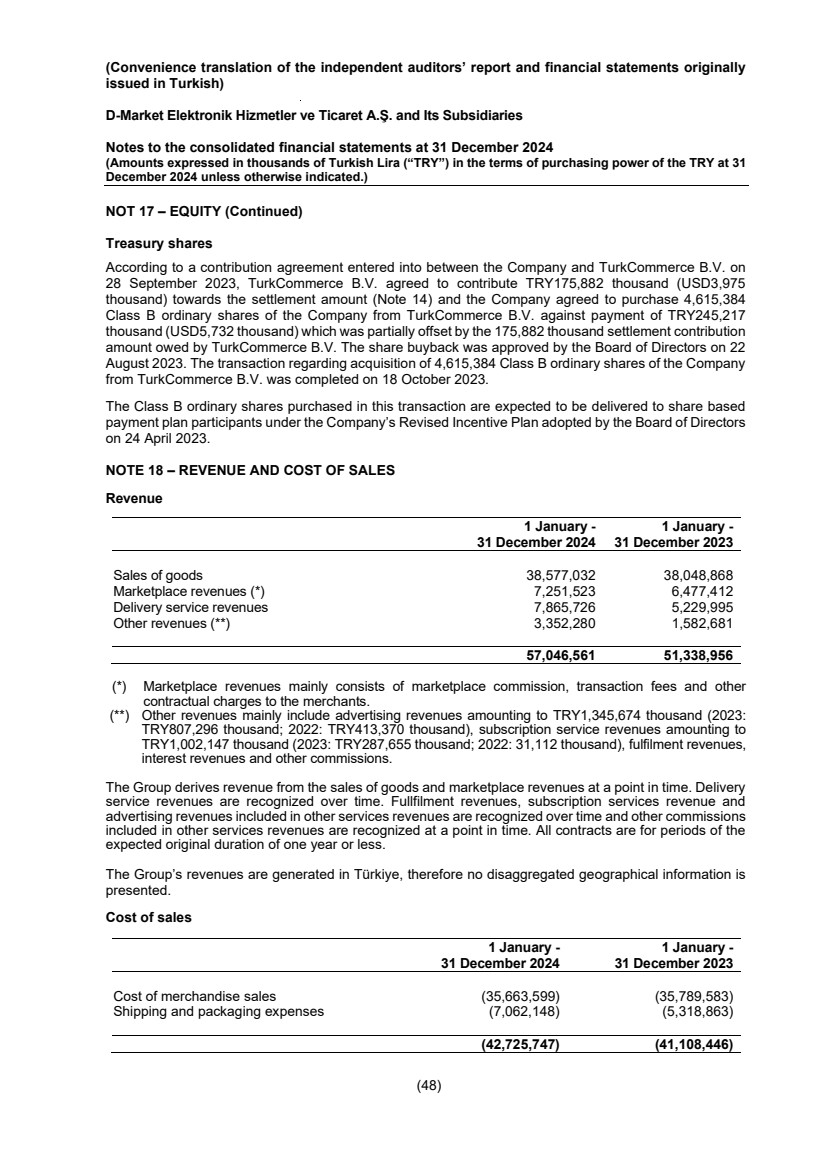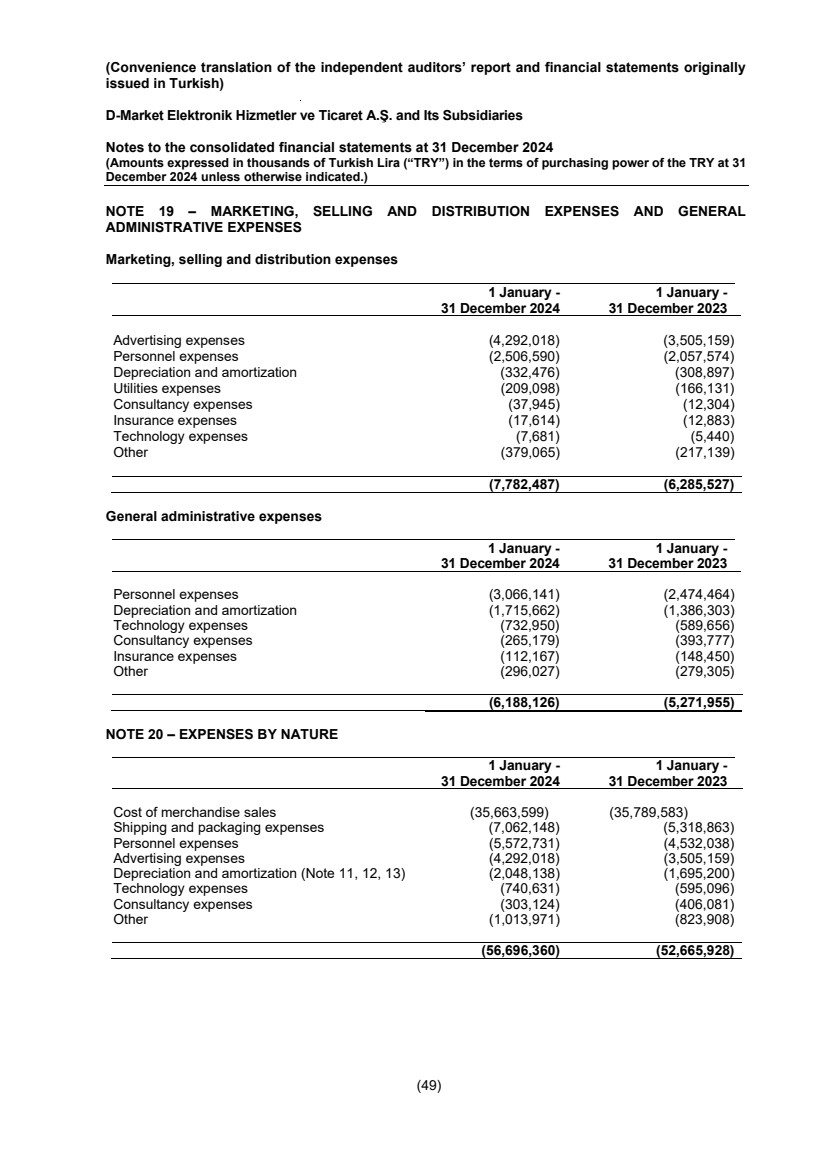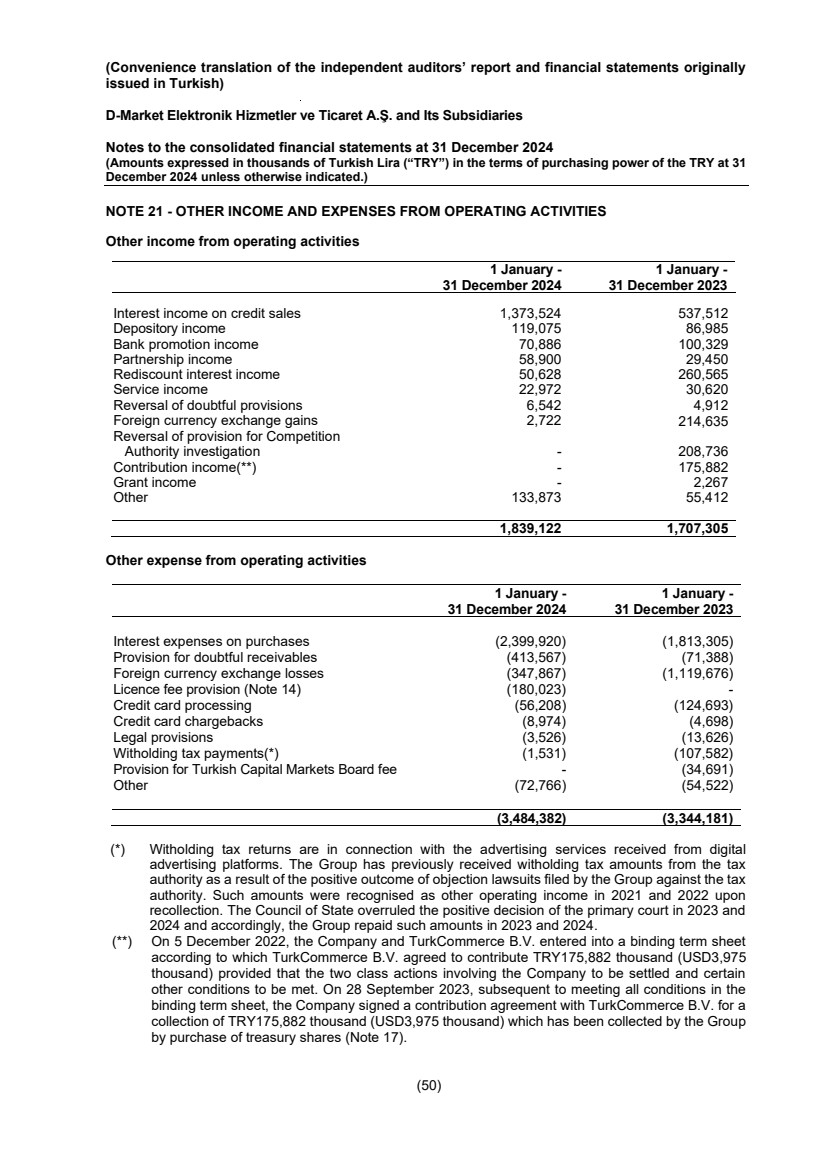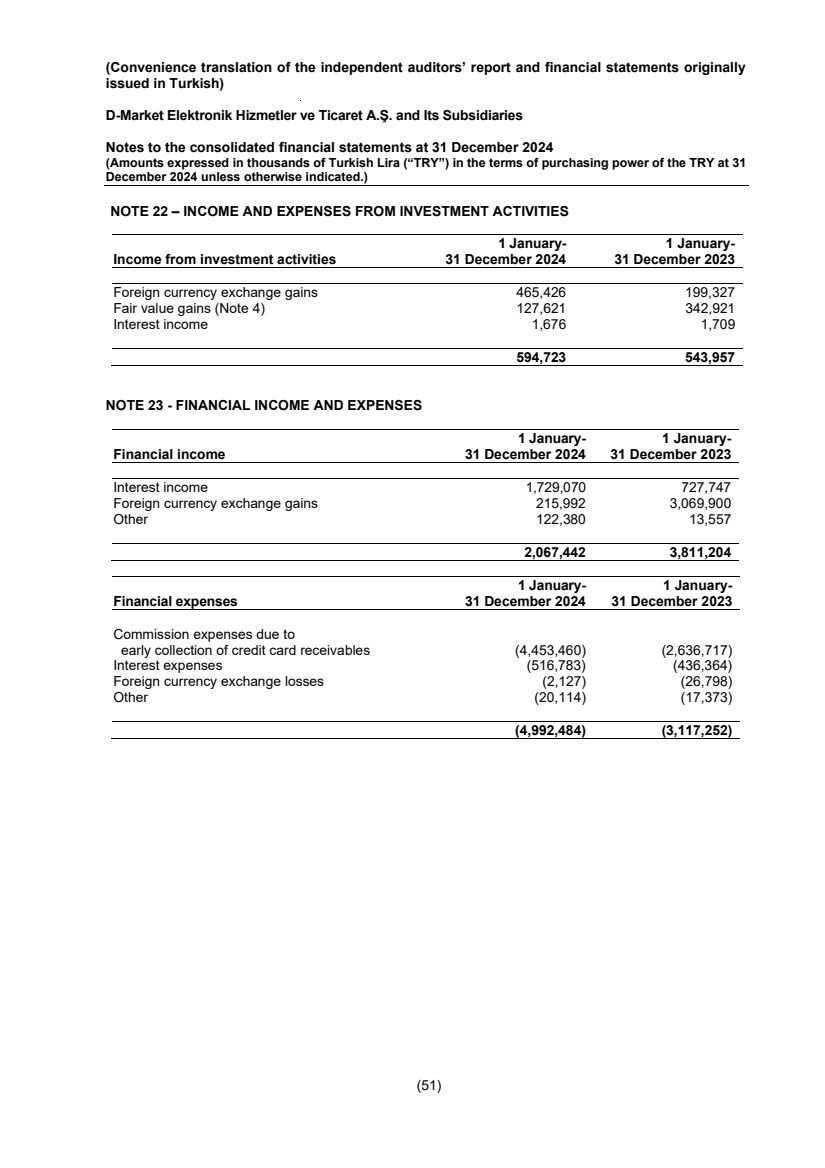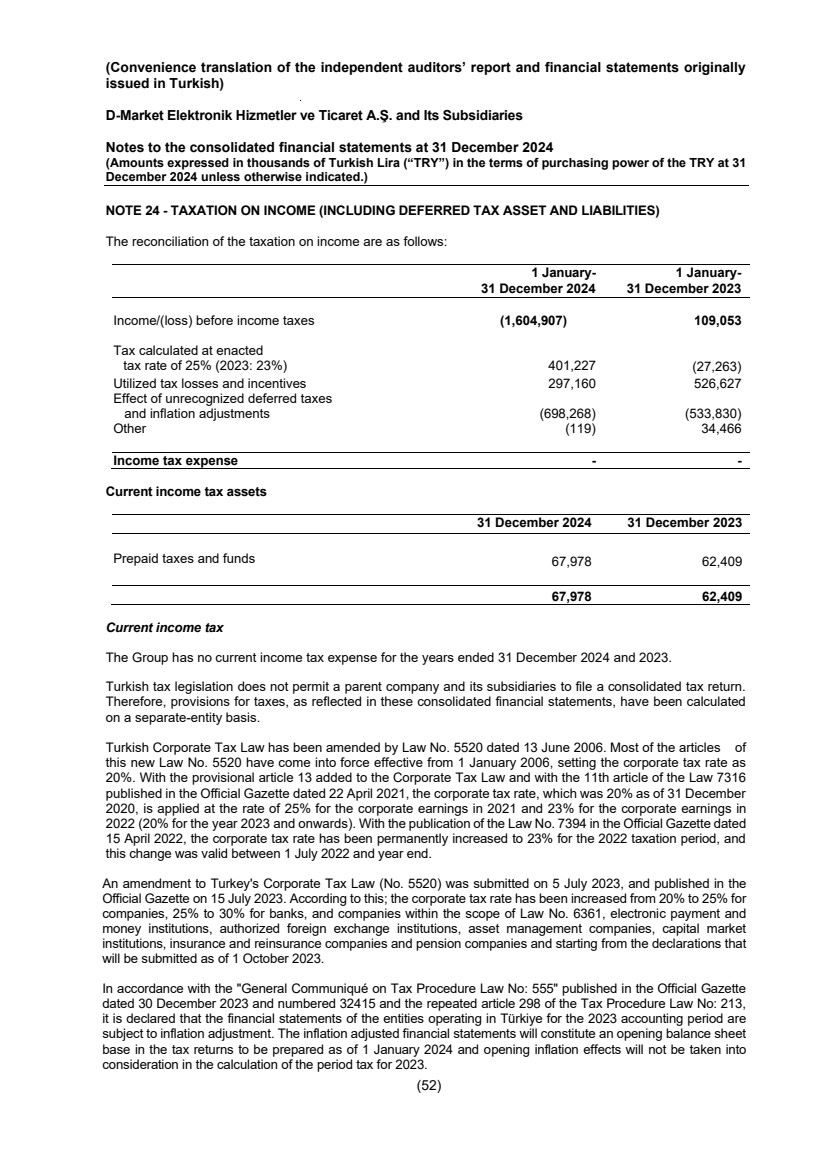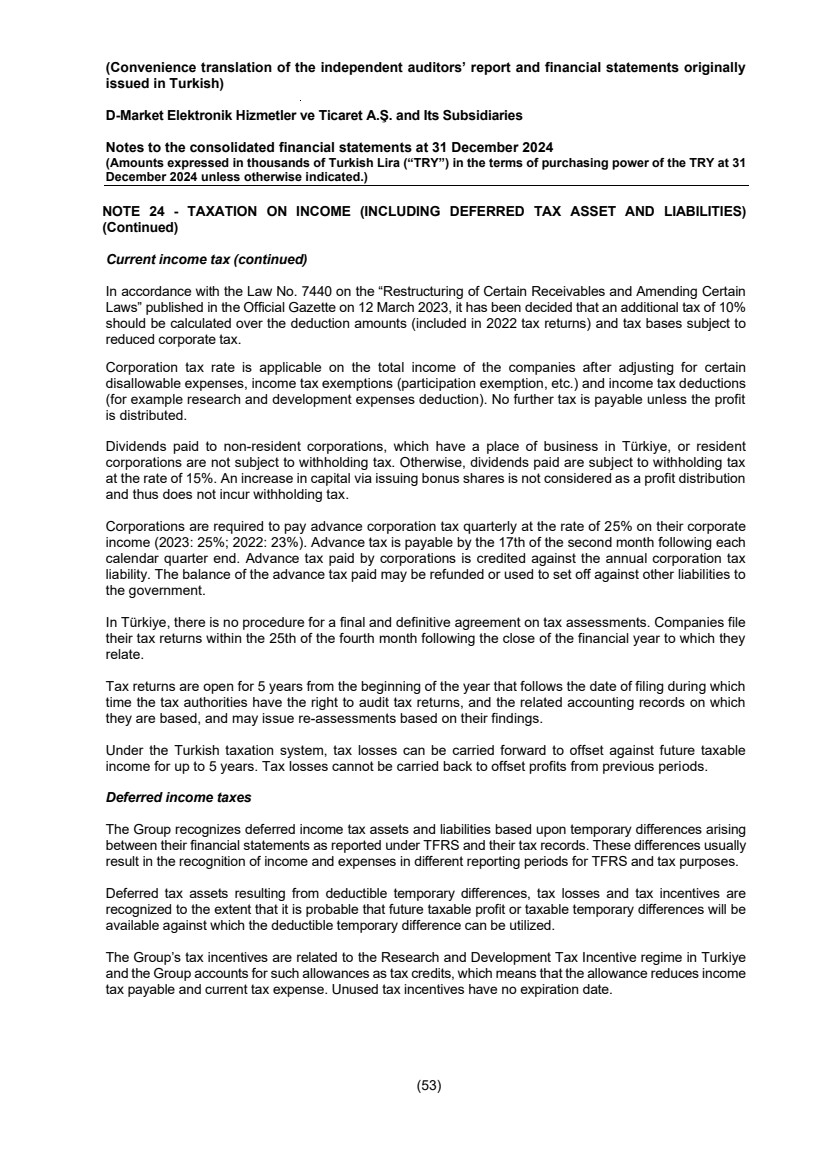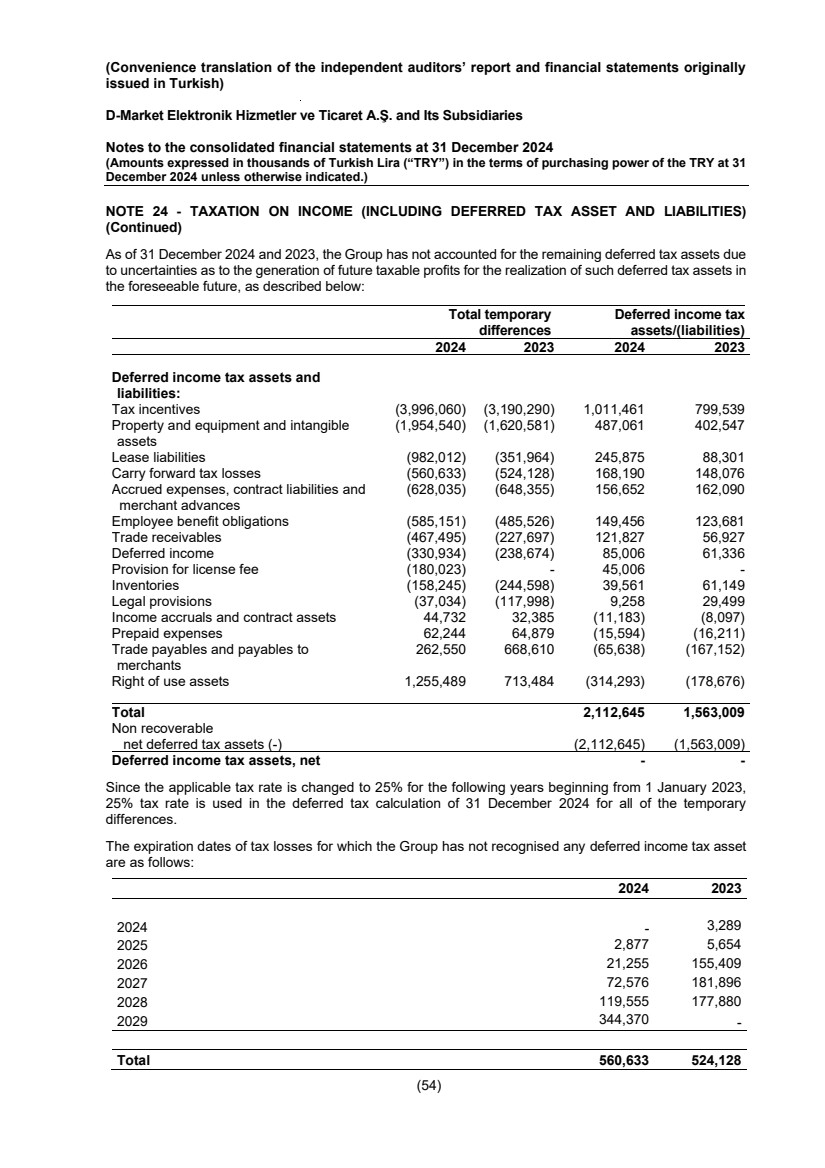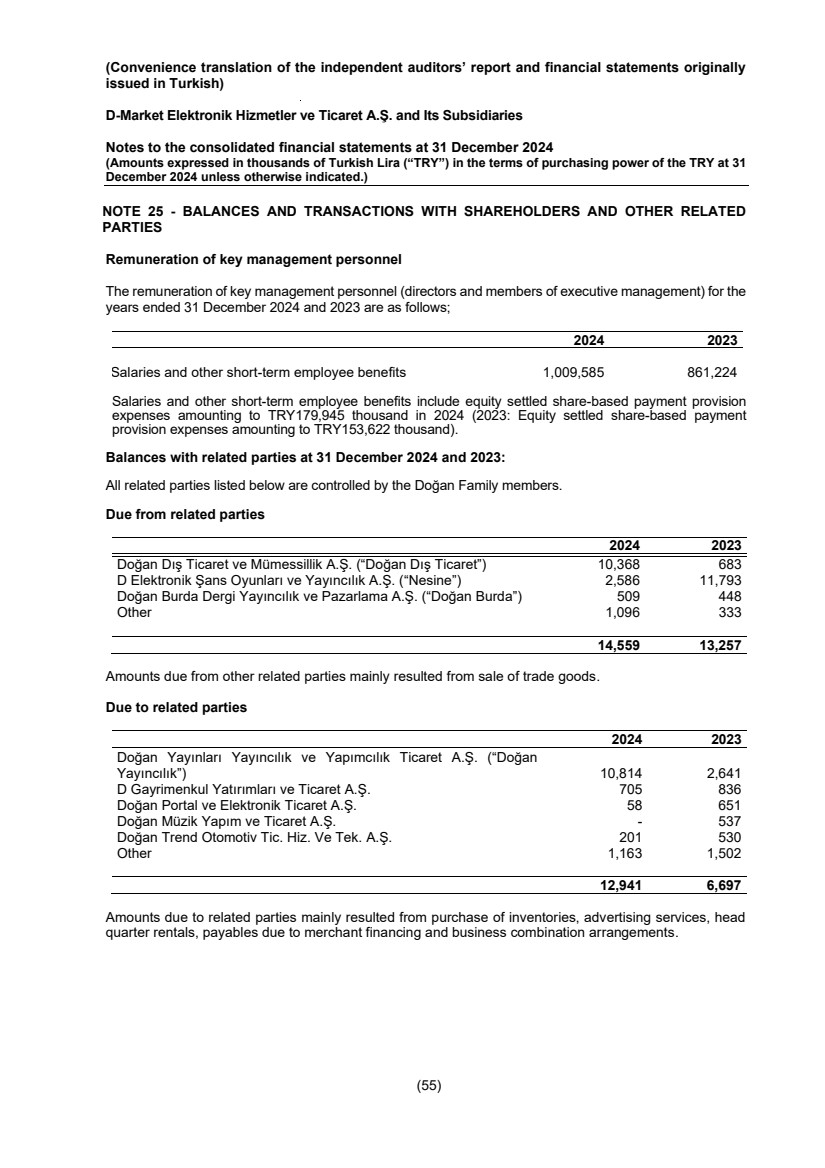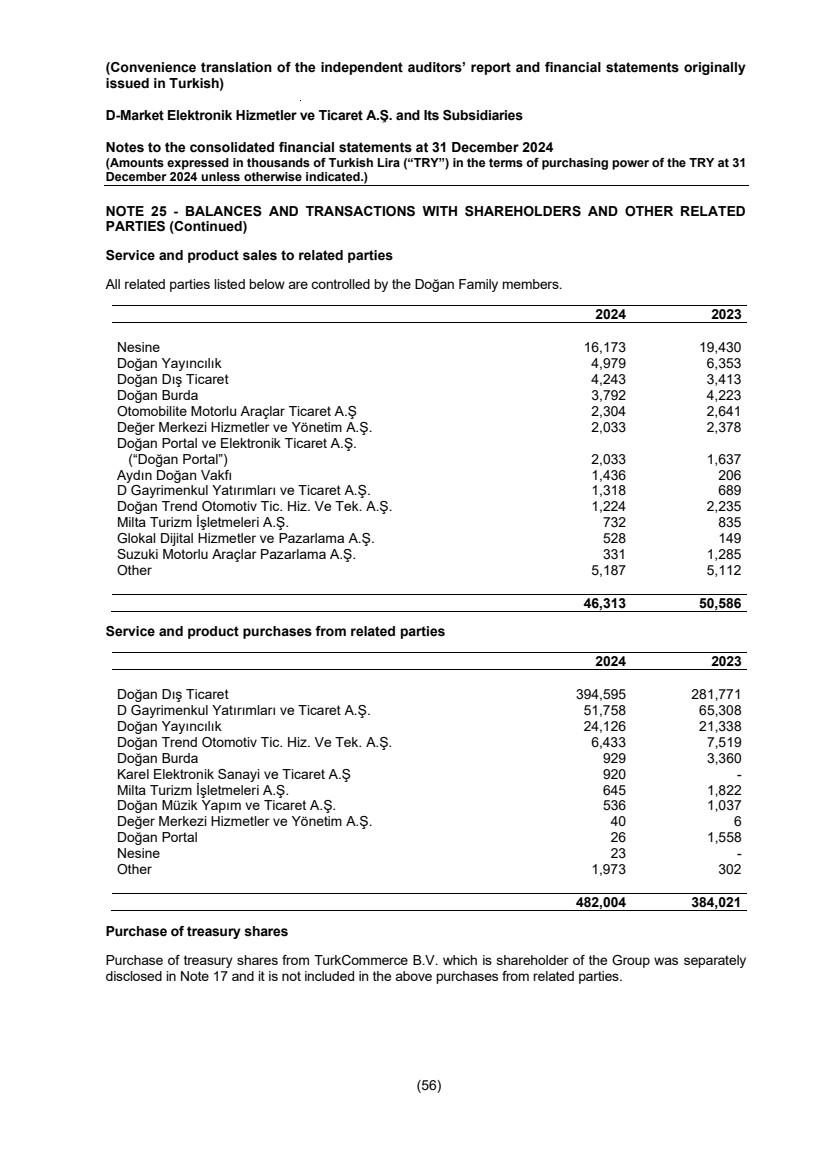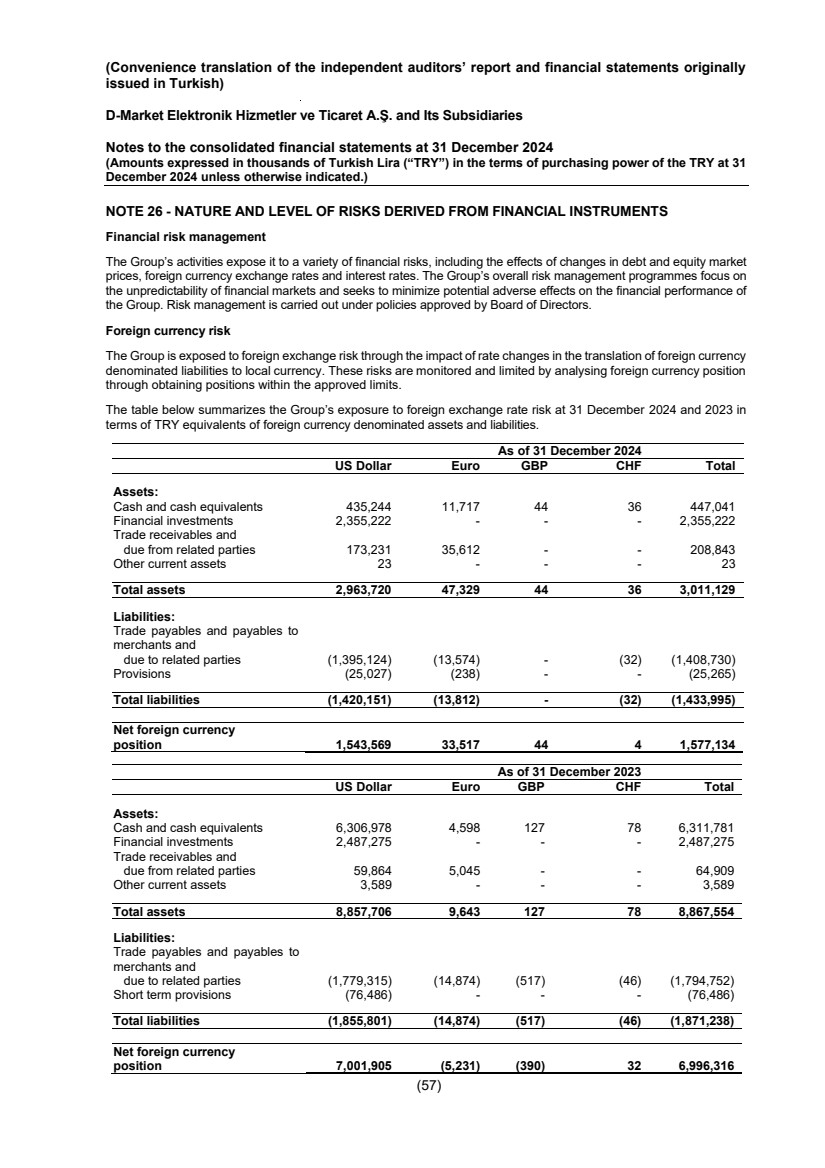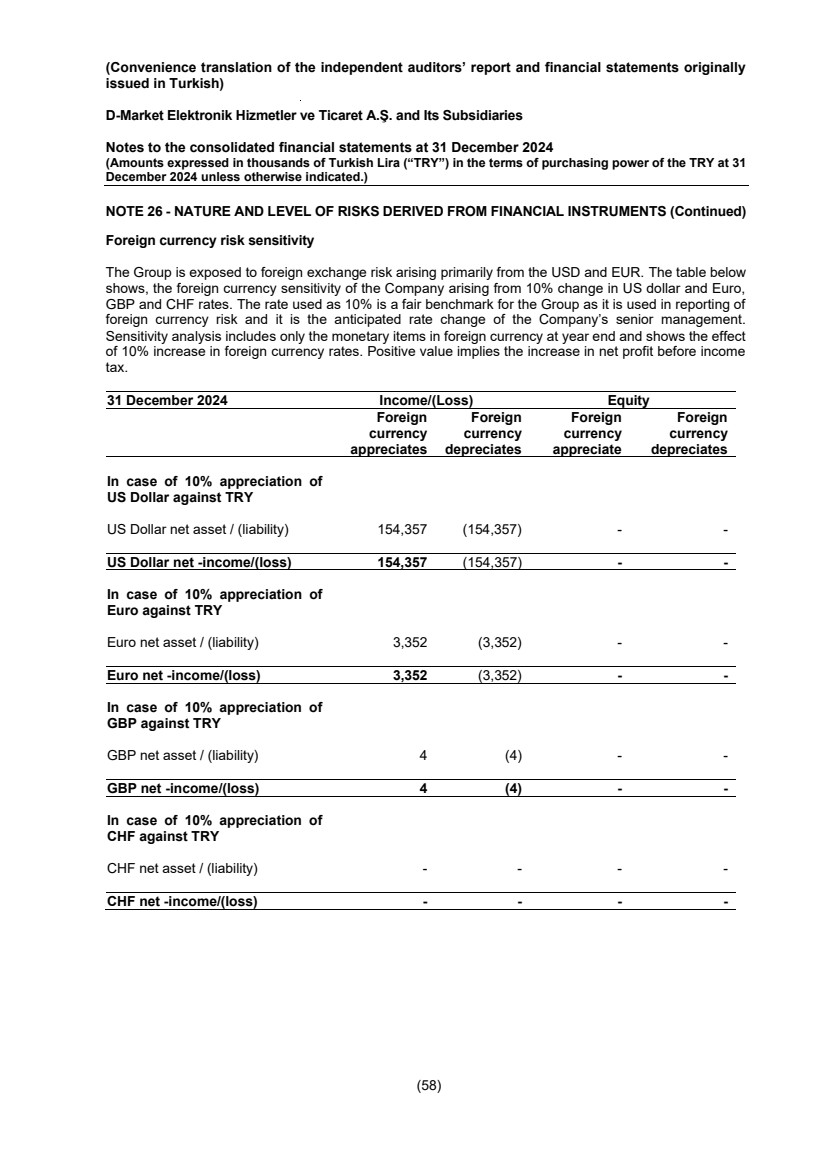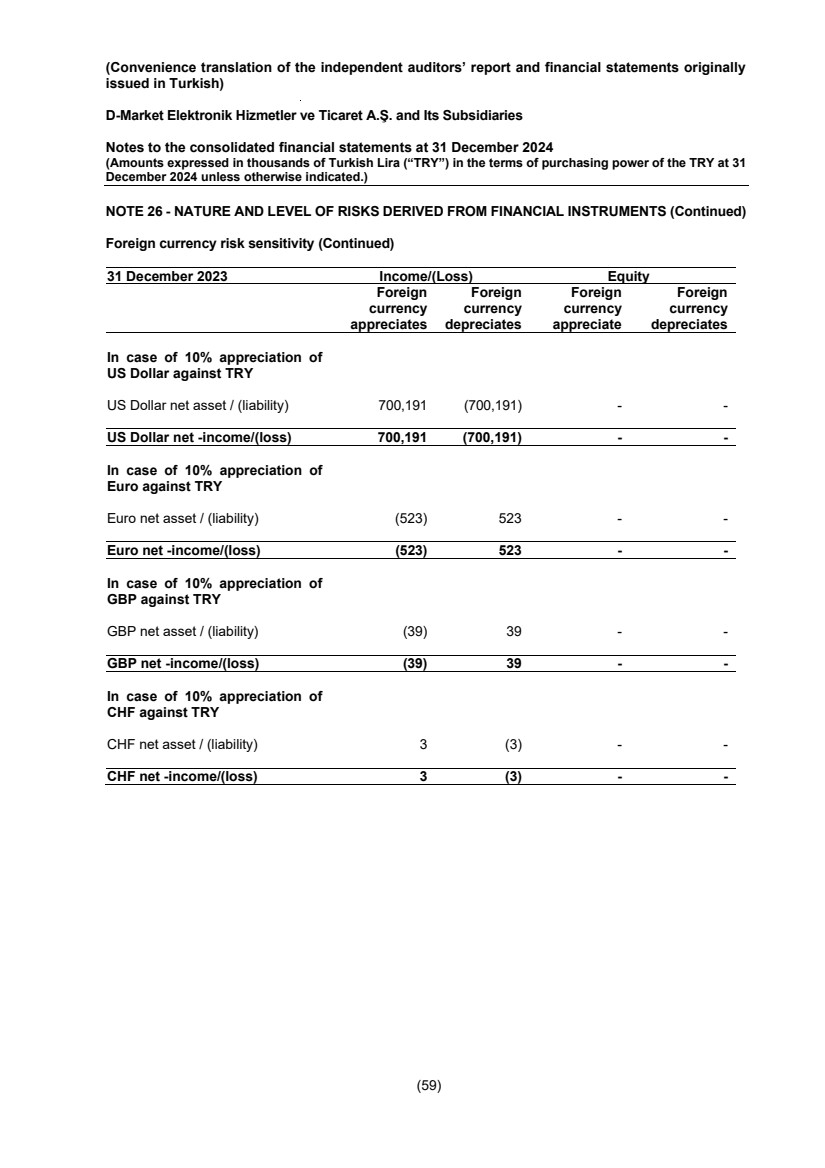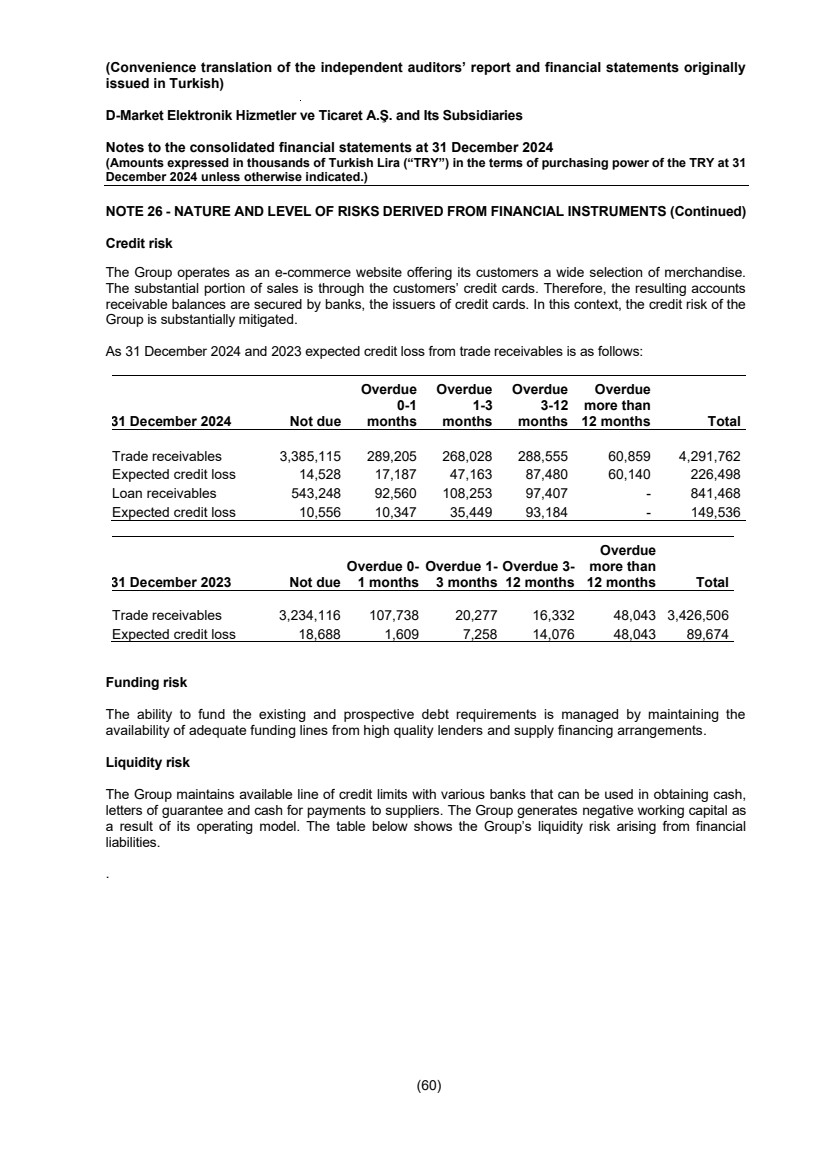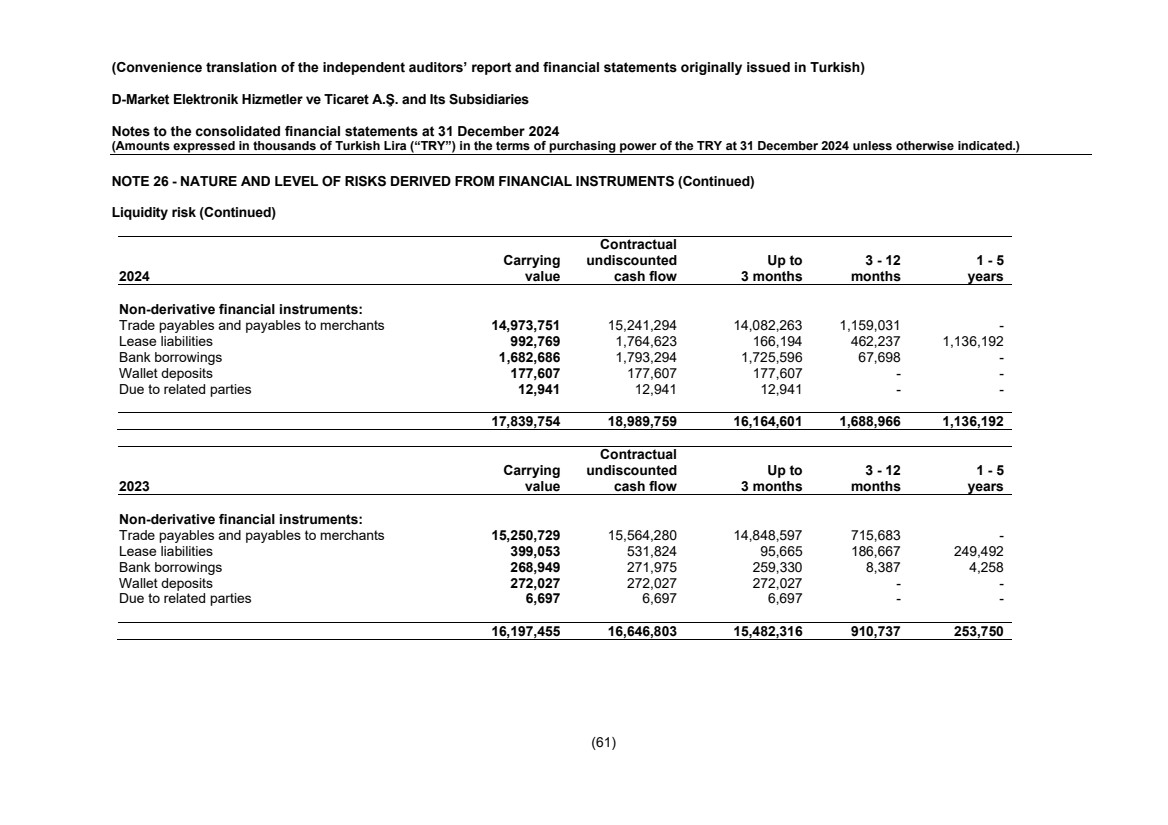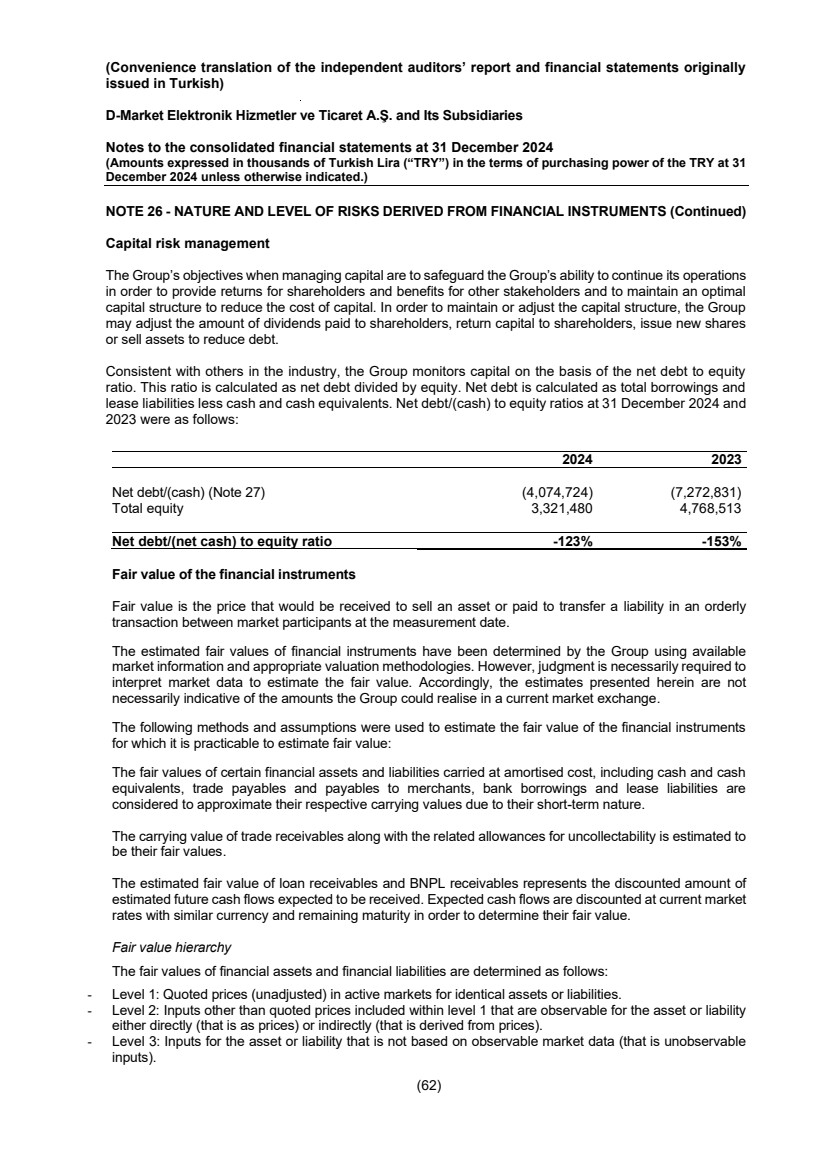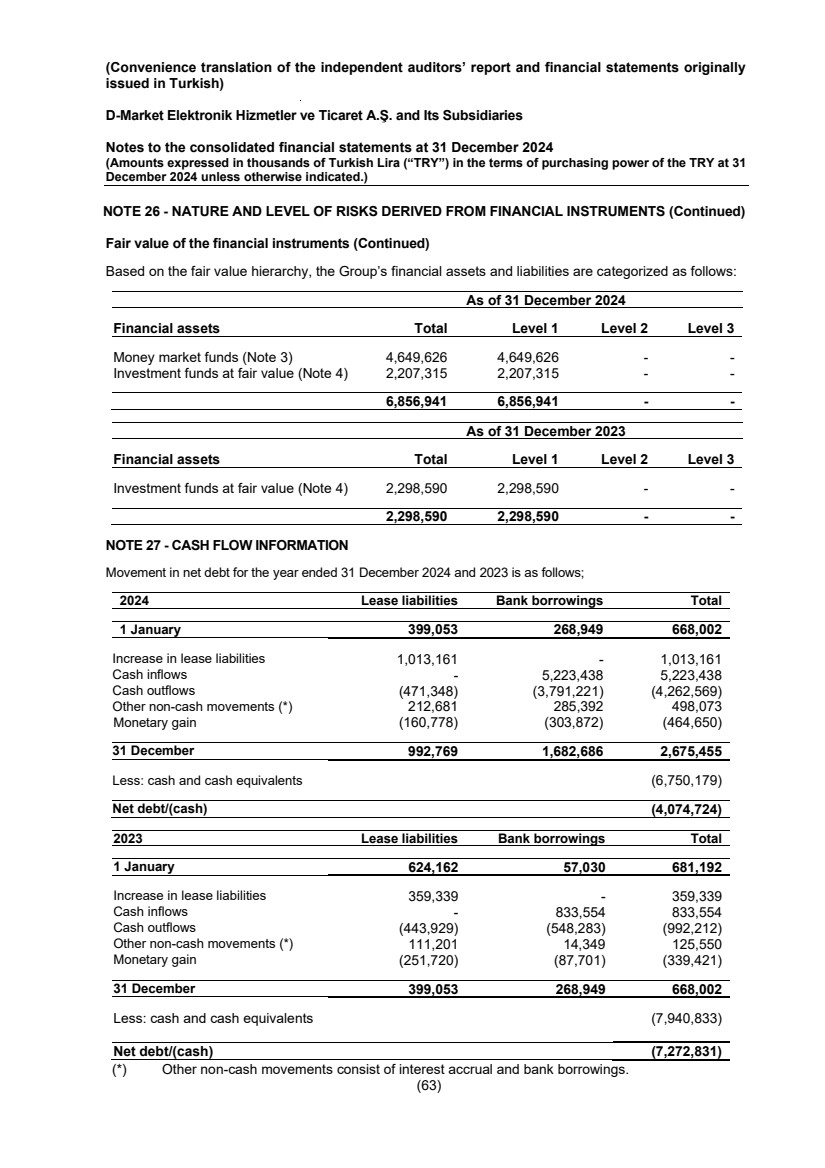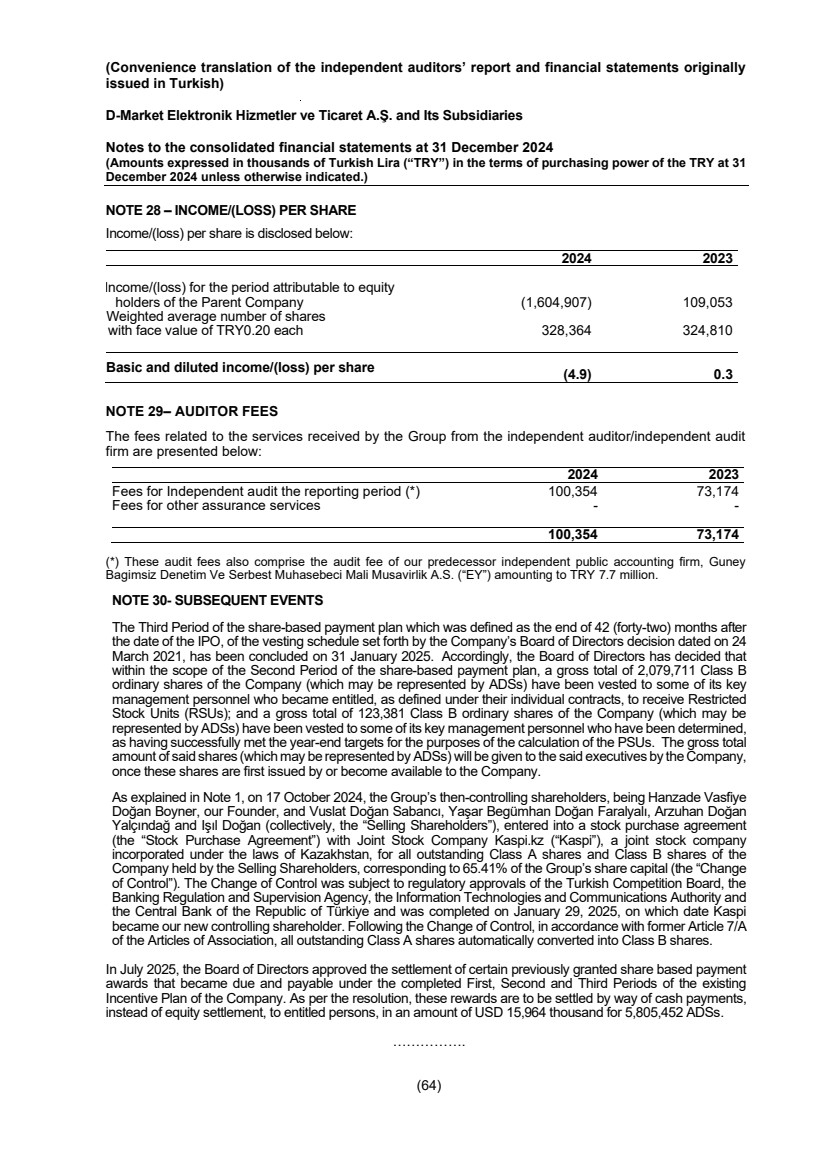| (CONVENIENCE TRANSLATION INTO ENGLISH OF CONSOLIDATED FINANCIAL STATEMENTS ORIGINALLY ISSUED IN TURKISH) D-MARKET ELEKTRONİK HİZMETLER VE TİCARET A.Ş. AND ITS SUBSIDIARIES CONSOLIDATED FINANCIAL STATEMENTS AT 1 JANUARY - 31 DECEMBER 2024 TOGETHER WITH INDEPENDENT AUDITOR’S REPORT |
| PwC Bağımsız Denetim ve Serbest Muhasebeci Mali Müşavirlik A.Ş. Kılıçali Paşa Mah. Meclis-i Mebusan Cad. No:8 İç Kapı No:301 Beyoğlu/İstanbul T: +90 212 326 6060, F: +90 212 326 6050, www.pwc.com.tr Mersis Numaramız: 0-1460-0224-0500015 CONVENIENCE TRANSLATION INTO ENGLISH OF INDEPENDENT AUDITOR’S REPORT ORIGINALLY ISSUED IN TURKISH INDEPENDENT AUDITOR’S REPORT To the General Assembly of D-Market Elektronik Hizmetler ve Ticaret A.Ş. A. Audit of the consolidated financial statements 1. Our opinion We have audited the accompanying consolidated financial statements of D-Market Elektronik Hizmetler ve Ticaret A.Ş. (the “Company”) and its subsidiaries (collectively referred to as the “Group”) which comprise the consolidated statement of financial position as at 31 December 2024, the consolidated statement of profit or loss and other comprehensive income, the consolidated statement of changes in equity and the consolidated statement of cash flows for the year then ended and notes to the consolidated financial statements comprising a summary of significant accounting policies. In our opinion, the consolidated financial statements present fairly, in all material respects, the financial position of the Group as at 31 December 2024, and its financial performance and its cash flows for the year then ended in accordance with Turkish Financial Reporting Standards (“TFRS”). 2. Basis for opinion Our audit was conducted in accordance with the Standards on Independent Auditing (the “SIA”) that are part of Turkish Standards on Auditing issued by the Public Oversight Accounting and Auditing Standards Authority (the “POA”). Our responsibilities under these standards are further described in the “Auditor’s Responsibilities for the Audit of the Consolidated Financial Statements” section of our report. We hereby declare that we are independent of the Group in accordance with the Ethical Rules for Independent Auditors (including Independence Standards) (the “Ethical Rules”) the ethical requirements regarding independent audit in regulations issued by the POA; are relevant to our audit of the financial statements. We have also fulfilled our other ethical responsibilities in accordance with the Ethical Rules and regulations. We believe that the audit evidence we have obtained during the independent audit provides a sufficient and appropriate basis for our opinion. 3. Key audit matters Key audit matters are those matters that, in our professional judgment, were of most significance in our audit of the consolidated financial statements of the current period. Key audit matters were addressed in the context of our independent audit of the consolidated financial statements as a whole, and in forming our opinion thereon, and we do not provide a separate opinion on these matters. |
| Key Audit Matters How the key audit matter was addressed in the audit Revenue recognition The Group has recognised revenue amounting to TRY57,046,561 thousand between January 1 – December 31, 2024. As explained in Note 2, revenue should be recognised at fair value when it can be measured reliably and the economic benefits from the transactions will be received by the Group. Since the revenue represents one of the most significant amounts in the Group’s profit or loss statement, has a significant effect on the Group’s key performance indicators, and required a high degree of auditor effort in performing procedures, it is considered significant area of focus. The Group’s revenue mainly consists of goods sales through its website and marketplace services commission fee. Revenue from sales of goods and services is recognised on a periodic basis at the time the contractual obligations are fulfilled at invoiced values. The Group’s revenue from these operations arises from small valued but high number of transactions. According to the above-mentioned explanations, revenue recognition is determined as key audit matter. The detailed explanations for revenue recognition and revenue amounts are presented in Note 2.7 and Note 18. The following audit procedures have been applied regarding the revenue recognition: - Assessing whether the accounting policies applied comply with TFRS and applied consistently with prior periods. - Understanding of the processes of the Group regarding the revenue recognition. - Evaluation of contracts with customers and impacts of contractual clauses on revenue. - Testing of the Group's sales of goods and marketplace service revenues by considering the collection amounts confirmed with financial institutions. - Performing detailed tests related to the transactions that were carried out before and after the fiscal period to assess whether the revenue is recognized in the correct period. - Evaluation the adequacy and consistency of the Group's revenue disclosures in the consolidated financial statements with TFRS. |
| 4. Responsibilities of management and those charged with governance for the consolidated financial statements The Group management is responsible for the preparation and fair presentation of the consolidated financial statements in accordance with TFRS, and for such internal control as management determines is necessary to enable the preparation of consolidated financial statements that are free from material misstatement, whether due to fraud or error. In preparing the consolidated financial statements, management is responsible for assessing the Group’s ability to continue as a going concern, disclosing, as applicable, matters related to going concern and using the going concern basis of accounting unless management either intends to liquidate the Group or to cease operations, or has no realistic alternative but to do so. Those charged with governance are responsible for overseeing the Group’s financial reporting process. 5. Auditor’s responsibilities for the audit of the consolidated financial statements Responsibilities of independent auditors in an independent audit are as follows: Our aim is to obtain reasonable assurance about whether the financial statements as a whole are free from material misstatement, whether due to fraud or error, and to issue an independent auditor’s report that includes our opinion. Reasonable assurance expressed as a result of an independent audit conducted in accordance with SIA is a high level of assurance but does not guarantee that a material misstatement will always be detected. Misstatements can arise from fraud or error. Misstatements are considered material if, individually or in the aggregate, they could reasonably be expected to influence the economic decisions of users taken on the basis of these consolidated financial statements. As part of an independent audit conducted in accordance with SIA, we exercise professional judgment and maintain professional scepticism throughout the audit. We also: • Identify and assess the risks of material misstatement in the consolidated financial statements, whether due to fraud or error, design and perform audit procedures responsive to those risks, and obtain audit evidence that is sufficient and appropriate to provide a basis for our opinion. The risk of not detecting a material misstatement resulting from fraud is higher than for one resulting from error, as fraud may involve collusion, forgery, intentional omissions, misrepresentations, or the override of internal control. |
| • Assess the internal control relevant to the audit in order to design audit procedures that are appropriate in the circumstances, but not for the purpose of expressing an opinion on the effectiveness of the Group’s internal control. • Evaluate the appropriateness of accounting policies used and the reasonableness of accounting estimates and related disclosures made by management. • Conclude on the appropriateness of management’s use of the going concern basis of accounting and, based on the audit evidence obtained, whether a material uncertainty exists related to events or conditions that may cast significant doubt on the Group’s ability to continue as a going concern. If we conclude that a material uncertainty exists, we are required to draw attention in our auditor’s report to the related disclosures in the consolidated financial statements or, if such disclosures are inadequate, to modify our opinion. Our conclusions are based on the audit evidence obtained up to the date of our independent auditor’s report. However, future events or conditions may cause the Group to cease to continue as a going concern. • Evaluate the overall presentation, structure and content of the consolidated financial statements, including the disclosures, and whether the consolidated financial statements represent the underlying transactions and events in a manner that achieves fair presentation. • Plan and perform the group audit to obtain sufficient appropriate audit evidence regarding the financial information of the entities or business units within the Group as a basis for forming an opinion on the consolidated financial statements. We are responsible for the direction, supervision and review of the audit work performed for purposes of the Group audit. We remain solely responsible for our audit opinion. We communicate with those charged with governance regarding, among other matters, the planned scope and timing of the audit and significant audit findings, including any significant deficiencies in internal control that we identify during our audit. From the matters communicated with those charged with governance, we determine those matters that were of most significance in the audit of the consolidated financial statements of the current period and are therefore the key audit matters. We describe these matters in our auditor’s report unless law or regulation precludes public disclosure about the matter or when, in extremely rare circumstances, we determine that a matter should not be communicated in our report because the adverse consequences of doing so would reasonably be expected to outweigh the public interest benefits of such communication. |
| B. Other responsibilities arising from regulatory requirements 1. No matter has come to our attention that is significant according to subparagraph 4 of Article 402 of Turkish Commercial Code (“TCC”) No. 6102 and that causes us to believe that the Company’s bookkeeping activities concerning the period from 1 January to 31 December 2024 period are not in compliance with the TCC and provisions of the Company’s articles of association related to financial reporting. 2. In accordance with subparagraph 4 of Article 402 of the TCC, the Board of Directors submitted the necessary explanations to us and provided the documents required within the context of our audit. PwC Bağımsız Denetim ve Serbest Muhasebeci Mali Müşavirlik A.Ş. Mehmet Cenk Uslu, SMMM Independent Auditor Istanbul, 30 July 2025 |
| Contents Page Consolidated statement of financial position..................................................................................... 1-2 Consolidated statement of profit or loss............................................................................................ 3 Consolidated statement of other comprehensive income................................................................. 3 Consolidated statement of changes in equity ................................................................................... 4 Consolidated statement of cash flow ................................................................................................ 5 Notes to the consolidated financial statements................................................................................. 6-64 |
| (Convenience translation of the independent auditors’ report and financial statements originally issued in Turkish) D-Market Elektronik Hizmetler ve Ticaret A.Ş. and Its Subsidiaries Consolidated statement of financial position at 31 December 2024 (Amounts expressed in thousands of Turkish Lira (“TRY”) in the terms of purchasing power of the TRY at 31 December 2024 unless otherwise indicated.) (1) Audited Audited Current Period Prior Period Note 31 December 2024 31 December 2023 ASSETS Current assets: Cash and cash equivalents 3 6,750,179 7,940,833 Restricted cash 135,271 241,563 Financial investments 4 2,384,743 2,487,275 Trade and loan receivables - Due from related parties 6, 25 14,559 13,257 - Due from third parties 6 4,291,762 3,426,506 - Loan receivables 6 753,873 - Inventories 8 6,001,460 5,724,600 Prepaid expenses 9 337,598 606,053 Current income tax assets 24 67,978 62,409 Contract assets 10 44,732 32,385 Other current assets 16 72,537 579,423 Total current assets 20,854,692 21,114,304 Non-current assets: Loan receivables 87,595 1,154 Property and equipment 11 831,413 725,854 Intangible assets 12 3,058,638 2,675,774 Right of use assets 13 1,299,765 816,496 Prepaid expenses 9 11,470 47,263 Goodwill 410 410 Other non-current assets 16 935 1,422 Total non-current assets 5,290,226 4,268,373 Total assets 26,144,918 25,382,677 These consolidated financial statements have been approved by Board of Directors on 30 July 2025. The General Assembly has the right to amend these consolidated financial statements. The accompanying notes are an integral part of these consolidated financial statements. |
| (Convenience translation of the independent auditors’ report and financial statements originally issued in Turkish) D-Market Elektronik Hizmetler ve Ticaret A.Ş. and Its Subsidiaries Consolidated statement of financial position at 31 December 2024 (Amounts expressed in thousands of Turkish Lira (“TRY”) in the terms of purchasing power of the TRY at 31 December 2024 unless otherwise indicated.) (2) Audited Audited Current period Prior period Note 31 December 2024 31 December 2023 LIABILITIES AND EQUITY Current liabilities Short-term bank borrowings 5 1,682,686 264,894 Lease liabilities 13 409,083 223,171 Wallet deposits 177,607 272,027 Trade payables - Due to related parties 6,25 12,941 6,697 - Due to third parties 6 14,973,751 15,250,729 Payables related to employee benefits 15 95,685 99,674 Other payables - Due to third parties 7 669,371 150,879 Deferred income 9 428,593 537,608 Short-term provisions - Short-term provisions for employment benefits 15 522,124 417,846 - Other short-term provisions 14 217,057 117,998 Contract liabilities 10 1,906,945 2,056,628 Other short-term liabilities 16 490,183 303,905 Total current liabilities 21,586,026 19,702,056 Non-current liabilities Long-term borrowings 5 - 4,055 Lease liabilities 13 583,686 175,882 Long-term provisions - Long-term provisions for employment benefits 15 153,780 150,563 Deferred income 9 499,946 581,608 Total non-current liabilities 1,237,412 912,108 Shareholders’ equity Share capital 17 65,200 65,200 Adjustment to share capital 17 654,760 654,760 Treasury shares 17 (245,217) (245,217) Other reserves 15 1,100,704 920,759 Share premium 17 20,910,909 20,910,909 Other comprehensive losses that will not be reclassified in profit or loss (218,226) (196,155) Restricted reserves 17 23,378 23,378 Accumulated losses (17,365,121) (17,474,174) Net loss for the year (1,604,907) 109,053 Total equity 3,321,480 4,768,513 Total liabilities and equity 26,144,918 25,382,677 The accompanying notes are an integral part of these consolidated financial statements. |
| (Convenience translation of the independent auditors’ report and financial statements originally issued in Turkish) D-Market Elektronik Hizmetler ve Ticaret A.Ş. and Its Subsidiaries Consolidated statement of profit or loss and other comprehensive income for the period 1 January - 31 December 2024 (Amounts expressed in thousands of Turkish Lira (“TRY”) in the terms of purchasing power of the TRY at 31 December 2024 unless otherwise indicated.) (3) Audited Audited Current period Prior period Note 1 January-31 December 2024 1 January-31 December 2023 PROFIT OR LOSS Revenue 18 57,046,561 51,338,956 Cost of sales (-) 18 (42,725,747) (41,108,446) Gross profit 14,320,814 10,230,510 General administrative expenses (-) 19 (6,188,126) (5,271,955) Marketing, sales and distribution expenses (-) 19 (7,782,487) (6,285,527) Other operating income 21 1,839,122 1,707,305 Other operating expenses (-) 21 (3,484,382) (3,344,181) Operating loss (1,295,059) (2,963,848) Income from investment activities 22 594,723 543,957 Expenses from investment activities (-) 22 - - Operating loss before financial (expense)/income (700,336) (2,419,891) Financial income 23 2,067,442 3,811,204 Financial expenses (-) 23 (4,992,484) (3,117,252) Monetary gains 2,020,471 1,834,992 Profit/(loss) before taxation from continued operations (1,604,907) 109,053 Tax expenses 24 - - Profit/(loss) for the period from continued operations (1,604,907) 109,053 Attributable to: Equity holders of the parent (1,604,907) 109,053 Profit/(loss) for the period (1,604,907) 109,053 Basic and diluted loss per share 28 (4.9) 0.3 OTHER COMPREHENSIVE INCOME/(EXPENSE) Items not to be reclassified to profit or loss Loss arising from defined benefit plans 15 (22,071) (108,441) TOTAL COMPREHENSIVE INCOME/(LOSS) (1,626,978) 612 Attributable to: Equity holders of the parent (1,626,978) 612 The accompanying notes are an integral part of these consolidated financial statements. |
| (Convenience translation of the independent auditors’ report and financial statements originally issued in Turkish) D-Market Elektronik Hizmetler ve Ticaret A.Ş. and Its Subsidiaries Consolidated statement of changes in equity for the period 1 January - 31 December 2024 (Amounts expressed in thousands of Turkish Lira (“TRY”) in the terms of purchasing power of the TRY at 31 December 2024 unless otherwise indicated.) (4) Items not to be reclassified to profit or loss Share Adjustment Treasury Other Share Loss arising from Restricted Accumulated Loss for Total capital to share capital shares reserves premiums defined benefit plans reserves losses the period equity Balance at 1 January 2023 65,200 654,760 - 767,137 20,910,909 (87,714) 23,378 (10,557,437) (6,916,737) 4,859,496 Transfers - - - - - - - (6,916,737) 6,916,737 - Acquisition of treasury shares (Note 17) - - (245,217) - - - - - - (245,217) Share-based payments (Note 15) - - - 153,622 - - - - - 153,622 Net profit for the period - - - - - - - - 109,053 109,053 Other comprehensive loss - - - - - (108,441) - - - (108,441) Balance at 31 December 2023 65,200 654,760 (245,217) 920,759 20,910,909 (196,155) 23,378 (17,474,174) 109,053 4,768,513 Balance at 1 January 2024 65,200 654,760 (245,217) 920,759 20,910,909 (196,155) 23,378 (17,474,174) 109,053 4,768,513 Transfers - - - - - - - 109,053 (109,053) - Share-based payments (Note 15) - - - 179,945 - - - - - 179,945 Net loss for the period - - - - - - - - (1,604,907) (1,604,907) Other comprehensive loss - - - - - (22,071) - - - (22,071) Balance at 31 December 2024 65,200 654,760 (245,217) 1,100,704 20,910,909 (218,226) 23,378 (17,365,121) (1,604,907) 3,321,480 The accompanying notes are an integral part of these consolidated financial statements. |
| (Convenience translation of the independent auditors’ report and financial statements originally issued in Turkish) D-Market Elektronik Hizmetler ve Ticaret A.Ş. and Its Subsidiaries Consolidated statement of cash flow for the period 1 January - 31 December 2024 (Amounts expressed in thousands of Turkish Lira (“TRY”) in the terms of purchasing power of the TRY at 31 December 2024 unless otherwise indicated.) (5) Audited Audited Current period Prior period 1 January - 1 January-Note 31 December 2024 31 December 2023 A. Net cash provided by operating activities 4,721,910 6,231,311 Net profit/(loss) for the year (1,604,907) 109,053 Adjustments to reconcile net profit/(loss) for the year 9,232,046 9,351,857 Adjustments related to financial expenses 21, 23 7,319,535 4,625,821 Adjustments related to interest income 21, 22, 23 (3,104,270) (1,266,968) Adjustments related to changes in unrealised foreign exchange differences (515,346) (412,612) Adjustments related to depreciation and amortization 20 2,048,138 1,695,200 Adjustments related to impairment loss/(reversal) 6, 8 401,063 121,102 Adjustments related to fair value losses 4 (127,621) (342,921) Adjustments related to provisions 14, 15 680,047 140,052 Monetary losses 2,530,500 4,968,065 Other adjustments related to profit/(loss) reconciliation - (175,882) Changes in working capital (1,554,815) (1,348,019) Adjustments for increase in inventories (354,311) (1,695,855) Adjustments for increase in trade and loan receivables (2,058,653) (2,083,230) Adjustments for increase in trade payables (226,349) 1,507,389 Adjustments regarding increase in other receivables on operations 812,254 93,384 Adjustments regarding increase in other payables on operations 272,244 830,293 Net cash from operating activities (1,350,414) (1,881,580) Payments related with employee benefits 15 (316,942) (299,816) Interest received 1,373,524 537,512 Interest paid (2,349,292) (1,552,740) Other cash inflows/(outflows) (57,704) (566,536) B. Cash flows from investing activities (478,817) (2,960,605) Purchase of tangible and intangible assets 11, 12 (2,010,546) (1,665,725) Proceeds from sales of tangible and intangible assets 14,788 10,913 Cash inflows from sale of financial investment 4 6,147,437 4,948,695 Cash outflows from purchase of financial investment 4 (6,428,347) (7,323,109) Interest received 1,797,851 1,068,621 C. Cash flows from financing activities (3,516,645) (3,255,100) Proceeds from borrowings 27 5,223,438 833,554 Repayment of borrowings 27 (3,791,221) (548,283) Lease payments 27 (471,348) (443,929) Interest paid (4,477,514) (3,027,107) Acquisition of treasury shares 17 - (69,335) Net increase/(decrease) in cash and cash equivalents before the effect of currency translation reserves (A+B+C) 726,448 15,606 D. Effects of exchange rate changes on cash and cash equivalents 49,919 251,829 E. Inflation effect on cash and cash equivalents (1,967,204) (4,840,723) Net increase in cash and cash equivalents (A+B+C+D+E) (1,190,837) (4,573,288) F. Cash and cash equivalents at beginning of the year 3 7,939,626 12,512,914 Cash and cash equivalents at end of the year (A+B+C+D+E+F) 3 6,748,789 7,939,626 The accompanying notes are an integral part of these consolidated financial statements. |
| (Convenience translation of the independent auditors’ report and financial statements originally issued in Turkish) D-Market Elektronik Hizmetler ve Ticaret A.Ş. and Its Subsidiaries Notes to the consolidated financial statements at 31 December 2024 (Amounts expressed in thousands of Turkish Lira (“TRY”) in the terms of purchasing power of the TRY at 31 December 2024 unless otherwise indicated.) (6) NOTE 1 - ORGANISATION AND NATURE OF OPERATIONS D-Market Elektronik Hizmetler ve Ticaret A.Ş. (“D-Market” or “Hepsiburada” or together with its subsidiaries the “Group”) was established in April 2000. D-Market currently operates as a retail website (www.hepsiburada.com) offering its retail customers a wide selection of merchandise including electronics and non-electronics (including books, sports, toys, kids and baby products, cosmetics, furniture, etc.). As of 31 December 2024, the ultimate shareholders of D-Market are the members of Doğan Family and Turk Commerce B.V. (Note 17). On July 6, 2021, the Company completed an initial public offering (“IPO”) of 65,251,000 American Depositary Shares (“ADSs”) representing 65,251,000 Class B ordinary shares, at a price to the public of $12.00 per ADS on Nasdaq. The offering included 41,670,000 ADSs offered by the Company and 23,581,000 ADSs offered by a selling shareholder, which included 8,511,000 ADSs sold by the selling shareholder pursuant to the underwriters’ exercise in full of their over-allotment option. The ADSs began trading on the Nasdaq Global Select Market under the ticker symbol “HEPS” on July 1, 2021. On 17 October 2024, the Group’s then-controlling shareholders, being Hanzade Vasfiye Doğan Boyner, our Founder, and Vuslat Doğan Sabancı, Yaşar Begümhan Doğan Faralyalı, Arzuhan Doğan Yalçındağ and Işıl Doğan (collectively, the “Selling Shareholders”), entered into a stock purchase agreement (the “Stock Purchase Agreement”) with Joint Stock Company Kaspi.kz (“Kaspi”), a joint stock company incorporated under the laws of Kazakhstan, for all outstanding Class A shares and Class B shares of the Company held by the Selling Shareholders, corresponding to 65.41% of the Group’s share capital (the “Change of Control”). The Change of Control was subject to regulatory approvals of the Turkish Competition Board, the Banking Regulation and Supervision Agency, the Information Technologies and Communications Authority and the Central Bank of the Republic of Türkiye and was completed on January 29, 2025, on which date Kaspi became our new controlling shareholder. Following the Change of Control, in accordance with former Article 7/A of the Articles of Association, all outstanding Class A shares automatically converted into Class B shares. As of 31 December 2024, the Group has 3,743 employees (2023: 3,213). The address of the registered office is as follows: Kuştepe Mahallesi, Mecidiyeköy Yolu Caddesi No: 12 Kule 2 Kat 2 Şişli, Istanbul - Türkiye Subsidiaries The Subsidiaries included in these consolidated financial statements are as follows: • D Ödeme Elektronik Para ve Ödeme Hizmetleri A.Ş. (“D-Ödeme” or “Hepsipay”) • D Fast Dağıtım Hizmetleri ve Lojistik A.Ş. (“D-Fast” or “Hepsijet”) • Hepsi Finansal Danışmanlık A.Ş. (“Hepsi Finansal”) • Hepsi Finansman A.Ş. (“Hepsi Finansman”) (former trade name “Doruk Finansman A.Ş”) • Hepsiburada Global B.V. (“Hepsiburada Global”) • Hepsiburada Global Elektronik Hizmetler Ticaret ve Pazarlama A.Ş. (“Hepsiburada Global A.Ş.“) D Ödeme was founded on 4 June 2015 and operates as a payment services provider offering payment gateway and e-money services. D Ödeme obtained its operational licence from Banking Regulation and Supervision Agency of Türkiye (“BRSA”) on 20 February 2016. D Ödeme commenced its first payment service transaction on 15 June 2016. D Ödeme launched Hepsipay Cüzdanım (Wallet) in June 2021, an embedded digital wallet product on Hepsiburada platform. D Fast was founded on 26 February 2016 and operates as a cargo and logistic firm which provides last mile delivery services to the customers of Hepsiburada and other customers. |
| (Convenience translation of the independent auditors’ report and financial statements originally issued in Turkish) D-Market Elektronik Hizmetler ve Ticaret A.Ş. and Its Subsidiaries Notes to the consolidated financial statements at 31 December 2024 (Amounts expressed in thousands of Turkish Lira (“TRY”) in the terms of purchasing power of the TRY at 31 December 2024 unless otherwise indicated.) (7) NOTE 1 - ORGANISATION AND NATURE OF OPERATIONS (Continued) Hepsi Finansal was founded on 1 December 2021. Hepsi Finansal aims to operate as a holding company for the fintech operations of the Group and to provide financial solutions to the customers of Hepsiburada. Hepsi Finansal is the parent company of the Hepsi Finansman A.Ş. which was acquired in February 2022. Hepsi Finansman was acquired by the Group on 28 February 2022 and the Group aims to offer its customers consumer financing solutions through Hepsi Finansman. Hepsi Finansman was founded on 24 April 2006 and obtained its operational license from the BRSA in 2008. Hepsi Finansman operates as a consumer financing company in Türkiye. Hepsiburada Global was founded on 28 July 2023 in the Netherlands. Hepsiburada Global aims to facilitate Hepsiburada’s integration with European payment solutions and marketplaces. Hepsiburada Global A.Ş. was founded on 29 March 2024 in Türkiye. Hepsiburada Global A.Ş. aims to facilitate to manage Hepsiburada’s cross border e-commerce operations. NOTE 2 - BASIS OF PRESENTATION OF CONSOLIDATED FINANCIAL STATEMENTS 2.1 Basis of preparation The accompanying consolidated financial statements are prepared in accordance with Turkish Financial Reporting Standards (“TFRS”) issued by the Public Oversight Accounting and Auditing Standards Authority (“POA”). The Company maintais its books of account in Turkish Lira (“TRY”) based on the Turkish Commercial Code (“TCC”), Turkish tax legislation and the Uniform Chart of Accounts issued by the Ministry of Finance of Türkiye. In addition, the Company has prepared its consolidated financial statements in accordance with the accounting policies disclosed in Note 2.7 for the purpose of fair presentation in accordance with TFRS. Consolidated financial statements have been presented in accordance with the TAS taxonomy published by the POA on 4 October 2022. Financial reporting in hyperinflationary economy With the announcements made by the Public Oversight Accounting and Auditing Standards Authority (POA) on 23 November 2023, entities applying TFRSs have started to apply inflation accounting in accordance with “TAS 29 Financial Reporting in Hyperinflation Economies as of financial statements for the annual reporting period ending on or after 31 December 2024”. TAS 29 is applied to the financial statements, including the consolidated financial statements, of any entity whose functional currency is the currency of a hyperinflationary economy. According to the standard, financial statements prepared in the currency of a hyperinflationary economy are presented in terms of the purchasing power of that currency at the balance sheet date. Prior period financial statements are also presented in the current measurement unit at the end of the reporting period for comparative purposes. The Group has therefore presented its consolidated financial statements as of December 31, 2023, on the purchasing power basis as of December 31, 2024. The adjustments made in accordance with IAS 29 were made using the adjustment coefficient obtained from the Consumer Price Index (CPI) of Turkey published by the Turkish Statistical Institute (TÜİK). As of December 31, 2024, the indices and adjustment coefficients used in the adjustment of the consolidated financial statements are as follows: Date Index Adjustment Coefficient Three years compound inflation rates 31 December 2024 2684.55 1.000 291% 31 December 2023 1859.38 1.444 268% 31 December 2022 1128.45 2.379 156% |
| (Convenience translation of the independent auditors’ report and financial statements originally issued in Turkish) D-Market Elektronik Hizmetler ve Ticaret A.Ş. and Its Subsidiaries Notes to the consolidated financial statements at 31 December 2024 (Amounts expressed in thousands of Turkish Lira (“TRY”) in the terms of purchasing power of the TRY at 31 December 2024 unless otherwise indicated.) (8) NOTE 2 - BASIS OF PRESENTATION OF CONSOLIDATED FINANCIAL STATEMENTS (Continued) 2.1 Basis of preparation (Continued) The main elements of the Group's adjustment process for financial reporting in hyperinflationary economies are as follows: - Current period consolidated financial statements prepared in TRY are expressed in terms of the purchasing power at the balance sheet date, and amounts from previous reporting periods are also adjusted and expressed in terms of the purchasing power at the end of the reporting period. - Monetary assets and liabilities are not adjusted as they are already expressed in terms of the current purchasing power at the balance sheet date. In cases where the inflation-adjusted values of non-monetary items exceed their recoverable amount or net realizable value, the provisions of TAS 36 “Impairment of Assets” and TAS 2 “Inventories” are applied, respectively. - Non-monetary assets and liabilities and equity items that are not expressed in terms of the current purchasing power at the balance sheet date have been adjusted using the relevant adjustment coefficients. - All items in the comprehensive income statement, except for those that have an impact on the comprehensive income statement of non-monetary items on the balance sheet, have been indexed using the coefficients calculated for the periods when the income and expense accounts were first reflected in the financial statements. - The impact of inflation on the Group's net monetary asset position in the current period is recorded in the net monetary gain/(loss) account in the consolidated income statement. Functional and presentation currency Items included in the consolidated financial statements of each of the Group’s entities are measured using the currency of the primary economic environment in which they operate (“the functional currency”). The consolidated financial statements are presented in thousand Turkish Lira (TRY), which is both the functional and the presentation currency of the Group. Going concern The Group has recurring operating losses, the total operating loss for the year ended 31 December 2024 amounted to TRY1.3 billion, while accumulated deficit as of 31 December 2024 amounted to TRY17,4 billion. The Group generated positive operating cash flows amounting to TRY4,7 billion in 2024 and its cash and cash equivalents as of 31 December 2024 amounts to TRY6,8 billion. Based on its current business plan, the Group’s cash and cash equivalents will be sufficient to fund its operations for at least twelve months from the issuance date of these consolidated financial statements. Management of the Group believes that it will be in a position to cover its liquidity needs through cash on hand, cash generated from operations, available credit lines or a combination thereof, when necessary. The consolidated financial statements have been prepared assuming that the Group will continue as a going concern. |
| (Convenience translation of the independent auditors’ report and financial statements originally issued in Turkish) D-Market Elektronik Hizmetler ve Ticaret A.Ş. and Its Subsidiaries Notes to the consolidated financial statements at 31 December 2024 (Amounts expressed in thousands of Turkish Lira (“TRY”) in the terms of purchasing power of the TRY at 31 December 2024 unless otherwise indicated.) (9) NOTE 2 - BASIS OF PRESENTATION OF CONSOLIDATED FINANCIAL STATEMENTS (Continued) 2.2 Significant accounting assessments, estimates and assumptions Estimates and assumptions are continuously evaluated and are based on historical experience and other factors including expectations of future events that are believed to be reasonable under the circumstances. Although these estimates and assumptions are based on all management information related to the events and transactions, actual results may differ from them. The estimates and assumptions that have a significant risk of causing material adjustments to the carrying amount of asset and liabilities are as follows: Recognition and measurement of share-based payments Estimating fair value for share-based payment transactions requires determination of the most appropriate valuation model, which depends on the terms and conditions of the grant. This estimate also requires determination of the most appropriate inputs to the valuation model and making assumptions about them. As further disclosed in Note 15, the Group granted an equity settled share-based payment plan where management personnel, other employees and directors entitled to receive Company’s shares based on the fair value at the date when the grant is made using an appropriate valuation model. Determination of estimated fair value of the Company before it consummates its initial public offering requires complex and subjective judgments. The Company’s enterprise value for purposes of recording share-based compensation is estimated using a discounted cash flow (“DCF”) methodology. For the DCF methodology, the net present value has been estimated using an appropriate discount rate. The estimated number of stock awards that will ultimately vest based on service condition requires judgement, and to the extent actual results or updated estimates differ from current estimates, such amounts will be recorded as a cumulative adjustment in the period estimates are revised. Recognition and estimated useful lives of website development costs Costs that are directly associated with the development of website and identifiable and unique software products controlled by the Group are recognized as intangible assets as they meet the recognition criteria in TAS 38 and SIC 32 as explained in detail in Note 2.7. The Group anticipates that its website is capable of generating revenues and satisfy the requirement of future probable economic benefit. The carrying amounts of the Group’s intangible assets are reviewed at each reporting date to determine whether there is an indication of impairment, considering future profit projections. The useful lives of the website development costs are estimated by management at the time the asset is capitalized and reviewed for appropriateness at each reporting date. The Group defines useful life of its assets in terms of the assets’ expected utility to the Group. This judgment is based on the experience of the Group with similar assets. In determining the useful life of an asset, the Group also follows technical and/or commercial obsolescence arising on changes or improvements from a change in the market. Amortization starts when the asset is ready for use (Note 12). Website development costs recognized as assets are amortized over their estimated useful lives between 2 and 4 years. However, the actual useful life may be shorter or longer than estimated useful lives, depending on technical innovations and competitor actions. If the useful lives were increased/decreased by one year, the carrying amount would be TRY482,138 thousand higher/TRY623,003 thousand lower as at 31 December 2024(2023: TRY167,183 thousand higher/TRY277,322 thousand lower). |
| (Convenience translation of the independent auditors’ report and financial statements originally issued in Turkish) D-Market Elektronik Hizmetler ve Ticaret A.Ş. and Its Subsidiaries Notes to the consolidated financial statements at 31 December 2024 (Amounts expressed in thousands of Turkish Lira (“TRY”) in the terms of purchasing power of the TRY at 31 December 2024 unless otherwise indicated.) (10) NOTE 2 - BASIS OF PRESENTATION OF CONSOLIDATED FINANCIAL STATEMENTS (Continued) 2.2 Significant accounting assessments, estimates and assumptions (Continued) TFRS 16 application and discount rates used for measurement of lease liability The Group, as a lessee, measures the lease liability at the present value of the unpaid lease payments at the commencement date. The lease payments are discounted using the interest rate implicit in the lease, if that rate can be readily determined or if that rate cannot be readily determined, the Group uses its incremental borrowing rate. Incremental borrowing rate is the rate of interest that the Group would have to pay to borrow over a similar term, and with a similar security, the funds necessary to obtain an asset of similar value of the right of use assets in similar economic environment. The Group determines its incremental borrowing rate with reference to its existing and historical cost of borrowing adjusted for the term and security against such borrowing. In addition, the management assesses the expected length of the leases and this assessment takes into account non-cancellation and extension options. The Group evaluate whether it is reasonably certain to exercise the option to renew. That is, it considers all relevant factors that create an economic incentive for it to exercise the renewal. After the commencement date, the Group reassesses the lease term if there is a significant event or change in circumstances that is within its control and affects its ability to exercise (or not to exercise) the option to renew (as a change in business strategy). Recognition and measurement of deferred tax assets The Group has not recognised any deferred income tax assets (except to the extent they are covered by taxable temporary differences) in regarding to its carry forward tax losses, unused tax incentives and other deductible temporary differences due to macroeconomic challenges giving rise to uncertainties as to the generation of future taxable profits for realization of such deferred tax assets in the foreseeable future. If actual events differ from the Group’s estimates, or to the extent that these estimates are adjusted in the future, changes in the amount of an unrecognized deferred tax asset could materially impact the Group’s results of operations. Provisions In determining the provisions, the possibilities of negative outcome and the liabilities that may arise are evaluated by the Company’s legal counsel taking into account expert opinions, if necessary. The Group management determines the amount of the provisions based on its best estimate (Note 14). Allowance for doubtful receivables The Group maintains an allowance for doubtful receivables for estimated losses resulting from the inability of the Group’s customers to make required payments. The Group bases the allowance on the likelihood of recoverability of trade receivables, Buy Now Pay Later (“BNPL”) receivables, loan receivables and credit card receivables; when there is objective evidence of impairment as a result of one or more events that occurred after the initial recognition of asset and those events have an impact on the estimated future cash flows of the financial asset or group of financial assets that could be reliably estimated. The allowance is periodically reviewed. The allowance charged to expenses is determined in respect of receivable balances, calculated as a specified percentage of the outstanding balance in each aging group, with the percentage of the allowance increasing as the aging of the receivable progresses. |
| (Convenience translation of the independent auditors’ report and financial statements originally issued in Turkish) D-Market Elektronik Hizmetler ve Ticaret A.Ş. and Its Subsidiaries Notes to the consolidated financial statements at 31 December 2024 (Amounts expressed in thousands of Turkish Lira (“TRY”) in the terms of purchasing power of the TRY at 31 December 2024 unless otherwise indicated.) (11) NOTE 2 - BASIS OF PRESENTATION OF CONSOLIDATED FINANCIAL STATEMENTS (Continued) 2.3 Basis of consolidation The consolidation principles used in the preparation of these consolidated financial statements are summarised below: a) These consolidated financial statements include the accounts of the parent company, D-Market and its subsidiaries (collectively referred to as the “Group”) on the basis set out in sections (a) to (b) below. The financial statements of the companies included in the consolidation are based on the accounting principles and presentation basis applied by the Group. b) Subsidiaries are all companies over which D-Market has control. An investor controls an investee when it is exposed, or has rights, to variable returns from its involvement with the investee and it has the ability to affect those returns through its power over the investee. Thus, the principle of control sets out the following three elements of control: - Power over the investee; - Exposure or rights to variable returns from involvement with the investee; - The ability to use power over the investee to affect the amount of the investor’s returns. The proportion of ownership interest represents the effective shareholding of the Group through the shares held by D-Market and indirectly by its subsidiaries. The table below sets out the subsidiaries included in the scope of consolidation and shows the Group’s ownership interests at 31 December 2024 and 2023. Subsidiaries 31 December 2024 31 December 2023 D-Ödeme 100.00% 100.00% D-Fast 100.00% 100.00% Hepsi Finansal 100.00% 100.00% Hepsi Finansman 100.00% 100.00% Hepsiburada Global 100.00% 100.00% Hepsiburada Global A.Ş (*) 100.00% - (*) Hepsiburada Global A.Ş. was founded on 29 March 2024, with an aggregate issued share capital of TRY5,050,000 of which total amount was paid in on 29 March 2024. Hepsiburada Global A.Ş. aims to facilitate the management of Hepsiburada’s cross border e-commerce operations. The balance sheet and statement of comprehensive income/(loss) of the subsidiaries are consolidated on a line-by-line basis and the carrying value of the investment held by D-Market in its subsidiaries is eliminated against equity. The intercompany transactions and balances between D-Market and its subsidiaries are eliminated on consolidation. The cost of, and the dividends arising from, shares held by D-Market in its subsidiaries are eliminated from equity and income for the period, respectively. The subsidiaries are consolidated from the date on which control is transferred to the Group and are no longer consolidated from the date that control ceases. |
| (Convenience translation of the independent auditors’ report and financial statements originally issued in Turkish) D-Market Elektronik Hizmetler ve Ticaret A.Ş. and Its Subsidiaries Notes to the consolidated financial statements at 31 December 2024 (Amounts expressed in thousands of Turkish Lira (“TRY”) in the terms of purchasing power of the TRY at 31 December 2024 unless otherwise indicated.) (12) NOTE 2 - BASIS OF PRESENTATION OF CONSOLIDATED FINANCIAL STATEMENTS (Continued) 2.4 Offsetting Financial assets and liabilities are offset and the net amount is reported in the consolidated balance sheet when there is a legally enforceable right to set-off the recognised amounts and there is an intention to settle on a net basis, or realise the asset and settle the liability simultaneously. 2.5 The new standards, amendments and interpretations The accounting policies adopted in preparation of the consolidated financial statements as at 31 December 2024 are consistent with those of the previous financial year, except for the adoption of new and amended TFRS and TFRIC interpretations effective as of 1 January 2024 and thereafter. The effects of these amendments and interpretations on the Group’s financial position and performance have been disclosed in the related paragraphs. i) Standards, amendments and interpretations applicable as of 31 December 2024: • Amendment to TAS 1 – Non-current liabilities with covenants; effective from annual periods beginning on or after 1 January 2024. These amendments clarify how conditions with which an entity must comply within twelve months after the reporting period affect the classification of a liability. The amendments also aim to improve information an entity provides related to liabilities subject to these conditions. This change had no impact on the financial position and performance of the Group. • Amendment to TFRS 16 – Leases on sale and leaseback; effective from annual periods beginning on or after 1 January 2024. These amendments include requirements for sale and leaseback transactions in TFRS 16 to explain how an entity accounts for a sale and leaseback after the date of the transaction. Sale and leaseback transactions where some or all the lease payments are variable lease payments that do not depend on an index or rate are most likely to be impacted. This change had no impact on the financial position and performance of the Group. • Amendments to TAS 7 and TFRS 7 on Supplier finance arrangements; effective from annual periods beginning on or after 1 January 2024. These amendments require disclosures to enhance the transparency of supplier finance arrangements and their effects on a company’s liabilities, cash flows and exposure to liquidity risk. The disclosure requirements are the International Accounting Standards Board’s response to investors’ concerns that some companies’ supplier finance arrangements are not sufficiently visible, hindering investors’ analysis. This change was assessed by the Group and impacts are disclosed in Note 5. ii) Standards, amendments, and interpretations that are issued but not effective as of 31 December 2024: ● Amendments to TAS 21 - Lack of Exchangeability; effective from annual periods beginning on or after 1 January 2025. An entity is impacted by the amendments when it has a transaction or an operation in a foreign currency that is not exchangeable into another currency at a measurement date for a specified purpose. A currency is exchangeable when there is an ability to obtain the other currency (with a normal administrative delay), and the transaction would take place through a market or exchange mechanism that creates enforceable rights and obligations. Management has assessed that the amendment will have no impact on the consolidated financial statements. |
| (Convenience translation of the independent auditors’ report and financial statements originally issued in Turkish) D-Market Elektronik Hizmetler ve Ticaret A.Ş. and Its Subsidiaries Notes to the consolidated financial statements at 31 December 2024 (Amounts expressed in thousands of Turkish Lira (“TRY”) in the terms of purchasing power of the TRY at 31 December 2024 unless otherwise indicated.) (13) NOTE 2 - BASIS OF PRESENTATION OF CONSOLIDATED FINANCIAL STATEMENTS (Continued) 2.5 The new standards, amendments and interpretations (Continued) ii) Standards, amendments, and interpretations that are issued but not effective as of 31 December 2024: (Continued) ● Amendment to TFRS 9 and TFRS 7 - Classification and Measurement of Financial Instruments; effective from annual reporting periods beginning on or after 1 January 2026 (early adoption is available). These amendments: • clarify the requirements for the timing of recognition and derecognition of some financial assets and liabilities, with a new exception for some financial liabilities settled through an electronic cash transfer system; • clarify and add further guidance for assessing whether a financial asset meets the solely payments of principal and interest (SPPI) criterion; • add new disclosures for certain instruments with contractual terms that can change cash flows (such as some instruments with features linked to the achievement of environment, social and governance (ESG) targets); and • make updates to the disclosures for equity instruments designated at Fair Value through Other Comprehensive Income (FVOCI). Management has assessed that these amendments will have no impact on the consolidated financial statements. • Annual improvements to TFRS – Volume 11; Annual improvements are limited to changes that either clarify the wording in an Accounting Standard or correct relatively minor unintended consequences, oversights or conflicts between the requirements in the Accounting Standards. The 2024 amendments are to the following standards: • TFRS 1 First-time Adoption of International Financial Reporting Standards; • TFRS 7 Financial Instruments: Disclosures and its accompanying Guidance on implementing TFRS 7; • TFRS 9 Financial Instruments; • TFRS 10 Consolidated Financial Statements; and • TAS 7 Statement of Cash Flows. Management has assessed that these amendments will have no impact on the consolidated financial statements. • TFRS 18 Presentation and Disclosure in Financial Statements; effective from annual periods beginning on or after 1 January 2027. This is the new standard on presentation and disclosure in financial statements, with a focus on updates to the statement of profit or loss. The key new concepts introduced in TFRS 18 relate to: (i) the structure of the statement of profit or loss; (ii) required disclosures in the financial statements for certain profit or loss performance measures that are reported outside an entity’s financial statements (that is, management-defined performance measures); and (iii) enhanced principles on aggregation and disaggregation which apply to the primary financial statements and notes in general. The Group is in the process of assessing the impact of the amendment on financial position or performance of the Group. • TFRS 19 Subsidiaries without Public Accountability: Disclosures; effective from annual periods beginning on or after 1 January 2027. Earlier application is permitted. This new standard works alongside other TFRS Accounting Standards. An eligible subsidiary applies the requirements in other TFRS Accounting Standards except for the disclosure requirements and instead applies the reduced disclosure requirements in TFRS 19. TFRS 19’s reduced disclosure requirements balance the information needs of the users of eligible subsidiaries’ financial statements with cost savings for preparers. TFRS 19 is a voluntary standard for eligible subsidiaries. A subsidiary is eligible if: • it does not have public accountability; and • it has an ultimate or intermediate parent that produces consolidated financial statements available for public use that comply with TFRS Accounting Standards. Management has assessed that the amendment will have no impact on the consolidated financial statements. |
| (Convenience translation of the independent auditors’ report and financial statements originally issued in Turkish) D-Market Elektronik Hizmetler ve Ticaret A.Ş. and Its Subsidiaries Notes to the consolidated financial statements at 31 December 2024 (Amounts expressed in thousands of Turkish Lira (“TRY”) in the terms of purchasing power of the TRY at 31 December 2024 unless otherwise indicated.) (14) NOTE 2 - BASIS OF PRESENTATION OF CONSOLIDATED FINANCIAL STATEMENTS (Continued) 2.6 Comparative information The consolidated financial statements of the Group include comparative financial information to enable the determination of the trends in the financial position and performance. Comparative figures are reclassified, where necessary, to conform to changes in presentation in the current period consolidated financial statements and the significant changes are explained. As of December 31, 2023, interest income on credit sales amounting to 56,741 TL from the "Buy Now Pay Later" ("BNPL") deferred payment service which was previously classified under "Financial income", has been reclassified as "Other operating income" The impact of this amount on cash flows, which was previously classified under "Cash Flows from Investing Activities" as of the relevant date, has been reclassified under "Cash Flows from Operating Activities" as a result of the assessment considered. These classifications do not have any impact on the undistributed profits or net profit for the relevant period. 2.7 Summary of significant accounting policies The significant accounting policies followed in the preparation of these consolidated financial statements are summarised below: Cash and cash equivalents Cash and cash equivalents includes cash on hand, demand and time deposits with financial institutions and other short-term, highly liquid investments with original maturities of three months or less that are readily convertible to known amounts of cash and which are subject to an insignificant risk of changes in value. Restricted cash and wallet deposits Restricted cash represents fund deposits received from customers for the Group’s payment solution by digital wallet. These deposits are subject to regulatory restrictions and therefore are not available for use by the Group. These deposits are kept separately from the Group’s cash accounts. A corresponding liability is recorded as wallet deposits in the consolidated balance sheet. These amounts are maintained in the digital wallet until withdrawal is requested or used by the customer. In accordance with the Law on payment and securities settlement systems, payment services and electronic money institutions, number 6493, the Group is liable to compensate for the rights of the fund holders. Considering these facts and circumstances, the Group has recognised restricted cash and the corresponding wallet deposit liability in its consolidated financial statements. Trade receivables A receivable is the Group’s right to consideration that is unconditional. A right to consideration is unconditional if only the passage of time is required before payment of that consideration is due. Trade receivables that do not contain a significant financing component or for which the Group has applied the practical expedient are measured initially at the transaction price, and subsequently at amortized cost using the effective interest rate method, less provision for impairment. Loan receivables (Receivables from finance sector operations) Financial assets generated as a result of providing a loan are classified as loan receivables and are carried at amortized cost, less any impairment. All loans are recognised in the consolidated financial statements when the customer is funded by the Group for an e-commerce transaction. |
| (Convenience translation of the independent auditors’ report and financial statements originally issued in Turkish) D-Market Elektronik Hizmetler ve Ticaret A.Ş. and Its Subsidiaries Notes to the consolidated financial statements at 31 December 2024 (Amounts expressed in thousands of Turkish Lira (“TRY”) in the terms of purchasing power of the TRY at 31 December 2024 unless otherwise indicated.) (15) NOTE 2 - BASIS OF PRESENTATION OF CONSOLIDATED FINANCIAL STATEMENTS (Continued) 2.7 Summary of significant accounting policies (Continued) Contract balances Contract assets When the Group performs by transferring goods or services to a customer before the customer pays consideration or before payment is due, the Group presents the contract as a contract asset, excluding any amounts presented as a receivable. Contract assets are subject to impairment assessment within the scope of expected credit loss calculation. Contract liabilities and merchant advances If a customer pays consideration, or the Group has a right to an amount of consideration that is unconditional (i.e., a receivable), before the Group transfers a good or service, the Group presents the contract as a contract liability when the payment is made or the payment is due (whichever is earlier). Contract liabilities are recognised as revenue when the Group performs under the contract (i.e., transfers control of the related goods or services). Merchant advances consists of advances received from customers for marketplace transactions, which relate to undelivered orders and where the Group acts as an agent. The Group earns a commission for these transactions. The amount of advances payable to a merchant, net of commissions, is credited as a payable to the merchant when delivery is complete. Financial assets The Group classified its financial assets in three categories; financial assets carried at amortized cost, financial assets carried at fair value through profit or loss, financial assets carried at fair value through other comprehensive income. Classification is performed in accordance with the business model determined based on the purpose of benefits from financial assets and expected cash flows. Management performs the classification of financial assets at the acquisition date. The Group did not hold any financial assets in the “fair value through other comprehensive income” category as at 31 December 2024. a) Financial assets carried at amortized cost Assets that are held for collection of contractual cash flows where those cash flows represent solely payments of principal and interest, whose payments are fixed or predetermined, which are not actively traded and which are not derivative instruments are measured at amortized cost. They are included in current assets, except for maturities more than 12 months after the balance sheet date. Those with maturities more than 12 months are classified as non-current assets. The Group’s financial assets carried at amortized cost comprise “trade receivables”, “loan receivables”, “contract assets”, “financial investments”, “restricted cash” and “cash and cash equivalents” in the consolidated balance sheet. Impairment of trade receivables and customer contract assets The Group applies the TFRS 9 simplified approach to measuring expected credit losses which uses a lifetime expected loss allowance for all trade receivables and contract assets. To measure the expected credit losses, trade receivables and contract assets have been grouped based on shared credit risk characteristics and the days past due. The Group has further concluded that the expected loss rates for trade receivables are a reasonable approximation of the loss rates for the contract assets. The expected loss rates are based on the payment profiles of sales over a period before reporting date and the corresponding credit losses experienced within this period. The historical loss rates are adjusted to reflect current and forward-looking information on macroeconomic factors affecting the ability of the customers to settle the receivables. While cash and cash equivalents and financial investments carried at amortized cost are also subject to the impairment requirements of TFRS 9, the identified impairment loss was immaterial. |
| (Convenience translation of the independent auditors’ report and financial statements originally issued in Turkish) D-Market Elektronik Hizmetler ve Ticaret A.Ş. and Its Subsidiaries Notes to the consolidated financial statements at 31 December 2024 (Amounts expressed in thousands of Turkish Lira (“TRY”) in the terms of purchasing power of the TRY at 31 December 2024 unless otherwise indicated.) (16) NOTE 2 - BASIS OF PRESENTATION OF CONSOLIDATED FINANCIAL STATEMENTS (Continued) 2.7 Summary of significant accounting policies (Continued) Impairment for loan and BNPL receivables The Group has adopted “three level impairment approach (general model)” defined in TFRS 9 for the recognition of impairment losses on on loan and BNPL receivables from finance sector operations, carried at amortized cost. General model considers the changes in the credit quality of the financial instruments after the initial recognition. Three levels defined in the general model are as follows: “Level 1”, includes financial instruments that have not had a significant increase in credit risk since initial recognition or that have low credit risk at the reporting date. For these assets, 12-month expected credit losses (“ECL”) are recognised and interest revenue is calculated on the gross carrying amount of the asset (that is, without deduction for credit allowance). 12-month ECL are the expected credit losses that result from default events that are possible within 12 months after the reporting date. “Level 2”, includes financial instruments that have had a significant increase in credit risk since initial recognition but those do not have objective evidence of impairment. For these assets, lifetime expected credit losses are recognised and interest revenue is calculated on the gross carrying amount of the asset. Lifetime ECL are the expected credit losses that result from all possible default events over the expected life of the financial instrument. “Level 3”, includes financial assets that have objective evidence of impairment at the reporting date. For these assets, lifetime expected credit losses are recognised. Group appropriately classifies its financial instruments considering common risk factors (such as the type of the instrument, credit risk rating, guarantees, time to maturity and sector) to determine whether the credit risk on a financial instrument has increased significantly and to account appropriate amount of credit losses in the consolidated financial statements. The changes in the expected credit losses on receivables from finance sector operations are accounted for under “other operating income/expenses” account of the consolidated statement of income. Derecognition A financial asset (or a part of a financial asset or group of similar financial asset) is derecognized when the rights to receive cash flows from the asset have expired or the Group has transferred its rights to receive cash flows from the asset or has assumed an obligation to pay the received cash flows in full without material delay to a third party under a ‘pass-through’ arrangement; and either (a) the Group has transferred substantially all the risks and rewards of the asset, or (b) the Group has neither transferred nor retained substantially all the risks and rewards of the asset, but has transferred control of the asset. Where the Group has transferred its rights to receive cash flows from an asset and has neither transferred nor retained substantially all the risks and rewards of the asset nor transferred control of the asset, the asset is recognized to the extent of the Group’s continuing involvement in the consolidated financial statements. b) Financial assets carried at fair value through profit or loss Financial assets at fair value through profit or loss are carried in the consolidated balance sheet at fair value with net changes in fair value recognised in the consolidated statement of profit or loss. Financial assets at fair value through profit or loss consist of financial investments which are acquired to benefit from short-term price or other fluctuations in the market or which are a part of a portfolio aiming to earn profit in the short-run, irrespective of the reason of acquisition, and kept for trading purposes. |
| (Convenience translation of the independent auditors’ report and financial statements originally issued in Turkish) D-Market Elektronik Hizmetler ve Ticaret A.Ş. and Its Subsidiaries Notes to the consolidated financial statements at 31 December 2024 (Amounts expressed in thousands of Turkish Lira (“TRY”) in the terms of purchasing power of the TRY at 31 December 2024 unless otherwise indicated.) (17) NOTE 2 - BASIS OF PRESENTATION OF CONSOLIDATED FINANCIAL STATEMENTS (Continued) 2.7 Summary of significant accounting policies (Continued) Trade payables and payables to merchants Trade payables mainly arise from the payables to retail suppliers related to the inventory purchases and services payables. It also includes payables to the marketplace merchants for amounts received by the Group for products delivered by merchants to customers net of commissions, services charges and delivery costs and payables to other service providers. Trade payables and payables to merchants are recognized initially at fair value and subsequently measured at amortized cost using the effective interest method. Related parties For the purpose of these consolidated financial statements, shareholders who have control or joint control over the Group, key management personnel and Board members, in each case together with their close family members and the legal entities over which these related parties exercise control and significant influence, subsidiaries and joint ventures are considered and referred to as related parties. Inventories Inventories, comprising of trade goods, are valued at the lower of cost and net realisable value. Costs incurred in bringing each product to its present location and condition is defined as the initial cost. An entity may purchase inventories on deferred settlement terms. When the arrangement effectively contains a financing element, that element, for example a difference between the purchase price for normal credit terms and the amount paid, is recognised as interest expense over the period of the financing. The cost of inventories is determined using the weighted average method. Net realisable value is the estimated selling price in the ordinary course of business, less estimated costs necessary to make the sale. Provision for inventories is accounted in cost of sales. Rebates The Group periodically receives consideration from certain suppliers, representing rebates for sold out products or purchased products from supplier for a specified period. The Group considers those rebates as a reduction to costs of inventory when the amounts are reliably measurable. Impairment of non-financial assets The Group assesses, at each reporting date, whether there is objective evidence that an asset is impaired. If any indication exists, the Group estimates the asset’s recoverable amount. When the carrying amount of an asset exceeds its recoverable amount, the asset is considered impaired. Impairment losses are recognized in statement of comprehensive income/(loss). The recoverable amount is the higher of an asset’s fair value less costs to sell and value in use (discounted cash flows an asset is expected to generate based upon management’s expectations of future economic and operating conditions). For the purposes of assessing impairment, assets are grouped at the lowest levels for which there are separately identifiable cash inflows (cash-generating units). An assessment is made at each reporting date to determine whether there is an indication that previously recognised impairment losses no longer exist or have decreased. Subsequent increase in the asset’s recoverable amount due to the reversal of a previously recognized impairment loss cannot be higher than the previous carrying value (net of depreciation and amortization). |
| (Convenience translation of the independent auditors’ report and financial statements originally issued in Turkish) D-Market Elektronik Hizmetler ve Ticaret A.Ş. and Its Subsidiaries Notes to the consolidated financial statements at 31 December 2024 (Amounts expressed in thousands of Turkish Lira (“TRY”) in the terms of purchasing power of the TRY at 31 December 2024 unless otherwise indicated.) (18) NOTE 2 - BASIS OF PRESENTATION OF CONSOLIDATED FINANCIAL STATEMENTS (Continued) 2.7 Summary of significant accounting policies (Continued) Property and equipment and related depreciation Property and equipment are carried at cost less accumulated depreciation and are amortized on a straight-line basis. Subsequent costs are included in the asset’s carrying amount or recognised as a separate asset, as appropriate, only when it is probable that future economic benefits associated with the item will flow to the Group and the cost of the item can be measured reliably. The carrying amount of the replaced part is derecognised. Repairs and maintenance are charged to the profit or loss of the statement of comprehensive income/(loss) as incurred. The cost includes expenditure that is directly attributable to the acquisition of the items. The assets’ residual values and estimated useful economic lives are reviewed at the end of each reporting period and adjusted prospectively if appropriate. The depreciation periods for property and equipment, which approximate the useful lives of such assets, are as follows: Furniture and fixtures 5 -10 years Leasehold improvements 2 - 5 years Motor vehicles 5 years An impairment loss is charged to profit and loss for the amount by which the carrying amount of the asset exceeds its recoverable amount, which is the higher of the asset’s net selling price and value in use. Gains or losses on disposals of property and equipment, which is determined by comparing the proceeds with the carrying amount, are included in the related income and expense accounts, as appropriate. Intangible assets Intangible assets comprise acquired software and rights. Acquired computer software licenses and rights are capitalized on the basis of costs incurred to acquire and bring to use the specific software. Software and rights costs are amortized over their estimated useful lives of 3 to 15 years. Website development costs Costs that are directly associated with the development of website and unique software products controlled by the Group are recognized as internally generated intangible assets when the following criteria are met: • it is technically feasible to complete the software so that it will be available for use or sale; • management intends to complete the software and use or sell it; • there is an ability to use or sell the software; • it can be demonstrated how the software will generate probable future economic benefits; • adequate technical, financial and other resources to complete the development and to use or sell the software are available; and • the expenditure attributable to the software during its development can be reliably measured. Directly attributable costs that are capitalized as part of the development website and software include direct employee costs, an appropriate portion of relevant overhead and service costs incurred as part of the development. Development costs that do not meet the criteria above are recognized as expense as incurred. Development costs previously recognized as expense are not recognized as an asset in a subsequent period. Development costs recognized as an asset are amortized over their estimated useful lives between 2 and 4 years. Amortization starts when the asset is ready for use (Note 12). Capitalized development costs, stages of website development and useful lives are assessed in accordance with the requirements of SIC 32 Intangible Assets: Web Site Costs and TAS 38 Intangible Assets. |
| (Convenience translation of the independent auditors’ report and financial statements originally issued in Turkish) D-Market Elektronik Hizmetler ve Ticaret A.Ş. and Its Subsidiaries Notes to the consolidated financial statements at 31 December 2024 (Amounts expressed in thousands of Turkish Lira (“TRY”) in the terms of purchasing power of the TRY at 31 December 2024 unless otherwise indicated.) (19) NOTE 2 - BASIS OF PRESENTATION OF CONSOLIDATED FINANCIAL STATEMENTS (Continued) 2.7 Summary of significant accounting policies (Continued) Leases At the inception of a contract, the Group assesses whether the contract is, or contains, a lease. A contract is, or contains, a lease if the contract conveys right to control the use of an identified asset for a period of time in exchange for consideration. For a contract that is, or contains, a lease, the Group accounts for each lease component within the contract as lease separately from non-lease components of the contract. The Group determines the lease term as the non-cancellable period of lease, together with both: - periods covered by an option to extend the lease if the lessee is reasonably certain to exercise that option; and - periods covered by an option to terminate the lease if the lessee is reasonably certain not to exercise that option. In assessing whether a lessee is reasonably certain to exercise an option to extend a lease, or not to exercise an option to terminate a lease, the Group considers all relevant facts and circumstances that create an economic incentive for the lessee to exercise the option to extend the lease, or not to exercise the option to terminate the lease. The Group revises the lease term if there is a change in the non-cancellable period of lease. The Group as a lessee For a contract that contains a lease component and one or more additional lease or non-lease components, the Group allocates the consideration in the contract to each component on the basis of the relative stand-alone price of the lease component and the aggregate stand-alone price of the non-lease components. The relative stand-alone price of lease and non-lease components is determined on the basis of the price the lessor, or a similar supplier, would charge an entity for that component, or a similar component, separately. If an observable stand-alone price is not readily available, the Group estimates the stand-alone price, maximising the use of observable information. The non-lease components are not accounted for within the scope of TFRS 16. For determination of the lease term, the Group reassesses whether it is reasonably certain to exercise an extension option, or not to exercise a termination option, upon the occurrence of either a significant event or a change in circumstances that: - Is within the control of the Group, - Affects whether the Group is reasonably certain to exercise an option not previously included in its determination of the lease term, or not to exercise an option previously included in its determination of the lease term. |
| (Convenience translation of the independent auditors’ report and financial statements originally issued in Turkish) D-Market Elektronik Hizmetler ve Ticaret A.Ş. and Its Subsidiaries Notes to the consolidated financial statements at 31 December 2024 (Amounts expressed in thousands of Turkish Lira (“TRY”) in the terms of purchasing power of the TRY at 31 December 2024 unless otherwise indicated.) (20) NOTE 2 - BASIS OF PRESENTATION OF CONSOLIDATED FINANCIAL STATEMENTS (Continued) 2.7 Summary of significant accounting policies (Continued) Leases (continued) At the commencement date, the Group recognises a right of use asset and a lease liability under the lease contract. Short-term lease agreements with a lease term of 12 months or less and agreements determined by the Group as low value have been determined to be within the scope of the practical expedient included in TFRS 16. For these agreements, the lease payments are recognized as an other operating expense in the period in which they are incurred. Such expenses have no significant impact on Group’s consolidated financial statements. Lease liability Lease liability is initially recognised at the present value of future lease payments that are not paid at the commencement date. The lease payments are discounted using the interest rate implicit in the lease, if that rate can be readily determined. If that rate cannot be readily determined, the Group uses its incremental borrowing rate. After initial recognition, the lease liability is measured by: (a) increasing the carrying amount to reflect interest on the lease liability; (b) reducing the carrying amount to reflect the lease payments made; and (c) remeasuring the carrying amount to reflect any reassessment or lease modifications or to reflect revised in-substance fixed lease payments. The Group remeasures the lease liabilities to reflect changes to lease payments by discounting the revised lease payments using a revised discount rate when: (a) there is a change in the lease term as a result of reassessment of the expectation to exercise a renewal option, or not to exercise a termination option as discussed above; or (b) there is a change in the assessment of an option to purchase the underlying asset. The Group determines the revised discount rate as the interest rate implicit in the lease for the remainder of the lease term if that rate can be readily determined, or if not, its incremental borrowing rate at the date of reassessment. Where: (a) there is a change in the amounts expected to be payable under a residual value guarantee; or (b) there is a change in the future lease payments resulting from a change in an index or a rate used to determine those payments, including changes to reflect changes in market rental rates following a market rent review, the Group remeasures the lease liabilities by discounting the revised lease payments using an unchanged discount rate unless the change in lease payments results from a change in floating interest rates. In such case, the Group uses the revised discount rate that reflects the changes in the interest rate. The Group recognises the amount of the remeasurement of lease liability as an adjustment to the right of use asset. When the carrying amount of the right of use asset is reduced to zero and there is further reduction in the measurement of the lease liability, the Group recognises any remaining amount of the remeasurement in profit or loss. |
| (Convenience translation of the independent auditors’ report and financial statements originally issued in Turkish) D-Market Elektronik Hizmetler ve Ticaret A.Ş. and Its Subsidiaries Notes to the consolidated financial statements at 31 December 2024 (Amounts expressed in thousands of Turkish Lira (“TRY”) in the terms of purchasing power of the TRY at 31 December 2024 unless otherwise indicated.) (21) NOTE 2 - BASIS OF PRESENTATION OF CONSOLIDATED FINANCIAL STATEMENTS (Continued) 2.7 Summary of significant accounting policies (Continued) Lease liability (continued) The Group accounts for a lease modification as a separate lease if both: - The modification increases the scope of the lease by adding the right to use one or more underlying assets; - The consideration for the lease increases by an amount commensurate with the stand-alone price for the increase in scope and any appropriate adjustments to that stand-alone price to reflect the circumstances of the particular contract. For lease modifications that are not accounted for as a separate lease, the Group, at the effective date of the lease modification; (a) allocates the consideration in the modified contract; (b) determines the lease term of the modified lease; and (c) remeasures the lease liability by discounting the revised lease payments using a revised discount rate. The revised discount rate is determined as the interest rate implicit in the lease for the remainder of the lease term, if that rate can be readily determined, or the lessee’s incremental borrowing rate at the effective date of the modification, if the interest rate implicit in the lease cannot be readily determined. It has been determined that short-term lease contracts with a lease term of 12 months or less and contracts with low value determined by the Group are within the scope of the facilitating application in TFRS 16. Lease payments for these contracts are recognized as other operating expense in the period in which they are incurred. Such expenses do not have a material impact on the consolidated financial statements of the Group. Right of use assets The right of use asset is initially recognised at cost comprised of: - The amount of the initial measurement of the lease liability, - Any lease payments made at or before the commencement date, less any lease incentives received, - Any initial direct costs incurred by the Group, and - An estimate of costs to be incurred by the Group in dismantling and removing the underlying asset, restoring the site on which it is located or restoring the underlying asset to the condition required by the terms and conditions of the lease. These costs are recognised as part of the cost of right of use asset when the Group incurs an obligation for these costs. The obligation for these costs is incurred either at the commencement date or as a consequence of having used the underlying asset during a particular period. |
| (Convenience translation of the independent auditors’ report and financial statements originally issued in Turkish) D-Market Elektronik Hizmetler ve Ticaret A.Ş. and Its Subsidiaries Notes to the consolidated financial statements at 31 December 2024 (Amounts expressed in thousands of Turkish Lira (“TRY”) in the terms of purchasing power of the TRY at 31 December 2024 unless otherwise indicated.) (22) NOTE 2 - BASIS OF PRESENTATION OF CONSOLIDATED FINANCIAL STATEMENTS (Continued) 2.7 Summary of significant accounting policies (Continued) Right of use assets (continued) Right of use assets are amortized on a straight-line basis over their estimated useful lives and carried at cost less accumulated amortization and impairment losses, and adjusted for any re-measurement of lease liabilities. Useful lives are determined over the shorter of its estimated useful life and the lease term. Useful lives of right of use assets are as follows: Useful lives Buildings 2 - 5 years Furniture and fixtures 4 - 5 years Software and rights 3 - 15 years Motor vehicles 3 years Goodwill Goodwill arising on acquisition of business is carried at cost as established at the date of acquisition of the business less accumulated impairment losses, if any. The cash-generating unit, where the goodwill is allocated, is tested for impairment annually. If there is any indication that the unit is impaired, the impairment test is performed more frequently. If the recoverable amount of the cash-generating unit is less than its carrying amount, the impairment loss is allocated first to reduce the carrying amount of any goodwill allocated to the unit and then to the other assets of the unit pro rata based on the carrying amount of each asset in the unit. Any impairment loss for goodwill is recognised directly in profit or loss in the consolidated financial statements. An impairment loss recognised for goodwill is not reversed in subsequent periods. Business combinations Business combinations, that is assets acquired and liabilities assumed constitute a business, are accounted in accordance with TFRS 3 "Business Combinations" using the acquisition method. The consideration transferred in a business combination is measured at fair value, which is calculated as the sum of the acquisition-date fair values of the assets transferred by the acquirer, liabilities incurred by the acquirer to the former owners of the acquiree and the equity interests issued by the acquirer in exchange for the acquiree. When the consideration transferred by the Group in a business combination includes assets or liabilities resulting from a contingent consideration arrangement, the contingent consideration is measured at its acquisition-date fair value and included as part of the consideration transferred in a business combination. |
| (Convenience translation of the independent auditors’ report and financial statements originally issued in Turkish) D-Market Elektronik Hizmetler ve Ticaret A.Ş. and Its Subsidiaries Notes to the consolidated financial statements at 31 December 2024 (Amounts expressed in thousands of Turkish Lira (“TRY”) in the terms of purchasing power of the TRY at 31 December 2024 unless otherwise indicated.) (23) NOTE 2 - BASIS OF PRESENTATION OF CONSOLIDATED FINANCIAL STATEMENTS (Continued) 2.7 Summary of significant accounting policies (Continued) Business combinations (continued) Changes in the fair value of the contingent consideration that qualify as measurement period adjustments are adjusted retrospectively, with corresponding adjustments against goodwill, else they are recognized in profit in loss. Measurement period adjustments are adjustments that arise from additional information obtained during the “measurement period” (which cannot exceed one year from the acquisition date) about facts and circumstances that existed at the acquisition date. Goodwill is measured as the excess of the sum of the consideration transferred, the amount of any non-controlling interests in the acquiree, and the fair value of the acquirer's previously held equity interest in the acquiree (if any) over the net of the acquisition-date fair values of the identifiable assets acquired and the liabilities assumed. Non-controlling interests that are present ownership interests and entitle their holders to a proportionate share of the entity's net assets in the event of liquidation may be initially measured either at fair value or at the non-controlling interests' proportionate share of the recognised amounts of the acquiree's identifiable net assets. The choice of measurement basis is made on a transaction-by-transaction basis. Acquisition related costs are costs the acquirer incurs to effect a business combination and are accounted as expenses in the periods in which the costs are incurred and the services are received, with the exception of costs to issue debt or equity securities, which shall be recognised in accordance with TAS 32 and TFRS 9. Deferred income taxes Deferred income tax is provided, using the liability method, for all temporary differences arising between the tax base of assets and liabilities and their carrying values for financial statement purposes. Currently enacted or substantially enacted at period end tax rates are used to determine deferred income taxes. Deferred income tax liabilities are recognized for all taxable temporary differences, whereas deferred tax assets resulting from deductible temporary differences, tax losses and tax incentives are recognized to the extent that it is probable that future taxable profit or taxable temporary differences will be available against which the deductible temporary difference can be utilized. Deferred income tax assets and liabilities are presented net when there is a legally enforceable right to offset current tax receivables against current tax liabilities and when the deferred income taxes assets and liabilities relate to income taxes levied by the same tax authority on the same taxable entity. |
| (Convenience translation of the independent auditors’ report and financial statements originally issued in Turkish) D-Market Elektronik Hizmetler ve Ticaret A.Ş. and Its Subsidiaries Notes to the consolidated financial statements at 31 December 2024 (Amounts expressed in thousands of Turkish Lira (“TRY”) in the terms of purchasing power of the TRY at 31 December 2024 unless otherwise indicated.) (24) NOTE 2 - BASIS OF PRESENTATION OF CONSOLIDATED FINANCIAL STATEMENTS (Continued) 2.7 Summary of significant accounting policies (Continued) Provision for post-employment benefits Under the Turkish Labour Law, the Group is required to pay post-employment benefits to each employee who has completed one year of service and achieves the retirement age (58 for women and 60 for men), or whose employment is terminated without due cause, or is called up for military service, or dies. Provision for post-employment benefits represents the present value of the estimated total reserve of the future probable obligation of the Group arising from the retirement of the employees calculated using the “Projected Unit Credit Method” and based on factors derived using the experience of personnel terminating their services. The current service cost is recognized in the consolidated statement of comprehensive income/(loss), reflects the increase in the defined benefit obligation resulting from employee service in the current year, benefit changes curtailments and settlements. Actuarial gains and losses arising from experience adjustments and changes in actuarial assumptions are charged or credited to equity in other comprehensive income in the period in which they arise. Past-service costs are recognized immediately in profit or loss of the statement of comprehensive income/(loss). Provisions, contingent assets and liabilities Provisions Provisions are recognized when the Group has a present legal or constructive obligation as a result of past events, it is probable that an outflow of resources embodying economic benefits will be required to settle the obligation, and a reliable estimate of the amount of the obligation can be made. Contingent assets and liabilities Contingent liabilities are not recognized in the financial statements. They are disclosed only, unless the possibility of an outflow of resources embodying economic benefits is remote. A contingent asset is not recognized in the financial statements but disclosed when an inflow of economic benefits is probable. Commitments A commitment is an enforceable, legally binding agreement to make a payment in the future for the purchase of goods and services. Commitments are not recognized in the financial statements, only disclosed (Note 14). |
| (Convenience translation of the independent auditors’ report and financial statements originally issued in Turkish) D-Market Elektronik Hizmetler ve Ticaret A.Ş. and Its Subsidiaries Notes to the consolidated financial statements at 31 December 2024 (Amounts expressed in thousands of Turkish Lira (“TRY”) in the terms of purchasing power of the TRY at 31 December 2024 unless otherwise indicated.) (25) NOTE 2 - BASIS OF PRESENTATION OF CONSOLIDATED FINANCIAL STATEMENTS (Continued) 2.7 Summary of significant accounting policies (Continued) Revenue recognition Revenue from contracts with customers is recognized when control of the goods or services are transferred to the customer. The Group evaluates whether it is appropriate to record the gross amount of product sales and related costs or the net amount earned as commissions. When the Group obtains control of the goods or services before they are transferred to the customer, the Group is the principal in the transaction. If it is unclear whether the Group obtains control, an assessment is made as to whether the Group is the primary obligor for providing the goods, whether it is subject to inventory risk and if it has discretion in establishing prices to determine whether it controls the goods. When the Group controls the goods before they are transferred to the customer, revenues are recorded on a gross basis (“Retail”). When the Group does not obtain the control of the goods before they are transferred to the customer, revenues are recorded on a net basis (“Marketplace”). At contract inception, if the Group expects that the period between the transfer of the promised good or service and the payment is one year or less, the Group applies the practical expedient and does not make any adjustment for the effect of a significant financing component on the promised amount of consideration, except interest income from credit card sales with instalments. On the other hand, when the contract effectively constitutes a financing component, the fair value of the consideration is determined by discounting all future receipts using an imputed rate of interest. The difference between the fair value and the nominal amount of the consideration is recognised on an accrual basis as financial income. The Group launched paid subscription service, Hepsiburada Premium, in July 2022, replacing the Group’s earlier loyalty club, which allows Hepsiburada Premium subscribers to benefit from free deliveries, specific campaigns, discounts, cashbacks and subscription to a paid-TV channel. The Group estimates the unused amount of these incentives (for example cashbacks) that will be redeemed and recognizes a contract liability, as necessary, with the corresponding reduction in revenue. The Group launched Hepsipay Cüzdanım (Wallet), an embedded digital wallet product in June 2021 and introduced “Hepsipara”, a cashback points program that allows customers to earn and redeem points during purchases with the Wallet on the platform. The unused amount of cashback points provided to the customers are accounted as a contract liability and a revenue deduction. i. Sales of goods Sales of goods relate to transactions where the Group acts directly as the seller of goods purchased from the suppliers. In these transactions, the Group acts as the principal. Collections from the customer for the goods sold are made at the time orders are placed. Revenue is recognized when the goods are delivered to the customers. The Group recognizes revenue from sales of goods, net of return and discount. Variable consideration is common and takes various forms, including returns and discounts. Customers have a right to return goods within 14 days from delivery of the goods. A right of return is contractual. A customer exercising its right to return a good receives a full refund. The Group estimates future returns for its sales and recognizes a liability for the expected returns, as necessary. Discounts the Group provides to customers are recognized as a reduction of revenue. |
| (Convenience translation of the independent auditors’ report and financial statements originally issued in Turkish) D-Market Elektronik Hizmetler ve Ticaret A.Ş. and Its Subsidiaries Notes to the consolidated financial statements at 31 December 2024 (Amounts expressed in thousands of Turkish Lira (“TRY”) in the terms of purchasing power of the TRY at 31 December 2024 unless otherwise indicated.) (26) NOTE 2 - BASIS OF PRESENTATION OF CONSOLIDATED FINANCIAL STATEMENTS (Continued) 2.7 Summary of significant accounting policies (Continued) Revenue recognition (continued) ii. Services revenues Service revenue includes marketplace commissions, transaction fees, charges for delivery services and other service revenues (mainly includes advertising revenues, fulfilment revenues, subscription services revenue and other commissions). Marketplace commission The Group offers a marketplace platform that enables third-party sellers (“merchants”) to sell their products. Marketplace commission represents commission fees charged to merchants for selling their goods through this platform. In the Marketplace sales, the Group does not obtain control of the goods before delivery of the goods to the customer. Upon sale, the Group charges the merchants a fixed-rate commission fee based on the order amount. The Group recognizes revenue for the commission fee at completion of the order delivery. The Group records any commission revenue recognized net of any anticipated returns of commissions that might affect the consideration the Group will retain. The Group may, at times, provide discounts to the Marketplace customers. Any such discounts affect the amount of commission the Group will retain and are thus recognized as a reduction of revenue since they are a discount provided to a customer by the Group and therefore reduce the commission to be received. Transaction fees The Group also charges to its merchants a transaction fee for each order received. Such fees are recognized as revenue at the time the order is placed or delivery is completed. Other contractual charges The Group charges contractual fees to its merchants mainly for late deliveries and cancellations caused by merchants. Such fees are recognized as revenue at a point in time. Delivery service revenues The Group charges to its customers and merchants shipping fees. Such shipping fees are recognized as revenue over time during the delivery period. The Group also provides cargo services to other e-commerce companies through its subsidiary, Hepsijet. Likewise, revenues generated through such cargo services are recognized over time during the delivery of the carried goods to the end customers. Advertising revenues The Group offers various advertising services on the platform, such as ad banner placement, sponsored ads, video advertising and other advertising services. Revenue is recognized on a gross basis as the Group sets the pricing, controls the service and is primarily responsible for providing these advertising services. Revenue is recognized at a specific point in time or over time, depending on the nature of the service, and is generally billed monthly. Subscription revenues The Group’s subscription service revenue includes fees associated with Hepsiburada Premium memberships. Hepsiburada Premium membership allows Hepsiburada Premium subscribers to benefit from free deliveries, specific campaigns, discounts, cashbacks and subscription to a paid-TV channel. Subscriptions are paid for at the time and revenue from such arrangements is recognized over the subscription period. |
| (Convenience translation of the independent auditors’ report and financial statements originally issued in Turkish) D-Market Elektronik Hizmetler ve Ticaret A.Ş. and Its Subsidiaries Notes to the consolidated financial statements at 31 December 2024 (Amounts expressed in thousands of Turkish Lira (“TRY”) in the terms of purchasing power of the TRY at 31 December 2024 unless otherwise indicated.) (27) NOTE 2 - BASIS OF PRESENTATION OF CONSOLIDATED FINANCIAL STATEMENTS (Continued) 2.7 Summary of significant accounting policies (Continued) Revenue recognition (continued) Interest revenues Revenue from financial services comprises interest income generated from consumer financing activities. Interest income is recognized as it accrues, using the effective interest method. The Group launched consumer finance offering through Hepsi Finansman in January 2024. Hepsifinans started as embedded payment solution providing customers the opportunity to complete their purchase in Hepsiburada checkout. Hepsifinans allows the Group to provide loans for longer maturities (up to 36 months). The Group charges interest to its customers for the loans and recognizes such interest as revenue over the loan term. Interest income on BNPL receivables The Group launched end-to-end digital “Buy Now Pay Later” (“BNPL”) deferred payment facility in February 2022 which provides customers the opportunity to complete their purchase and submit payment a month later or in up to twelve monthly instalments (lower in some categories where regulations limit the number of installments). BNPL purchase limits are defined based on the financial history of consumers based on their record at the Credit Bureau of Türkiye and shopping behavior at Hepsiburada. Installments are automatically collected from the selected credit or debit card of the customer. The Group charges interest to its customers for BNPL transactions and recognizes such interest as financial income over time during the installment period. Cost of sales Cost of inventory sold consists of the purchase price of consumer products, including supplier's rebates and subsidies, write-downs and losses of inventories. Borrowings All bank borrowings including debt securities are initially recognised at cost, being the fair value of the consideration received net of issue cost associated with the borrowing. After initial recognition, bank borrowings are subsequently measured at amortized cost using the effective interest method. Amortized cost is calculated by taking into account any issuance costs and any discount or premium on settlement (Note 5). Supplier and merchant financing arrangements The Group carries out supplier and merchant financing arrangements with some of its suppliers and merchants in accordance with the agreements made between the Group, banks and those suppliers and merchants, that enable those suppliers and merchants to collect their receivables earlier than original due dates. When the original liability to a supplier or merchant has been extinguished or substantially modified (e.g. through change in original terms of the contract), the liabilities are classified as bank borrowings. Otherwise, the liabilities remain as trade payables. The Group generates commission income from merchant and supplier financing transactions. Such commission is embedded in the interest rate that is charged by the bank to the relevant suppliers and/or the merchants. The Group receives its commission based on the amount of the loan from the banks once the loan is drawn by our suppliers or merchants. The program does not bear any financial risk on the Group’s financial statements. |
| (Convenience translation of the independent auditors’ report and financial statements originally issued in Turkish) D-Market Elektronik Hizmetler ve Ticaret A.Ş. and Its Subsidiaries Notes to the consolidated financial statements at 31 December 2024 (Amounts expressed in thousands of Turkish Lira (“TRY”) in the terms of purchasing power of the TRY at 31 December 2024 unless otherwise indicated.) (28) NOTE 2 - BASIS OF PRESENTATION OF CONSOLIDATED FINANCIAL STATEMENTS (Continued) 2.7 Summary of significant accounting policies (Continued) Share-based payments Share-based payment transaction is recognized in accordance with TFRS 2. The standard encompasses all arrangements where an entity purchases goods and services in exchange for issue of an entity’s equity instruments, or cash payments based on the fair value of the entity’s equity instruments, unless the transaction is clearly for a purpose other than payment for goods and services supplied to the entity receiving them. In accordance with TFRS 2, the Group distinguishes between equity settled and cash settled plans. The cost of equity-settled transactions is determined by the fair value at the date when the grant is made using an appropriate valuation model. The cost of equity settled plans granted on grant date is allocated on a pro rata basis over the expected vesting period against equity. For equity settled share-based payments, the value of the awards is fixed at the grant date. A liability is recognised for the fair value of cash-settled transactions. The fair value is measured initially and at each reporting date up to and including the settlement date, with changes in fair value recognised in payroll expense. The fair value is expensed over the period until the vesting date with recognition of a corresponding liability. A description of the existing share-based payment plan is disclosed in Note 15. Capital increases and dividends Ordinary shares are classified as equity. Pro-rata increases to existing shareholders are accounted for at par value as approved. Dividends on ordinary shares are recognized in equity in the period in which they are approved by the General Assembly Meeting. Treasury shares Own equity instruments that are reacquired (treasury shares) are recognised at cost and deducted from equity. No gain or loss is recognised in profit or loss on the purchase, sale, issue or cancellation of the Group’s own equity instruments. Foreign currency transactions and balances Foreign currency transactions during the period have been translated into the functional currency at the exchange rates prevailing at the dates of the transactions. Monetary assets and liabilities denominated in foreign currencies have been translated into TRY at the exchange rates prevailing at the balance sheet dates. Exchange gains or losses arising from the settlement and translation of foreign currency items have been included in the statement of comprehensive income/(loss) in financial income or expense. Segment reporting of financial information Operating segments are identified on the same basis as financial information is reported internally to the Group’s chief operating decision maker (“CODM’’), the Group’s Board of Directors. The Group management determines operating segments by reference to the reports reviewed by the Board of Directors to make strategic decisions. The Board of Directors evaluates the operational results as a whole as one cash generating unit. No segmental information is presented in these consolidated financial statements, since no segmental financial information is reviewed by the CODM. |
| (Convenience translation of the independent auditors’ report and financial statements originally issued in Turkish) D-Market Elektronik Hizmetler ve Ticaret A.Ş. and Its Subsidiaries Notes to the consolidated financial statements at 31 December 2024 (Amounts expressed in thousands of Turkish Lira (“TRY”) in the terms of purchasing power of the TRY at 31 December 2024 unless otherwise indicated.) (29) NOTE 3 - CASH AND CASH EQUIVALENTS The analysis of cash and cash equivalents at 31 December 2024 and 2023 are as follows: 31 December 2024 31 December 2023 Banks - TRY denominated time deposits 1,569,081 457,420 - USD denominated time deposits 418,910 6,301,314 - TRY denominated demand deposits 84,431 1,171,632 - USD denominated demand deposits 16,334 5,664 - Other foreign currency deposits 11,797 4,803 - Money market funds 4,649,626 - 6,750,179 7,940,833 The weighted average interest rates of time deposits denominated in TRY and USD at 31 December 2024 are 48.36% per annum and 0.42% per annum, respectively (2023: 39.79% per annum for TRY, 0.47% per annum for USD). As of 31 December 2024, average maturity of time deposits is 11 days (31 December 2023: 3 days). As of 31 December 2024 and 2023 there is no restricted cash. At 31 December 2024, cash and cash equivalents included interest accrual amounting to TRY1,390 thousand (2023: TRY1,207 thousand); consequently, cash and cash equivalents as reported in the consolidated statement of cash flows amounted to TRY6,748,789 thousand (2023: TRY7,939,626 thousand). NOTE 4 - FINANCIAL INVESTMENTS 31 December 2024 31 December 2023 Financial assets measured at fair value through profit or loss 2,207,315 2,298,590 - Investment funds (*) 2,207,315 2,298,590 Financial assets carried at amortized cost 177,428 188,685 - Eurobonds (**) 177,428 188,685 2,384,743 2,487,275 (*) Financial assets measured at fair value through profit or loss consists of foreign currency based mutual funds which include reverse repo, government and private sector debt instruments (2023: Financial assets measured at fair value through profit or loss consists of investment funds which include government and private sector debt instruments). (**) Financial assets carried at amortized cost consists of eurobonds and the weighted average interest rate of debt instruments denominated in USD at 31 December 2024 are 5.125%. (2023: denominated in USD 6,24%). There is a restriction on the financial asset until 5 December 2025 due to the letter of credit given by the financial institution. |
| (Convenience translation of the independent auditors’ report and financial statements originally issued in Turkish) D-Market Elektronik Hizmetler ve Ticaret A.Ş. and Its Subsidiaries Notes to the consolidated financial statements at 31 December 2024 (Amounts expressed in thousands of Turkish Lira (“TRY”) in the terms of purchasing power of the TRY at 31 December 2024 unless otherwise indicated.) (30) NOTE 4 - FINANCIAL INVESTMENTS (Continued) The movements of financial assets measured at fair value through profit or loss are as follows: 2024 2023 Beginning of the period - 1 January 2,298,590 41,767 Purchase of financial investments 6,276,918 7,136,133 Change in fair value recognized in the statement of comprehensive income/(loss) 127,621 342,921 Foreign exchange gains 439,331 199,326 Sales of financial investments (5,965,924) (4,948,695) Monetary loss (969,221) (472,862) 31 December 2,207,315 2,298,590 The movements of financial assets carried at amortized cost are as follows: 2024 2023 Beginning of the period - 1 January 188,685 - Purchase of financial investments 201,207 186,976 Foreign exchange gains 26,095 - Interest accrual 1,676 1,709 Sales of financial investments (181,513) - Monetary loss (58,722) - 31 December 177,428 188,685 NOTE 5 - BANK BORROWINGS 31 December 2024 31 December 2023 Short-term bank borrowings 801,467 264,894 Debt securities 440,565 - Other financial liabilities 440,654 - Long-term bank borrowings - 4,055 1,682,686 268,949 As of 31 December 2024, supplier and merchant financing loans make up TRY379,788 thousand of the short-term bank borrowings (2023: supplier and merchant financing loans make up TRY25,087 thousand of the short-term bank borrowings). For the year ended 31 December 2024, cash inflows of supplier and merchant financing loans are TRY3,204,065 thousand and cash outfows of supplier and merchant financing loans are TRY2,905,332 thousand. All bank borrowings are denominated in Turkish Lira. As of 31 December 2024, the average annual effective interest rate for bank borrowings is 48% and 54.1% and the average annual effective interest rate for supplier and merchant financing loans is 58.4% (2023: 20.2% for bank borrowings and 57.6% for supplier and merchant financing loans). The Group’s bank borrowings comprise fixed interest rate loans. |
| (Convenience translation of the independent auditors’ report and financial statements originally issued in Turkish) D-Market Elektronik Hizmetler ve Ticaret A.Ş. and Its Subsidiaries Notes to the consolidated financial statements at 31 December 2024 (Amounts expressed in thousands of Turkish Lira (“TRY”) in the terms of purchasing power of the TRY at 31 December 2024 unless otherwise indicated.) (31) NOTE 5 - BANK BORROWINGS (Continued) The repayment schedule of the bank borrowings are as follows: 2024 2023 2024 801,467 264,894 2025 - 4,055 801,467 268,949 Movement table of loans is disclosed in Note 27. Other financial liabilities The Company has asset backed secured borrowings which have a maturity of up to 4 months with an effective interest rate of 62%. These asset backed secured borrowings represents the amounts repayable under the factoring agreements related to BNPL receivables. The movements of asset backed secured borrowings for the years ended 31 December 2024 and 2023 are as follows: 2024 2023 Beginning of the period - 1 January - - Addition 1,090,433 - Interest accrual 53,629 - Payments (638,268) - Monetary gain (65,140) - 31 December 440,654 - Debt securities The Group has obtained approval from Capital Markets Board of Türkiye (“CMB”) for the issuance of bonds or bills by Hepsi Finansman with a total aggregate principal amount of up to TRY1,050,000,000 on 1 August 2024. On 10 October 2024, the Group issued a bond with an amount of TRY286,956 thousand (with a nominal amount of TRY250,000 thousand) with a maturity date of 9 January 2025 and 10 April 2025 with 51.50% annual interest rate. On 6 November 2024, the Group issued a bond with an amount of TRY172,173 thousand (with a nominal amount of TRY150,000 thousand) with a maturity date of 5 February 2025 and 15 May 2025 with an annual basic interest rate of 51.50%. The movements of debt securities for the years ended 31 December 2024 and 2023 are as follows: 2024 2023 Beginning of the period - 1 January - - Issued securities 459,129 - Interest accrual 46,561 - Monetary gain (65,125) - 31 December 440,565 - |
| (Convenience translation of the independent auditors’ report and financial statements originally issued in Turkish) D-Market Elektronik Hizmetler ve Ticaret A.Ş. and Its Subsidiaries Notes to the consolidated financial statements at 31 December 2024 (Amounts expressed in thousands of Turkish Lira (“TRY”) in the terms of purchasing power of the TRY at 31 December 2024 unless otherwise indicated.) (32) NOTE 6 - TRADE, LOAN RECEIVABLES AND PAYABLES Trade receivables 31 December 2024 31 December 2023 Due from third parties 4,291,762 3,426,506 Due from related parties (Note 25) 14,559 13,257 Short term loan receivables 753,873 - Long term loan receivables 87,595 1,154 5,147,789 3,440,917 Due from non-related parties – trade and loan receivables The receivables of the Group mostly consist of receivables from retail suppliers and corporate customers. 31 December 2024 31 December 2023 Trade receivables 892,522 471,693 Credit card receivables (*) 1,249,558 1,390,545 Buy now pay later (“BNPL”) receivables (**) 2,029,366 1,356,489 Receivables from suppliers (***) 346,814 297,453 Short term loan receivables 903,409 - Long term loan receivables 87,595 1,154 Less: Provision for loan of receivables (149,536) - Less: Provision for impairment of receivables (226,498) (89,674) 5,133,230 3,427,660 (*) Credit card receivables are due from banks and they are collectable in 38 days on average (2023: in 46 days on average) whereas they are collected in 19 days on average (2023: are collected in 38 days) if the Company elects to pay a commission to the banks. (**) The Group’s average maturity of its outstanding BNPL receivables is 85 days. (2023: 88 days). The Group recognized provision for impairment of BNPL receivables amounting to TRY166,358 thousand as of 31 December 2024 (2023: TRY45,921 thousand). (***) The Group issues rebate invoices to its suppliers and if the Group’s rebate receivables from a supplier exceeds the payables owed to that specific supplier at the reporting date, the net receivable from that specific supplier is classified in trade receivables. As of 31 December 2024, the Group’s exposure to credit risk arising from trade receivables are disclosed in Note 26. The movements in provision for impairment of receivables for the years ended 31 December 2024 and 2023 are as follows: 2024 2023 1 January 89,674 60,945 Additions during the year 258,535 70,812 Collections (11,029) (3,448) Unused amount reversed (60,901) - Monetary gain (49,781) (38,635) 31 December 226,498 89,674 |
| (Convenience translation of the independent auditors’ report and financial statements originally issued in Turkish) D-Market Elektronik Hizmetler ve Ticaret A.Ş. and Its Subsidiaries Notes to the consolidated financial statements at 31 December 2024 (Amounts expressed in thousands of Turkish Lira (“TRY”) in the terms of purchasing power of the TRY at 31 December 2024 unless otherwise indicated.) (33) NOTE 6 - TRADE RECEIVABLES AND PAYABLES (Continued) The movements in provision for impairment of loan receivables for the years ended 31 December 2024 and 2023 are as follows: 2024 2023 1 January - - Additions during the year 160,138 - Collections (621) - Monetary gain (9,981) - 31 December 149,536 - Trade payables 31 December 2024 31 December 2023 Due to related parties (Note 25) 12,941 6,697 Due to third parties 14,973,751 15,250,729 14,986,692 15,257,426 Due to third parties 2024 2023 Payables to retail suppliers and service providers 8,665,595 9,278,652 Payables to merchants (*) 6,308,156 5,972,077 14,973,751 15,250,729 (*) Payables to merchants relate to amounts received by the Group for the products delivered by merchants to the customers, net of commissions, service charges and delivery costs. As of 31 December 2024, supplier and merchant financing payables, included in payables to retail suppliers and service providers, amounts to TRY286,003 thousand (2023: TRY258,491 thousand.) The Group’s average maturity of its outstanding payables is 57 days for retail suppliers and 21 days for merchandise suppliers (2023: 55 days for retail suppliers and 21 days for merchandise suppliers). NOTE 7 – OTHER PAYABLES Due to non-related parties 31 December 2024 31 December 2023 Taxes and funds payable 669,371 150,879 669,371 150,879 |
| (Convenience translation of the independent auditors’ report and financial statements originally issued in Turkish) D-Market Elektronik Hizmetler ve Ticaret A.Ş. and Its Subsidiaries Notes to the consolidated financial statements at 31 December 2024 (Amounts expressed in thousands of Turkish Lira (“TRY”) in the terms of purchasing power of the TRY at 31 December 2024 unless otherwise indicated.) (34) NOTE 8 - INVENTORIES 31 December 2024 31 December 2023 Trade goods 6,115,432 5,856,182 Less: Provision for impairment (113,972) (131,582) 6,001,460 5,724,600 Inventories include TRY74,625 thousand of subsequently returned goods based on the Group’s return policy (2023: TRY68,055 thousand). The movements in provision for impairment of trade goods were as follows: 2024 2023 1 January 131,582 81,292 Additions during the year (17,610) 50,290 31 December 113,972 131,582 NOTE 9 – PREPAID EXPENSES AND DEFERRED INCOME Short-term prepaid expenses 31 December 2024 31 December 2023 Prepaid expenses (*) 318,551 451,552 Advances given 19,047 154,501 337,598 606,053 (*) Prepaid expenses mainly consist of expenses related to information technologies, insurance and marketing. Long-term prepaid expenses 31 December 2024 31 December 2023 Prepaid expenses 11,470 47,263 11,470 47,263 Short-term deferred income 31 December 2024 31 December 2023 Other deferred income (**) 215,316 157,465 Received upfront fee under Amerikan depository shares program (***) 78,194 78,408 Partnership upfront fee (*) 58,739 228,918 Bank promotion income 76,344 72,817 428,593 537,608 |
| (Convenience translation of the independent auditors’ report and financial statements originally issued in Turkish) D-Market Elektronik Hizmetler ve Ticaret A.Ş. and Its Subsidiaries Notes to the consolidated financial statements at 31 December 2024 (Amounts expressed in thousands of Turkish Lira (“TRY”) in the terms of purchasing power of the TRY at 31 December 2024 unless otherwise indicated.) (35) NOTE 9 – PREPAID EXPENSES AND DEFERRED INCOME (Continued) Long-term deferred income 31 December 2024 31 December 2023 Received upfront fee under American depository shares program (***) 199,338 279,569 Partnership upfront fee (*) 146,768 205,507 Bank promotion income - 76,345 Other deferred income(**) 153,840 20,187 499,946 581,608 (*) Partnership upfront fee consists of prepayments received by the Group within the scope of partnerships with global payment technology companies. (**) Other deferred income mainly consists of convenience fees received in advance within the scope of BNPL. (***) American Depository Shares ("ADS") fees collected under the depository service agreement for seven-year period, that was signed between the Group and depository bank and which is recognized as other income on a pro-rata basis. NOTE 10 - CONTRACT ASSETS AND LIABILITIES Contract assets 31 December 2024 31 December 2023 Contract assets from merchandise and service sales 44,732 32,385 44,732 32,385 Contract assets represent earned but not invoiced delivery services revenue. All contract assets are short-term and their maturities are less than 1 month (2023: less than 1 month). Contract liabilities 31 December 2024 31 December 2023 Contract liabilities from merchandise and service sales 1,906,945 2,056,628 1,906,945 2,056,628 These amounts relate to undelivered orders and include contract liabilities, which will be released to revenues, as well as advances received from customers for marketplace transactions amounting to TRY1,339,675 thousand (2023: TRY1,427,181 thousand), where the Group acts as an agent, which are credited as a payable to the merchant (note 6) when delivery is complete. Average delivery date varies between 1-4 days. |
| (Convenience translation of the independent auditors’ report and financial statements originally issued in Turkish) D-Market Elektronik Hizmetler ve Ticaret A.Ş. and Its Subsidiaries Notes to the consolidated financial statements at 31 December 2024 (Amounts expressed in thousands of Turkish Lira (“TRY”) in the terms of purchasing power of the TRY at 31 December 2024 unless otherwise indicated.) (36) NOTE 11 - PROPERTY AND EQUIPMENT The movements in property and equipment and related accumulated depreciation during the years ended 31 December 2024 and 2023 were as follows: 1 January 2024 Additions Disposals 31 December 2024 Cost: Motor vehicles 104,584 2,921 - 107,505 Furniture and fixtures (*) 1,362,165 374,731 (48,519) 1,688,377 Leasehold improvements 331,514 46,329 - 377,843 Total 1,798,263 423,981 (48,519) 2,173,725 Accumulated depreciation: Motor vehicles (40,103) (20,702) - (60,805) Furniture and fixtures (789,005) (236,280) 33,731 (991,554) Leasehold improvements (243,301) (46,652) - (289,953) Total (1,072,409) (303,634) 33,731 (1,342,312) Net book value 725,854 831,413 (*) Addition of furniture and fixtures mainly comprise of purchased computers, servers and machine equipment investments in the Group’s operation center. From depreciation and amortization expenses, TRY1,715,662 thousand (2023: TRY1,386,303 thousand) is included in general administrative expenses, TRY332,476 thousand (2023: TRY308,897 thousand) is included in marketing, selling and distribution expenses. 1 January 2023 Additions Disposals 31 December 2023 Cost: Motor vehicles 104,480 104 - 104,584 Furniture and fixtures (*) 1,196,549 180,830 (15,214) 1,362,165 Leasehold improvements 315,341 17,288 (1,115) 331,514 Total 1,616,370 198,222 (16,329) 1,798,263 Accumulated depreciation: Motor vehicles (19,608) (20,495) - (40,103) Furniture and fixtures (593,761) (200,079) 4,835 (789,005) Leasehold improvements (198,931) (45,173) 803 (243,301) Total (812,300) (265,747) 5,638 (1,072,409) Net book value 804,070 725,854 (*) Addition of furniture and fixtures mainly comprise of purchased computers, servers and machine equipment investments in the Group’s operation center. There is no collateral, pledge or mortgage on tangible assets as of 31 December 2024 (2023: None). |
| (Convenience translation of the independent auditors’ report and financial statements originally issued in Turkish) D-Market Elektronik Hizmetler ve Ticaret A.Ş. and Its Subsidiaries Notes to the consolidated financial statements at 31 December 2024 (Amounts expressed in thousands of Turkish Lira (“TRY”) in the terms of purchasing power of the TRY at 31 December 2024 unless otherwise indicated.) (37) NOTE 12 - INTANGIBLE ASSETS The movements in intangible assets and related accumulated amortization during the years ended 31 December 2024 and 2023 were as follows: 1 January 31 December 2024 Additions (*) Transfer 2024 Cost: Acquired software and rights 1,206,119 202,389 2,443 1,410,951 Website development costs(**) 4,485,751 1,389,110 - 5,874,861 Other(***) 8,901 5,977 (2,443) 12,435 Total 5,700,771 1,597,476 - 7,298,247 Accumulated amortization: Acquired software and rights (866,498) (126,892) - (993,390) Website development costs (2,158,499) (1,087,720) - (3,246,219) Total (3,024,997) (1,214,612) - (4,239,609) Net book value 2,675,774 3,058,638 (*) Personnel bonus provision related to direct employee costs amounting to TRY111,805 thousand is capitalized as part of the website development costs as of 31 December 2024 (2023: TRY100,894 thousand). (**) Website development costs include projects under development amounting to TRY328,334 thousand (2023: TRY301,596 thousand) which are not amortized as of 31 December 2024. (***) Other mainly includes projects in progress which are transferred to acquired software and rights upon completion. 1 January 31 December 2023 Additions Disposal Transfer 2023 Cost: Acquired software and rights 1,011,899 185,899 (1,253) 9,574 1,206,119 Website development costs 3,176,020 1,309,731 - - 4,485,751 Other 12,636 5,839 - (9,574) 8,901 Total 4,200,555 1,501,469 (1,253) - 5,700,771 Accumulated amortization: Acquired software and rights (773,108) (94,422) 1,032 - (866,498) Website development costs (1,415,692) (742,807) - - (2,158,499) Total (2,188,800) (837,229) 1,032 - (3,024,997) Net book value 2,011,755 2,675,774 As of December 31, 2024, there are no collaterals, mortgages and pledges on intangible assets (2023: None). |
| (Convenience translation of the independent auditors’ report and financial statements originally issued in Turkish) D-Market Elektronik Hizmetler ve Ticaret A.Ş. and Its Subsidiaries Notes to the consolidated financial statements at 31 December 2024 (Amounts expressed in thousands of Turkish Lira (“TRY”) in the terms of purchasing power of the TRY at 31 December 2024 unless otherwise indicated.) (38) NOTE 13 - LEASES Right of use assets 1 January 31 December 2024 Additions Disposals 2024 Cost: Buildings 1,957,391 781,741 - 2,739,132 Furniture and fixtures 827,442 - (4,224) 823,218 Software and rights 248,205 - - 248,205 Vehicles 483,988 232,398 - 716,386 Total 3,517,026 1,014,139 (4,224) 4,526,941 Accumulated amortization: Buildings (1,526,295) (330,184) - (1,856,479) Furniture and fixtures (560,264) (113,489) 3,246 (670,507) Software and rights (210,874) (7,080) - (217,954) Vehicles (403,097) (79,139) - (482,236) Total (2,700,530) (529,892) 3,246 (3,227,176) Net book value 816,496 1,299,765 1 January 31 December 2023 Additions Disposals 2023 Cost: Buildings 1,633,493 323,898 - 1,957,391 Furniture and fixtures 823,141 11,657 (7,356) 827,442 Software and rights 246,286 1,919 - 248,205 Vehicles 454,767 29,221 - 483,988 Total 3,157,687 366,695 (7,356) 3,517,026 Accumulated amortization: Buildings (1,198,983) (327,312) - (1,526,295) Furniture and fixtures (427,422) (138,943) 6,101 (560,264) Software and rights (183,227) (27,647) - (210,874) Vehicles (304,775) (98,322) - (403,097) Total (2,114,407) (592,224) 6,101 (2,700,530) Net book value 1,043,280 816,496 |
| (Convenience translation of the independent auditors’ report and financial statements originally issued in Turkish) D-Market Elektronik Hizmetler ve Ticaret A.Ş. and Its Subsidiaries Notes to the consolidated financial statements at 31 December 2024 (Amounts expressed in thousands of Turkish Lira (“TRY”) in the terms of purchasing power of the TRY at 31 December 2024 unless otherwise indicated.) (39) NOT 13 – LEASES (Continued) Lease liabilities 31 December 2024 31 December 2023 Short-term lease liabilities 409,083 223,171 Long-term lease liabilities 583,686 175,882 992,769 399,053 Lease liabilities are discounted using the Group's incremental borrowing rates and implicit rate in the lease (where applicable). As of 31 December 2024, the weighted average annual incremental borrowing rates of the Group for TRY is 43% (2023: TRY; 29%). The Group has adopted the practical expedient included in TFRS 16 for short-term lease agreements with a lease term of 12 months or less and lease agreements determined by the Group as having a low value. The Group accounts for the lease payments in other operating expenses in the period in which they are incurred. Such expenses are not material to the Group’s consolidated financial statements. NOTE 14 - PROVISIONS, COMMITMENTS, CONTINGENT ASSET AND LIABILITIES Short term provisions 31 December 2024 31 December 2023 Provision for license fee (*) 180,023 - Provision for Competition Authority penalty (**) 3,627 5,235 Provision for Turkish Capital Markets Board fee (***) - 76,486 Provision for legal disputes (****) 33,407 36,277 217,057 117,998 (*) The E-Commerce Law and the E-Commerce Regulation provide an obligation for electronic commerce intermediary service providers operating in Türkiye to obtain and annually renew an e-commerce license. Therefore, the Group has calculated and recognized a provision amounting to TRY180,023 thousand for the 2024 license fee in its consolidated financial statements. (**) In April 2021, the Turkish Competition Authority (the “TCA”) initiated an investigation against 32 companies regarding anti-competitive agreements in the labor markets (including companies operating in the e-commerce, retail, broadcasting and fast-food industries, but excluding the Group). On 18 August 2021, the Group received a notification from the TCA stating that the Competition Board, the executive body of the TCA, had decided to initiate an investigation on 5 August 2021 against 11 companies including Hepsiburada the subject of which is same with the existing April 2021 investigation and merged these two investigations. The Group received TCA’s report on the investigation on April 18th, 2022. In the investigation report the rapporteurs are of the opinion that the Group is in violation of the Competition Law which prohibits anti-competitive agreements in the labor markets and administrative fine should be imposed. Following an oral defense meeting on 18 July 2023, the Competition Board concluded its investigation and rendered its decision on 31 July 2023, stating that the Group had violated Article 4 of the Competition Law prohibiting anti-competitive agreements. The Competition Board imposed an administrative fine in the amount of TRY3,627 thousand (with a 25% discount on early payment) on Hepsiburada for which we had recognized a provision of TRY227,535 thousand (as adjusted for inflation) in our consolidated financial statements for the year ended 31 December 2022. As of the date hereof, we have not yet received the reasoned decision from the TCA. |
| (Convenience translation of the independent auditors’ report and financial statements originally issued in Turkish) D-Market Elektronik Hizmetler ve Ticaret A.Ş. and Its Subsidiaries Notes to the consolidated financial statements at 31 December 2024 (Amounts expressed in thousands of Turkish Lira (“TRY”) in the terms of purchasing power of the TRY at 31 December 2024 unless otherwise indicated.) (40) NOTE 14 - PROVISIONS, COMMITMENTS, CONTINGENT ASSET AND LIABILITIES (Continued) Short term provisions (Continued) In addition, with respect to the on-site inspection conducted by the Competition Board in June 2021 in connection with the abovementioned investigation, an administrative fine in the amount of TRY58,129 thousand was imposed based on the conclusion that the on-site inspection was hindered. Subsequently, TRY43,597 thousand (historical value: TRY26,150 thousand) was paid by the Group on 11 November 2022 (reflecting a 25% discount due to an early payment), without prejudice to the Group’s right to file a lawsuit against the fine. On 12 March 2023, new legislation entered into force in Türkiye (Law No. 7440 on the Restructuring of Certain Receivables and Amendments to Certain Laws) making entities involved in administrative proceedings eligible to receive a 50% discount on any administrative fines imposed on them by the authorities, provided such entities abandoned the proceedings. To benefit from this discount, the Group abandoned its case against the Competition Authority and the Group has decided to deduct this amount from the tax debt to be paid in the amount of TRY16,428 thousand (historical value: TRY13,075 thousand, as the refund which corresponds to 50% of the administrative fine paid by the Group). (***) The Group have initiated litigation for annulment of the Turkish Capital Markets Board (the “TCM Board”) decision regarding a fee imposed by the TCM Board on the Company. Following the IPO of the Company on the Nasdaq Stock Exchange, the TCM Board imposed a “Board registration fee” amounting to over TRY39,125 thousand, including interest accruing on this fee, attorney’s fees and the costs of the proceedings. The TCM Board fee was calculated based upon the shares sold in our IPO, including the shares sold by TurkCommerce B.V. The Company applied to the TCM Board with an objection letter on 30 July 2021. A year later, on 31 May 2022, the Company received a reply letter from the TCM Board maintaining their initial decision. The Company has initiated proceedings for annulment of the decision. The Company filed the case on 15 June 2022. The court dismissed the Company’s request for suspension of execution of the decision of the TCM Board, and the Court of First Instance dismissed the case, which was notified to the Group on 23 March 2023. The Company appealed the decision on 17 April 2023. Based on events occurring during 2022, management and legal advisors concluded that the cash outflow is probable, and therefore the Group recognized a provision amounting to TRY76,486 thousand in its consolidated financial statements, as its best estimate as at 31 December 2023. On 4 May 2023, the request for stay of execution was rejected by the Ankara Regional Administrative Court. On 22 February 2024, the Ankara Regional Administrative Court dismissed Hepsiburada’s request to appeal. Hepsiburada appealed the decision before the Council of State on 10 March 2024. Although the appeal is ongoing, on 19 June 2023, the TCM Board notified the Group that the Board Registration Fee should be paid in accordance with the calculation method set out by the TCM Board. The Company responded to the TCM Board with a letter on 3 July 2023, to object to the calculation method of the TCM Board. On 19 July 2023, the Company received a reply letter from the TCM Board stating that the objection of the Company was rejected. On 22 August 2023, a separate litigation for the annulment of the case was initiated by the Company before the Ankara Regional Administrative Court requesting a stay of execution of the TCM Board’s decision to reject the Company’s objection. The stay of execution request was rejected by the Ankara Regional Administrative Court on November 30, 2023 and the court ruled to dismiss the case on June 5, 2024. An appeal against the dismissal of the case, regarding the calculation method, was filed on June 28, 2024, and is still under review as of the date of this annual report. Despite the ongoing appeal, the TCMB required payment of the Board Fee, stating the appeal does not suspend execution. Accordingly, TRY60.1 million was paid on August 28, 2024, and an updated issuance document was submitted on September 3, 2024, which the TCMB approved on September 16, 2024, acknowledging the payment. (****) Legal disputes mainly comprise labour lawsuits claimed against the Group. |
| (Convenience translation of the independent auditors’ report and financial statements originally issued in Turkish) D-Market Elektronik Hizmetler ve Ticaret A.Ş. and Its Subsidiaries Notes to the consolidated financial statements at 31 December 2024 (Amounts expressed in thousands of Turkish Lira (“TRY”) in the terms of purchasing power of the TRY at 31 December 2024 unless otherwise indicated.) (41) NOTE 14 - PROVISIONS, COMMITMENTS, CONTINGENT ASSET AND LIABILITIES (Continued) Short term provisions (Continued) The movements in provisions for the years ended 31 December 2024 and 2023 are as follows: 1 January 2024 Current year charge/(reverse) Paid during the year Foreign exchange valuation Monetary gain 31 December 2024 License fee - 180,023 - - - 180,023 Provision for Turkish Capital Markets Board fee 76,486 - (60,078) - (16,408) - Competition Authority penalty 5,235 - - - (1,608) 3,627 Legal disputes 36,277 18,211 (9,276) - (11,805) 33,407 117,998 198,234 (69,354) - (29,821) 217,057 1 January 2023 Current year charge/(reverse) Paid during the year Foreign exchange valuation Monetary gain 31 December 2023 Settlement of legal Proceedings (*) 619,425 - (561,333) 21,371 (79,463) - Provision for Turkish Capital Markets Board fee 56,488 34,691 - 17,172 (31,865) 76,486 Competition Authority penalty 227,535 (182,768) - - (39,532) 5,235 Legal disputes 36,305 26,860 (8,651) - (18,237) 36,277 939,753 (121,217) (569,984) 38,543 (169,097) 117,998 (*) On 28 September 2021, a shareholder filed a putative class action complaint against the Company, members of the Company’s management and Board, and various other defendants in the Supreme Court of the State of New York. The plaintiff asserted a cause of action against the Company and the other defendants for alleged violations of the Securities Act of 1933, as amended, based on allegedly misleading statements in the Registration Statement and Prospectus the Company filed with the U.S. Securities and Exchange Commission in connection with its initial public offering in the U.S. On 21 October 2021, an alleged holder of the Company’s American Depositary Shares’ filed a putative class action complaint against the Company, members of the Company’s management and Board, and various other defendants in the United States District Court for the Southern District of New York. The plaintiff asserted a cause of action against the Company and the other defendants for alleged violations of the Securities Act of 1933, as amended, based on allegedly misleading statements in the Registration Statement and Prospectus the Company filed with the U.S. Securities and Exchange Commission in connection with its initial public offering in the U.S. On 20 April 2023, the United States District Court for the Southern District of New York issued an order granting the plaintiffs’ motion for preliminary approval of the Settlement, and later issued a final approval during a fairness hearing held on 1 August 2023. In May 2023, following preliminary approval of the Settlement by the United States District Court Southern District of New York, the Company paid TRY561,333 thousand (USD13,900 thousand) into an escrow account in accordance with the terms of the Settlement Agreement. The State Court Action was dismissed by the state court with prejudice on 22 September 2023, and the appeal period regarding the State Court Action expired. As a result, both of the Actions have been finally resolved without admission of any wrongdoing. |
| (Convenience translation of the independent auditors’ report and financial statements originally issued in Turkish) D-Market Elektronik Hizmetler ve Ticaret A.Ş. and Its Subsidiaries Notes to the consolidated financial statements at 31 December 2024 (Amounts expressed in thousands of Turkish Lira (“TRY”) in the terms of purchasing power of the TRY at 31 December 2024 unless otherwise indicated.) (42) NOTE 14 - PROVISIONS, COMMITMENTS, CONTINGENT ASSET AND LIABILITIES (Continued) Short term provisions (Continued) According to a contribution agreement entered into between the Company and TurkCommerce B.V. on 28 September 2023, TurkCommerce B.V. agreed to contribute TRY175,882 thousand (USD3,975 thousand) towards the settlement amount and the Company agreed to purchase 4,615,384 Class B ordinary shares of the Company from TurkCommerce B.V. against payment of TRY245,217 thousand (USD5,732 thousand) which was partially offset by the TRY175,882 thousand settlement contribution amount owed by TurkCommerce B.V. The share buyback was approved by the Board of Directors on 22 August 2023. The transaction regarding acquisition of 4,615,384 Class B ordinary shares of the Company from TurkCommerce B.V. was completed on 18 October 2023. Contingent liabilities Within the scope of the preliminary investigation initiated by the Competition Board's decision dated 31 August 2023 to determine whether the Group has violated Article 4 of the Law with the automatic pricing mechanism (“APM”), the Competition Authority Experts conducted an on-site inspection at Group headquarters on 31 August 2023. Subsequently, the information and documents requested by the Board were submitted by the Group. On 31 October 2023, an on-site inspection was conducted by the Authority Experts at the headquarters of the Group, and at the same time, as a result of the preliminary investigation conducted by the Board, the Board decided to initiate an investigation (against the Group and other e-commerce companies) and the Group were notified the investigation decision by hand on 19 October 2023. The first written defense was submitted on 30 November 2023. The Group have submitted its undertaking application to the Competition Authority on 30 January 2024. On 21 March 2024, the TCA decided to extend its investigation period by six months ending in October 2024. The Competition Board accepted these commitments with a decision notified to the Group on 4 October 2024. According to the commitment decision, the Group is required to make certain changes to the APM. To ensure compliance with the commitments, the Company is required to submit an annual report to the TCA starting one year after the notification of the reasoned decision. If the Group fails to comply with the committements, the TCA may impose a penalty, up to five per ten-thousand of the annual revenue generated at the end of the fiscal year preceding the decision on the committments. Based on these facts, no provision has been recognized in consolidated financial statements. On 12 March 2024, the TCA initiated a separate preliminary investigation to determine whether one of the Group’s merchant and e-commerce platforms including Hepsiburada had violated Articles 4 and 6 of the Competition Law. The Group believes that the reason for the preliminary investigation is regarding potential sale restrictions for the products/brands of which this merchant is the authorized distributor of these products/brands within Turkey. The preliminary investigation is still ongoing and we have been waiting for the decision of the Competition Board whether or not the investigation is initiated, therefore no provision has been recognized in consolidated financial statements. The Group received requests from the Turkish tax authority for initiation of tax audits for the financial year 2022, with respect to corporate income tax and VAT, in October 2023, for D-Market, in February 2024, for D-Ödeme and in March 2024 for D-Fast. As of the approval date of these financial statements, tax investigations and submission of the requested information to the tax authority are ongoing and the Group has not received any further specific notification from the tax authority. The Group management and its tax advisors believe that the investigations are routine and ordinary, except for the one which is initiated for D-Market which relates to a specific type of transactions. The Group management and its tax advisors believe that there is no significant uncertain tax position of the Group for the respective year. Based on these facts and due to the uncertainty as to the final outcome of the investigations, no provision has been recognized in these consolidated financial statements. Letters of guarantee given The letters of guarantee provided to public institutions and suppliers are amounting to TRY5,349,226 thousand at 31 December 2024 (2023: TRY5,197,071 thousand). Commitments As at 31 December 2024, outstanding purchase commitments with respect to the acquisition of capital expenditures, purchase of technology and other services amounted to TRY241,096 thousand (2023: TRY422,995 thousand). |
| (Convenience translation of the independent auditors’ report and financial statements originally issued in Turkish) D-Market Elektronik Hizmetler ve Ticaret A.Ş. and Its Subsidiaries Notes to the consolidated financial statements at 31 December 2024 (Amounts expressed in thousands of Turkish Lira (“TRY”) in the terms of purchasing power of the TRY at 31 December 2024 unless otherwise indicated.) (43) NOTE 15 – EMPLOYEE BENEFITS Employee Benefit Related Liabilities 31 December 2024 31 December 2023 Social security premiums payable 88,910 85,444 Payables to personnel 6,775 14,230 95,685 99,674 Short term provisions for employment benefits 31 December 2024 31 December 2023 Provision for personnel bonus 405,791 290,998 Provision for unused vacation 116,333 126,848 522,124 417,846 The movements in provisions for personnel bonus and unused vacation for the years ended 31 December 2024 and 2023 are as follows: 1 January 2024 Current year charge Paid during the year Monetary gain 31 December 2024 Personnel bonus 290,998 459,019 (272,718) (71,508) 405,791 Unused vacation 126,848 41,712 (8,861) (43,366) 116,333 417,846 500,731 (281,579) (114,874) 522,124 1 January 2023 Current year charge Paid during the year Monetary gain 31 December 2023 Personnel bonus 285,432 372,066 (253,671) (112,829) 290,998 Unused vacation 85,851 113,671 (16,222) (56,452) 126,848 371,283 485,737 (269,893) (169,281) 417,846 Long term provision for employee benefits 31 December 2024 31 December 2023 Provision for post-employment benefits 153,780 150,563 153,780 150,563 |
| (Convenience translation of the independent auditors’ report and financial statements originally issued in Turkish) D-Market Elektronik Hizmetler ve Ticaret A.Ş. and Its Subsidiaries Notes to the consolidated financial statements at 31 December 2024 (Amounts expressed in thousands of Turkish Lira (“TRY”) in the terms of purchasing power of the TRY at 31 December 2024 unless otherwise indicated.) (44) NOTE 15 – EMPLOYEE BENEFITS (Continued) Post-employment benefits Under the Turkish Labour Law, the Company is required to pay post-employment benefits to each employee who has completed one year of service and whose employment is terminated without due cause, or who is called up for military service, dies or retires after completing 25 years of service (20 years for women) and achieves the retirement age (58 for women and 60 for men). The maximum amount payable equivalent to one month’s salary for each year of service limited to a maximum of TRY41,828.42 for each year of service at 31 December 2024 (2023: TRY23,489.83 (historical amount)). Post-employment benefit liability is not funded and there is no legal funding requirement. TAS 19 “Employee Benefits” requires actuarial valuation methods to be developed to estimate the Group’s obligation under the defined benefit plans. Actuarial gain/(loss) is accounted under the “Actuarial gain/(loss) on the equity”. The following actuarial assumptions are used in the calculation of the total liability: 2024 2023 Discount rate (%) 3.00 2.46 Probability of retirement (%) 74.65 74.63 The principal assumption is that the maximum liability for each year of service will increase in line with inflation. Thus, the discount rate applied represents the expected real rate after adjusting for the anticipated effects of future inflation. The retirement pay provision ceiling TRY46,655.43 (historical amount) which is effective from 1 January 2025, is taken into consideration in the calculation of provision for employment termination benefits (31 December 2023: TRY35,058.58 (historical amount) effective from 1 January 2024). The movements in the provision for the post-employment benefit for the years ended 31 December 2024 and 2023 are as follows: 2024 2023 At 1 January 150,563 39,151 Charge for the year 48,252 65,236 Interest cost 21,504 17,990 Actuarial losses 22,071 108,441 Payments during the year (35,363) (29,923) Monetary gain (53,247) (50,332) At 31 December 153,780 150,563 |
| (Convenience translation of the independent auditors’ report and financial statements originally issued in Turkish) D-Market Elektronik Hizmetler ve Ticaret A.Ş. and Its Subsidiaries Notes to the consolidated financial statements at 31 December 2024 (Amounts expressed in thousands of Turkish Lira (“TRY”) in the terms of purchasing power of the TRY at 31 December 2024 unless otherwise indicated.) (45) NOTE 15 – EMPLOYEE BENEFITS (Continued) Share-based payments On 25 March 2021, the Group approved a new share-based payment plan to some of its key management personnel which modified the previously created share-based payment plans. Additionally, on 31 July 2021, the Group decided to grant to some of its other executives, a share-based plan with similar terms offered to its executives. The share-based payment plans consist of a cash settlement clause (20% of the total share-based payment award) in the event that an initial public offering (‘’IPO’’) takes place until 2021 year-end and at least 20% of the Company’s shares are sold in the IPO (non-market performance condition). Both the cash and equity settlement (which depend on the valuation of the shares during the IPO) take place only in case the valuation of the Company’s shares in the IPO achieves a certain threshold (market performance condition). The same plan has an equity settlement clause where the executives will be entitled to receive Company’s shares based on the value of the shares in the IPO (20% of the share-based payment award for each year starting from 18 months after the IPO for the next 3 years). Shares will be delivered to executives in the condition that they continue working for the Company in the respective payment dates (service condition). Remaining 20% of the share-based payment plan will be delivered on the above same dates to executives in terms of Company’s shares based on Company’s meeting at least 90% of its business plans as of respective years (non-market performance condition) and depending on their performance in the relevant period as determined by the Board of Directors. On 24 April 2023, the Board of Directors adopted revisions to Group’s share based payment plan dated 24 March 2021 for key executives, directors, managers, officers, employees and consultants who contribute to the Group’s performance. The revisions made to the share based payment plan consisted of allocating the unused portion of the share amount of the First Period into two newly created periods, namely, the Fourth Period and the Fifth Period, without changing the eligibility criteria of the share based payment plan and without affecting the vested rights of the individuals that have been covered under the First, Second and Third Period based on their individual agreement signed prior to the date of the revision. The equity settled payments are triggered upon meeting certain “vesting” and “performance target” conditions which are evaluated separately. In the plan approved on 25 March 2021, service-based awards vest in three tranches until 31 January 2025. In the plan approved on 24 April 2023, service-based awards vest in three tranches until 31 January 2027. The cost of equity settled plans granted on grant date is allocated over the expected vesting period against equity on a pro rata basis. The cost of equity-settled transactions is determined by the fair value at the date when the grant is made using an appropriate valuation model. Fair value calculation prior to the realization of IPO was performed using a combination of income approach and market approach. For equity-settled plans granted after the realization of IPO, fair value of shares traded in NASDAQ at grant date was used. The following table summarizes the Group’s granted share units: Number of units Weighted average grant date fair value Outstanding as of 31 December 2023 2,835,380 324.74 Units granted 2,367,881 98.34 Units vested (2,632,362) 68.36 Units forfeited (not yet vested) (*) (83,945) 44.17 Outstanding as of 31 December 2024 2,486,954 442.59 |
| (Convenience translation of the independent auditors’ report and financial statements originally issued in Turkish) D-Market Elektronik Hizmetler ve Ticaret A.Ş. and Its Subsidiaries Notes to the consolidated financial statements at 31 December 2024 (Amounts expressed in thousands of Turkish Lira (“TRY”) in the terms of purchasing power of the TRY at 31 December 2024 unless otherwise indicated.) (46) NOTE 15 – EMPLOYEE BENEFITS (Continued) Number of units Weighted average grant date fair value Outstanding as of 31 December 2022 1,766,235 294.20 Units granted 2,726,388 56.39 Units vested (1,631,405) 94.17 Units forfeited (not yet vested) (*) (25,838) 32.34 Outstanding as of 31 December 2023 2,835,380 324.74 (*) Forfeited but not yet vested units consist of units granted on 9 December 2022 and forfeited before vesting period. During 2024, the fair value of granted share units that vested is TRY179,945 thousand (2023: TRY153,622 thousand) included in “other capital reserves” in the statement of changes in equity and in payroll and outsource staff expenses in the statement of comprehensive income/(loss). Scheduled vesting of outstanding restricted stock units as of 31 December 2024 and 2023 is as follows: 2024 2023 2024 - 1,639,156 2025 1,792,403 857,167 2026 653,423 319,632 2027 41,128 19,425 2,486,954 2,835,380 Total NOTE 16 - OTHER ASSETS AND LIABILITIES Other current assets 31 December 2024 31 December 2023 Value added tax (“VAT”) receivables 29,087 514,069 Other 43,450 65,354 72,537 579,423 Other non-current assets 31 December 2024 31 December 2023 Other 935 1,422 935 1,422 Other current liabilities 31 December 2024 31 December 2023 Expense accruals 223,954 172,189 Refund liabilities 131,924 81,782 Other (*) 134,305 49,934 490,183 303,905 (*) Other liabilities mainly consist of withholding tax refunds which will be paid to our digital advertising suppliers. |
| (Convenience translation of the independent auditors’ report and financial statements originally issued in Turkish) D-Market Elektronik Hizmetler ve Ticaret A.Ş. and Its Subsidiaries Notes to the consolidated financial statements at 31 December 2024 (Amounts expressed in thousands of Turkish Lira (“TRY”) in the terms of purchasing power of the TRY at 31 December 2024 unless otherwise indicated.) (47) NOT 17 – EQUITY Share capital As of 31 December 2024, the Group’s authorised and paid-in share capital consists of 325,998,290 (2023: 325,998,290) shares with TRY0.20 (2023: TRY0.20) nominal value each. The historic value of paid-in capital is TRY65,200 thousand as of 31 December 2024 and 2023. As of 31 December 2024, 40,000,000 of the shares consist of A group shares (owned by Hanzade Vasfiye Doğan Boyner) and the remaining 285,998,290 shares are B group shares (owned by Hanzade Vasfiye Doğan Boyner and other shareholders). In Ordinary and Extraordinary General Assembly meetings, each Class A share grants 15 (fifteen) votes to the shareholders who own these shares and each of Class B share grants one vote to the shareholders, provided that provisions of the Turkish Commercial Code are reserved. As disclosed in notes 1 and 30, the Group’s controlling shareholders have changed on 29 January 2025 and all outstanding Class A shares automatically converted into Class B shares on that date. Share capital (restated values of shares) as of 31 December 2024 and 2023 is as follows: 2024 Share (%) 2023 Share (%) TurkCommerce B.V. 94,682 13% 94,682 13% Hanzade Vasfiye Doğan Boyner 154,293 21% 154,293 21% Vuslat Doğan Sabancı 107,198 15% 107,198 15% Yaşar Begümhan Doğan Faralyalı 107,198 15% 107,198 15% Arzuhan Doğan Yalçındağ 97,772 14% 97,772 14% Işıl Doğan 4,489 <1 4,489 <1 Other (*) 10,223 2% 10,223 2% Public shares 144,105 20% 144,105 20% 719,960 100 719,960 100 (*) Represents the nominal value of treasury shares acquired. Share premium Share premium as of 31 December 2024 and 2023 is as follows: 2024 2023 Share premium 20,910,909 20,910,909 20,910,909 20,910,909 Restricted reserves 2024 2023 Restricted reserves 23,378 23,378 23,378 23,378 The restricted (“legal”) reserves consist of first and second reserves, appropriated in accordance with the Turkish Commercial Code (“TCC”). The TCC stipulates that the first legal reserve is appropriated out of statutory profits at the rate of 5% per annum, until the total reserve reaches 20% of the Group’s paid-in share capital. The second legal reserve is appropriated at the rate of 10% per annum of all cash distributions in excess of 5% of the paid-in share capital. Under the TCC, the legal reserves can only be used to offset losses and are not available for any other usage unless they exceed 50% of paid-in share capital. |
| (Convenience translation of the independent auditors’ report and financial statements originally issued in Turkish) D-Market Elektronik Hizmetler ve Ticaret A.Ş. and Its Subsidiaries Notes to the consolidated financial statements at 31 December 2024 (Amounts expressed in thousands of Turkish Lira (“TRY”) in the terms of purchasing power of the TRY at 31 December 2024 unless otherwise indicated.) (48) NOT 17 – EQUITY (Continued) Treasury shares According to a contribution agreement entered into between the Company and TurkCommerce B.V. on 28 September 2023, TurkCommerce B.V. agreed to contribute TRY175,882 thousand (USD3,975 thousand) towards the settlement amount (Note 14) and the Company agreed to purchase 4,615,384 Class B ordinary shares of the Company from TurkCommerce B.V. against payment of TRY245,217 thousand (USD5,732 thousand) which was partially offset by the 175,882 thousand settlement contribution amount owed by TurkCommerce B.V. The share buyback was approved by the Board of Directors on 22 August 2023. The transaction regarding acquisition of 4,615,384 Class B ordinary shares of the Company from TurkCommerce B.V. was completed on 18 October 2023. The Class B ordinary shares purchased in this transaction are expected to be delivered to share based payment plan participants under the Company’s Revised Incentive Plan adopted by the Board of Directors on 24 April 2023. NOTE 18 – REVENUE AND COST OF SALES Revenue 1 January - 1 January - 31 December 2024 31 December 2023 Sales of goods 38,577,032 38,048,868 Marketplace revenues (*) 7,251,523 6,477,412 Delivery service revenues 7,865,726 5,229,995 Other revenues (**) 3,352,280 1,582,681 57,046,561 51,338,956 (*) Marketplace revenues mainly consists of marketplace commission, transaction fees and other contractual charges to the merchants. (**) Other revenues mainly include advertising revenues amounting to TRY1,345,674 thousand (2023: TRY807,296 thousand; 2022: TRY413,370 thousand), subscription service revenues amounting to TRY1,002,147 thousand (2023: TRY287,655 thousand; 2022: 31,112 thousand), fulfilment revenues, interest revenues and other commissions. The Group derives revenue from the sales of goods and marketplace revenues at a point in time. Delivery service revenues are recognized over time. Fullfilment revenues, subscription services revenue and advertising revenues included in other services revenues are recognized over time and other commissions included in other services revenues are recognized at a point in time. All contracts are for periods of the expected original duration of one year or less. The Group’s revenues are generated in Türkiye, therefore no disaggregated geographical information is presented. Cost of sales 1 January - 1 January - 31 December 2024 31 December 2023 Cost of merchandise sales (35,663,599) (35,789,583) Shipping and packaging expenses (7,062,148) (5,318,863) (42,725,747) (41,108,446) |
| (Convenience translation of the independent auditors’ report and financial statements originally issued in Turkish) D-Market Elektronik Hizmetler ve Ticaret A.Ş. and Its Subsidiaries Notes to the consolidated financial statements at 31 December 2024 (Amounts expressed in thousands of Turkish Lira (“TRY”) in the terms of purchasing power of the TRY at 31 December 2024 unless otherwise indicated.) (49) NOTE 19 – MARKETING, SELLING AND DISTRIBUTION EXPENSES AND GENERAL ADMINISTRATIVE EXPENSES Marketing, selling and distribution expenses 1 January - 1 January - 31 December 2024 31 December 2023 Advertising expenses (4,292,018) (3,505,159) Personnel expenses (2,506,590) (2,057,574) Depreciation and amortization (332,476) (308,897) Utilities expenses (209,098) (166,131) Consultancy expenses (37,945) (12,304) Insurance expenses (17,614) (12,883) Technology expenses (7,681) (5,440) Other (379,065) (217,139) (7,782,487) (6,285,527) General administrative expenses 1 January - 1 January - 31 December 2024 31 December 2023 Personnel expenses (3,066,141) (2,474,464) Depreciation and amortization (1,715,662) (1,386,303) Technology expenses (732,950) (589,656) Consultancy expenses (265,179) (393,777) Insurance expenses (112,167) (148,450) Other (296,027) (279,305) (6,188,126) (5,271,955) NOTE 20 – EXPENSES BY NATURE 1 January - 1 January - 31 December 2024 31 December 2023 Cost of merchandise sales (35,663,599) (35,789,583) Shipping and packaging expenses (7,062,148) (5,318,863) Personnel expenses (5,572,731) (4,532,038) Advertising expenses (4,292,018) (3,505,159) Depreciation and amortization (Note 11, 12, 13) (2,048,138) (1,695,200) Technology expenses (740,631) (595,096) Consultancy expenses (303,124) (406,081) Other (1,013,971) (823,908) (56,696,360) (52,665,928) |
| (Convenience translation of the independent auditors’ report and financial statements originally issued in Turkish) D-Market Elektronik Hizmetler ve Ticaret A.Ş. and Its Subsidiaries Notes to the consolidated financial statements at 31 December 2024 (Amounts expressed in thousands of Turkish Lira (“TRY”) in the terms of purchasing power of the TRY at 31 December 2024 unless otherwise indicated.) (50) NOTE 21 - OTHER INCOME AND EXPENSES FROM OPERATING ACTIVITIES Other income from operating activities 1 January - 1 January - 31 December 2024 31 December 2023 Interest income on credit sales 1,373,524 537,512 Depository income 119,075 86,985 Bank promotion income 70,886 100,329 Partnership income 58,900 29,450 Rediscount interest income 50,628 260,565 Service income 22,972 30,620 Reversal of doubtful provisions 6,542 4,912 Foreign currency exchange gains 2,722 214,635 Reversal of provision for Competition Authority investigation - 208,736 Contribution income(**) - 175,882 Grant income - 2,267 Other 133,873 55,412 1,839,122 1,707,305 Other expense from operating activities 1 January - 1 January - 31 December 2024 31 December 2023 Interest expenses on purchases (2,399,920) (1,813,305) Provision for doubtful receivables (413,567) (71,388) Foreign currency exchange losses (347,867) (1,119,676) Licence fee provision (Note 14) (180,023) - Credit card processing (56,208) (124,693) Credit card chargebacks (8,974) (4,698) Legal provisions (3,526) (13,626) Witholding tax payments(*) (1,531) (107,582) Provision for Turkish Capital Markets Board fee - (34,691) Other (72,766) (54,522) (3,484,382) (3,344,181) (*) Witholding tax returns are in connection with the advertising services received from digital advertising platforms. The Group has previously received witholding tax amounts from the tax authority as a result of the positive outcome of objection lawsuits filed by the Group against the tax authority. Such amounts were recognised as other operating income in 2021 and 2022 upon recollection. The Council of State overruled the positive decision of the primary court in 2023 and 2024 and accordingly, the Group repaid such amounts in 2023 and 2024. (**) On 5 December 2022, the Company and TurkCommerce B.V. entered into a binding term sheet according to which TurkCommerce B.V. agreed to contribute TRY175,882 thousand (USD3,975 thousand) provided that the two class actions involving the Company to be settled and certain other conditions to be met. On 28 September 2023, subsequent to meeting all conditions in the binding term sheet, the Company signed a contribution agreement with TurkCommerce B.V. for a collection of TRY175,882 thousand (USD3,975 thousand) which has been collected by the Group by purchase of treasury shares (Note 17). |
| (Convenience translation of the independent auditors’ report and financial statements originally issued in Turkish) D-Market Elektronik Hizmetler ve Ticaret A.Ş. and Its Subsidiaries Notes to the consolidated financial statements at 31 December 2024 (Amounts expressed in thousands of Turkish Lira (“TRY”) in the terms of purchasing power of the TRY at 31 December 2024 unless otherwise indicated.) (51) NOTE 22 – INCOME AND EXPENSES FROM INVESTMENT ACTIVITIES 1 January- 1 January-Income from investment activities 31 December 2024 31 December 2023 Foreign currency exchange gains 465,426 199,327 Fair value gains (Note 4) 127,621 342,921 Interest income 1,676 1,709 594,723 543,957 NOTE 23 - FINANCIAL INCOME AND EXPENSES 1 January- 1 January-Financial income 31 December 2024 31 December 2023 Interest income 1,729,070 727,747 Foreign currency exchange gains 215,992 3,069,900 Other 122,380 13,557 2,067,442 3,811,204 1 January- 1 January-Financial expenses 31 December 2024 31 December 2023 Commission expenses due to early collection of credit card receivables (4,453,460) (2,636,717) Interest expenses (516,783) (436,364) Foreign currency exchange losses (2,127) (26,798) Other (20,114) (17,373) (4,992,484) (3,117,252) |
| (Convenience translation of the independent auditors’ report and financial statements originally issued in Turkish) D-Market Elektronik Hizmetler ve Ticaret A.Ş. and Its Subsidiaries Notes to the consolidated financial statements at 31 December 2024 (Amounts expressed in thousands of Turkish Lira (“TRY”) in the terms of purchasing power of the TRY at 31 December 2024 unless otherwise indicated.) (52) NOTE 24 - TAXATION ON INCOME (INCLUDING DEFERRED TAX ASSET AND LIABILITIES) The reconciliation of the taxation on income are as follows: 1 January- 1 January-31 December 2024 31 December 2023 Income/(loss) before income taxes (1,604,907) 109,053 Tax calculated at enacted tax rate of 25% (2023: 23%) 401,227 (27,263) Utilized tax losses and incentives 297,160 526,627 Effect of unrecognized deferred taxes and inflation adjustments (698,268) (533,830) Other (119) 34,466 Income tax expense - - Current income tax assets 31 December 2024 31 December 2023 Prepaid taxes and funds 67,978 62,409 67,978 62,409 Current income tax The Group has no current income tax expense for the years ended 31 December 2024 and 2023. Turkish tax legislation does not permit a parent company and its subsidiaries to file a consolidated tax return. Therefore, provisions for taxes, as reflected in these consolidated financial statements, have been calculated on a separate-entity basis. Turkish Corporate Tax Law has been amended by Law No. 5520 dated 13 June 2006. Most of the articles of this new Law No. 5520 have come into force effective from 1 January 2006, setting the corporate tax rate as 20%. With the provisional article 13 added to the Corporate Tax Law and with the 11th article of the Law 7316 published in the Official Gazette dated 22 April 2021, the corporate tax rate, which was 20% as of 31 December 2020, is applied at the rate of 25% for the corporate earnings in 2021 and 23% for the corporate earnings in 2022 (20% for the year 2023 and onwards). With the publication of the Law No. 7394 in the Official Gazette dated 15 April 2022, the corporate tax rate has been permanently increased to 23% for the 2022 taxation period, and this change was valid between 1 July 2022 and year end. An amendment to Turkey's Corporate Tax Law (No. 5520) was submitted on 5 July 2023, and published in the Official Gazette on 15 July 2023. According to this; the corporate tax rate has been increased from 20% to 25% for companies, 25% to 30% for banks, and companies within the scope of Law No. 6361, electronic payment and money institutions, authorized foreign exchange institutions, asset management companies, capital market institutions, insurance and reinsurance companies and pension companies and starting from the declarations that will be submitted as of 1 October 2023. In accordance with the "General Communiqué on Tax Procedure Law No: 555" published in the Official Gazette dated 30 December 2023 and numbered 32415 and the repeated article 298 of the Tax Procedure Law No: 213, it is declared that the financial statements of the entities operating in Türkiye for the 2023 accounting period are subject to inflation adjustment. The inflation adjusted financial statements will constitute an opening balance sheet base in the tax returns to be prepared as of 1 January 2024 and opening inflation effects will not be taken into consideration in the calculation of the period tax for 2023. |
| (Convenience translation of the independent auditors’ report and financial statements originally issued in Turkish) D-Market Elektronik Hizmetler ve Ticaret A.Ş. and Its Subsidiaries Notes to the consolidated financial statements at 31 December 2024 (Amounts expressed in thousands of Turkish Lira (“TRY”) in the terms of purchasing power of the TRY at 31 December 2024 unless otherwise indicated.) (53) NOTE 24 - TAXATION ON INCOME (INCLUDING DEFERRED TAX ASSET AND LIABILITIES) (Continued) Current income tax (continued) In accordance with the Law No. 7440 on the “Restructuring of Certain Receivables and Amending Certain Laws” published in the Official Gazette on 12 March 2023, it has been decided that an additional tax of 10% should be calculated over the deduction amounts (included in 2022 tax returns) and tax bases subject to reduced corporate tax. Corporation tax rate is applicable on the total income of the companies after adjusting for certain disallowable expenses, income tax exemptions (participation exemption, etc.) and income tax deductions (for example research and development expenses deduction). No further tax is payable unless the profit is distributed. Dividends paid to non-resident corporations, which have a place of business in Türkiye, or resident corporations are not subject to withholding tax. Otherwise, dividends paid are subject to withholding tax at the rate of 15%. An increase in capital via issuing bonus shares is not considered as a profit distribution and thus does not incur withholding tax. Corporations are required to pay advance corporation tax quarterly at the rate of 25% on their corporate income (2023: 25%; 2022: 23%). Advance tax is payable by the 17th of the second month following each calendar quarter end. Advance tax paid by corporations is credited against the annual corporation tax liability. The balance of the advance tax paid may be refunded or used to set off against other liabilities to the government. In Türkiye, there is no procedure for a final and definitive agreement on tax assessments. Companies file their tax returns within the 25th of the fourth month following the close of the financial year to which they relate. Tax returns are open for 5 years from the beginning of the year that follows the date of filing during which time the tax authorities have the right to audit tax returns, and the related accounting records on which they are based, and may issue re-assessments based on their findings. Under the Turkish taxation system, tax losses can be carried forward to offset against future taxable income for up to 5 years. Tax losses cannot be carried back to offset profits from previous periods. Deferred income taxes The Group recognizes deferred income tax assets and liabilities based upon temporary differences arising between their financial statements as reported under TFRS and their tax records. These differences usually result in the recognition of income and expenses in different reporting periods for TFRS and tax purposes. Deferred tax assets resulting from deductible temporary differences, tax losses and tax incentives are recognized to the extent that it is probable that future taxable profit or taxable temporary differences will be available against which the deductible temporary difference can be utilized. The Group’s tax incentives are related to the Research and Development Tax Incentive regime in Turkiye and the Group accounts for such allowances as tax credits, which means that the allowance reduces income tax payable and current tax expense. Unused tax incentives have no expiration date. |
| (Convenience translation of the independent auditors’ report and financial statements originally issued in Turkish) D-Market Elektronik Hizmetler ve Ticaret A.Ş. and Its Subsidiaries Notes to the consolidated financial statements at 31 December 2024 (Amounts expressed in thousands of Turkish Lira (“TRY”) in the terms of purchasing power of the TRY at 31 December 2024 unless otherwise indicated.) (54) NOTE 24 - TAXATION ON INCOME (INCLUDING DEFERRED TAX ASSET AND LIABILITIES) (Continued) As of 31 December 2024 and 2023, the Group has not accounted for the remaining deferred tax assets due to uncertainties as to the generation of future taxable profits for the realization of such deferred tax assets in the foreseeable future, as described below: Total temporary differences Deferred income tax assets/(liabilities) 2024 2023 2024 2023 Deferred income tax assets and liabilities: Tax incentives (3,996,060) (3,190,290) 1,011,461 799,539 Property and equipment and intangible assets (1,954,540) (1,620,581) 487,061 402,547 Lease liabilities (982,012) (351,964) 245,875 88,301 Carry forward tax losses (560,633) (524,128) 168,190 148,076 Accrued expenses, contract liabilities and merchant advances (628,035) (648,355) 156,652 162,090 Employee benefit obligations (585,151) (485,526) 149,456 123,681 Trade receivables (467,495) (227,697) 121,827 56,927 Deferred income (330,934) (238,674) 85,006 61,336 Provision for license fee (180,023) - 45,006 - Inventories (158,245) (244,598) 39,561 61,149 Legal provisions (37,034) (117,998) 9,258 29,499 Income accruals and contract assets 44,732 32,385 (11,183) (8,097) Prepaid expenses 62,244 64,879 (15,594) (16,211) Trade payables and payables to merchants 262,550 668,610 (65,638) (167,152) Right of use assets 1,255,489 713,484 (314,293) (178,676) Total 2,112,645 1,563,009 Non recoverable net deferred tax assets (-) (2,112,645) (1,563,009) Deferred income tax assets, net - - Since the applicable tax rate is changed to 25% for the following years beginning from 1 January 2023, 25% tax rate is used in the deferred tax calculation of 31 December 2024 for all of the temporary differences. The expiration dates of tax losses for which the Group has not recognised any deferred income tax asset are as follows: 2024 2023 2024 - 3,289 2025 2,877 5,654 2026 21,255 155,409 2027 72,576 181,896 2028 119,555 177,880 2029 344,370 - Total 560,633 524,128 |
| (Convenience translation of the independent auditors’ report and financial statements originally issued in Turkish) D-Market Elektronik Hizmetler ve Ticaret A.Ş. and Its Subsidiaries Notes to the consolidated financial statements at 31 December 2024 (Amounts expressed in thousands of Turkish Lira (“TRY”) in the terms of purchasing power of the TRY at 31 December 2024 unless otherwise indicated.) (55) NOTE 25 - BALANCES AND TRANSACTIONS WITH SHAREHOLDERS AND OTHER RELATED PARTIES Remuneration of key management personnel The remuneration of key management personnel (directors and members of executive management) for the years ended 31 December 2024 and 2023 are as follows; 2024 2023 Salaries and other short-term employee benefits 1,009,585 861,224 Salaries and other short-term employee benefits include equity settled share-based payment provision expenses amounting to TRY179,945 thousand in 2024 (2023: Equity settled share-based payment provision expenses amounting to TRY153,622 thousand). Balances with related parties at 31 December 2024 and 2023: All related parties listed below are controlled by the Doğan Family members. Due from related parties 2024 2023 Doğan Dış Ticaret ve Mümessillik A.Ş. (“Doğan Dış Ticaret”) 10,368 683 D Elektronik Şans Oyunları ve Yayıncılık A.Ş. (“Nesine”) 2,586 11,793 Doğan Burda Dergi Yayıncılık ve Pazarlama A.Ş. (“Doğan Burda”) 509 448 Other 1,096 333 14,559 13,257 Amounts due from other related parties mainly resulted from sale of trade goods. Due to related parties 2024 2023 Doğan Yayınları Yayıncılık ve Yapımcılık Ticaret A.Ş. (“Doğan Yayıncılık”) 10,814 2,641 D Gayrimenkul Yatırımları ve Ticaret A.Ş. 705 836 Doğan Portal ve Elektronik Ticaret A.Ş. 58 651 Doğan Müzik Yapım ve Ticaret A.Ş. - 537 Doğan Trend Otomotiv Tic. Hiz. Ve Tek. A.Ş. 201 530 Other 1,163 1,502 12,941 6,697 Amounts due to related parties mainly resulted from purchase of inventories, advertising services, head quarter rentals, payables due to merchant financing and business combination arrangements. |
| (Convenience translation of the independent auditors’ report and financial statements originally issued in Turkish) D-Market Elektronik Hizmetler ve Ticaret A.Ş. and Its Subsidiaries Notes to the consolidated financial statements at 31 December 2024 (Amounts expressed in thousands of Turkish Lira (“TRY”) in the terms of purchasing power of the TRY at 31 December 2024 unless otherwise indicated.) (56) NOTE 25 - BALANCES AND TRANSACTIONS WITH SHAREHOLDERS AND OTHER RELATED PARTIES (Continued) Service and product sales to related parties All related parties listed below are controlled by the Doğan Family members. 2024 2023 Nesine 16,173 19,430 Doğan Yayıncılık 4,979 6,353 Doğan Dış Ticaret 4,243 3,413 Doğan Burda 3,792 4,223 Otomobilite Motorlu Araçlar Ticaret A.Ş 2,304 2,641 Değer Merkezi Hizmetler ve Yönetim A.Ş. 2,033 2,378 Doğan Portal ve Elektronik Ticaret A.Ş. (“Doğan Portal”) 2,033 1,637 Aydın Doğan Vakfı 1,436 206 D Gayrimenkul Yatırımları ve Ticaret A.Ş. 1,318 689 Doğan Trend Otomotiv Tic. Hiz. Ve Tek. A.Ş. 1,224 2,235 Milta Turizm İşletmeleri A.Ş. 732 835 Glokal Dijital Hizmetler ve Pazarlama A.Ş. 528 149 Suzuki Motorlu Araçlar Pazarlama A.Ş. 331 1,285 Other 5,187 5,112 46,313 50,586 Service and product purchases from related parties 2024 2023 Doğan Dış Ticaret 394,595 281,771 D Gayrimenkul Yatırımları ve Ticaret A.Ş. 51,758 65,308 Doğan Yayıncılık 24,126 21,338 Doğan Trend Otomotiv Tic. Hiz. Ve Tek. A.Ş. 6,433 7,519 Doğan Burda 929 3,360 Karel Elektronik Sanayi ve Ticaret A.Ş 920 - Milta Turizm İşletmeleri A.Ş. 645 1,822 Doğan Müzik Yapım ve Ticaret A.Ş. 536 1,037 Değer Merkezi Hizmetler ve Yönetim A.Ş. 40 6 Doğan Portal 26 1,558 Nesine 23 - Other 1,973 302 482,004 384,021 Purchase of treasury shares Purchase of treasury shares from TurkCommerce B.V. which is shareholder of the Group was separately disclosed in Note 17 and it is not included in the above purchases from related parties. |
| (Convenience translation of the independent auditors’ report and financial statements originally issued in Turkish) D-Market Elektronik Hizmetler ve Ticaret A.Ş. and Its Subsidiaries Notes to the consolidated financial statements at 31 December 2024 (Amounts expressed in thousands of Turkish Lira (“TRY”) in the terms of purchasing power of the TRY at 31 December 2024 unless otherwise indicated.) (57) NOTE 26 - NATURE AND LEVEL OF RISKS DERIVED FROM FINANCIAL INSTRUMENTS Financial risk management The Group’s activities expose it to a variety of financial risks, including the effects of changes in debt and equity market prices, foreign currency exchange rates and interest rates. The Group’s overall risk management programmes focus on the unpredictability of financial markets and seeks to minimize potential adverse effects on the financial performance of the Group. Risk management is carried out under policies approved by Board of Directors. Foreign currency risk The Group is exposed to foreign exchange risk through the impact of rate changes in the translation of foreign currency denominated liabilities to local currency. These risks are monitored and limited by analysing foreign currency position through obtaining positions within the approved limits. The table below summarizes the Group’s exposure to foreign exchange rate risk at 31 December 2024 and 2023 in terms of TRY equivalents of foreign currency denominated assets and liabilities. As of 31 December 2024 US Dollar Euro GBP CHF Total Assets: Cash and cash equivalents 435,244 11,717 44 36 447,041 Financial investments 2,355,222 - - - 2,355,222 Trade receivables and due from related parties 173,231 35,612 - - 208,843 Other current assets 23 - - - 23 Total assets 2,963,720 47,329 44 36 3,011,129 Liabilities: Trade payables and payables to merchants and due to related parties (1,395,124) (13,574) - (32) (1,408,730) Provisions (25,027) (238) - - (25,265) Total liabilities (1,420,151) (13,812) - (32) (1,433,995) Net foreign currency position 1,543,569 33,517 44 4 1,577,134 As of 31 December 2023 US Dollar Euro GBP CHF Total Assets: Cash and cash equivalents 6,306,978 4,598 127 78 6,311,781 Financial investments 2,487,275 - - - 2,487,275 Trade receivables and due from related parties 59,864 5,045 - - 64,909 Other current assets 3,589 - - - 3,589 Total assets 8,857,706 9,643 127 78 8,867,554 Liabilities: Trade payables and payables to merchants and due to related parties (1,779,315) (14,874) (517) (46) (1,794,752) Short term provisions (76,486) - - - (76,486) Total liabilities (1,855,801) (14,874) (517) (46) (1,871,238) Net foreign currency position 7,001,905 (5,231) (390) 32 6,996,316 |
| (Convenience translation of the independent auditors’ report and financial statements originally issued in Turkish) D-Market Elektronik Hizmetler ve Ticaret A.Ş. and Its Subsidiaries Notes to the consolidated financial statements at 31 December 2024 (Amounts expressed in thousands of Turkish Lira (“TRY”) in the terms of purchasing power of the TRY at 31 December 2024 unless otherwise indicated.) (58) NOTE 26 - NATURE AND LEVEL OF RISKS DERIVED FROM FINANCIAL INSTRUMENTS (Continued) Foreign currency risk sensitivity The Group is exposed to foreign exchange risk arising primarily from the USD and EUR. The table below shows, the foreign currency sensitivity of the Company arising from 10% change in US dollar and Euro, GBP and CHF rates. The rate used as 10% is a fair benchmark for the Group as it is used in reporting of foreign currency risk and it is the anticipated rate change of the Company’s senior management. Sensitivity analysis includes only the monetary items in foreign currency at year end and shows the effect of 10% increase in foreign currency rates. Positive value implies the increase in net profit before income tax. 31 December 2024 Income/(Loss) Equity Foreign Foreign Foreign Foreign currency appreciates currency depreciates currency appreciate currency depreciates In case of 10% appreciation of US Dollar against TRY US Dollar net asset / (liability) 154,357 (154,357) - - US Dollar net -income/(loss) 154,357 (154,357) - - In case of 10% appreciation of Euro against TRY Euro net asset / (liability) 3,352 (3,352) - - Euro net -income/(loss) 3,352 (3,352) - - In case of 10% appreciation of GBP against TRY GBP net asset / (liability) 4 (4) - - GBP net -income/(loss) 4 (4) - - In case of 10% appreciation of CHF against TRY CHF net asset / (liability) - - - - CHF net -income/(loss) - - - - |
| (Convenience translation of the independent auditors’ report and financial statements originally issued in Turkish) D-Market Elektronik Hizmetler ve Ticaret A.Ş. and Its Subsidiaries Notes to the consolidated financial statements at 31 December 2024 (Amounts expressed in thousands of Turkish Lira (“TRY”) in the terms of purchasing power of the TRY at 31 December 2024 unless otherwise indicated.) (59) NOTE 26 - NATURE AND LEVEL OF RISKS DERIVED FROM FINANCIAL INSTRUMENTS (Continued) Foreign currency risk sensitivity (Continued) 31 December 2023 Income/(Loss) Equity Foreign Foreign Foreign Foreign currency appreciates currency depreciates currency appreciate currency depreciates In case of 10% appreciation of US Dollar against TRY US Dollar net asset / (liability) 700,191 (700,191) - - US Dollar net -income/(loss) 700,191 (700,191) - - In case of 10% appreciation of Euro against TRY Euro net asset / (liability) (523) 523 - - Euro net -income/(loss) (523) 523 - - In case of 10% appreciation of GBP against TRY GBP net asset / (liability) (39) 39 - - GBP net -income/(loss) (39) 39 - - In case of 10% appreciation of CHF against TRY CHF net asset / (liability) 3 (3) - - CHF net -income/(loss) 3 (3) - - |
| (Convenience translation of the independent auditors’ report and financial statements originally issued in Turkish) D-Market Elektronik Hizmetler ve Ticaret A.Ş. and Its Subsidiaries Notes to the consolidated financial statements at 31 December 2024 (Amounts expressed in thousands of Turkish Lira (“TRY”) in the terms of purchasing power of the TRY at 31 December 2024 unless otherwise indicated.) (60) NOTE 26 - NATURE AND LEVEL OF RISKS DERIVED FROM FINANCIAL INSTRUMENTS (Continued) Credit risk The Group operates as an e-commerce website offering its customers a wide selection of merchandise. The substantial portion of sales is through the customers’ credit cards. Therefore, the resulting accounts receivable balances are secured by banks, the issuers of credit cards. In this context, the credit risk of the Group is substantially mitigated. As 31 December 2024 and 2023 expected credit loss from trade receivables is as follows: 31 December 2024 Not due Overdue 0-1 months Overdue 1-3 months Overdue 3-12 months Overdue more than 12 months Total Trade receivables 3,385,115 289,205 268,028 288,555 60,859 4,291,762 Expected credit loss 14,528 17,187 47,163 87,480 60,140 226,498 Loan receivables 543,248 92,560 108,253 97,407 - 841,468 Expected credit loss 10,556 10,347 35,449 93,184 - 149,536 31 December 2023 Not due Overdue 0- 1 months Overdue 1- 3 months Overdue 3- 12 months Overdue more than 12 months Total Trade receivables 3,234,116 107,738 20,277 16,332 48,043 3,426,506 Expected credit loss 18,688 1,609 7,258 14,076 48,043 89,674 Funding risk The ability to fund the existing and prospective debt requirements is managed by maintaining the availability of adequate funding lines from high quality lenders and supply financing arrangements. Liquidity risk The Group maintains available line of credit limits with various banks that can be used in obtaining cash, letters of guarantee and cash for payments to suppliers. The Group generates negative working capital as a result of its operating model. The table below shows the Group’s liquidity risk arising from financial liabilities. . |
| (Convenience translation of the independent auditors’ report and financial statements originally issued in Turkish) D-Market Elektronik Hizmetler ve Ticaret A.Ş. and Its Subsidiaries Notes to the consolidated financial statements at 31 December 2024 (Amounts expressed in thousands of Turkish Lira (“TRY”) in the terms of purchasing power of the TRY at 31 December 2024 unless otherwise indicated.) (61) NOTE 26 - NATURE AND LEVEL OF RISKS DERIVED FROM FINANCIAL INSTRUMENTS (Continued) Liquidity risk (Continued) Contractual Carrying undiscounted Up to 3 - 12 1 - 5 2024 value cash flow 3 months months years Non-derivative financial instruments: Trade payables and payables to merchants 14,973,751 15,241,294 14,082,263 1,159,031 - Lease liabilities 992,769 1,764,623 166,194 462,237 1,136,192 Bank borrowings 1,682,686 1,793,294 1,725,596 67,698 - Wallet deposits 177,607 177,607 177,607 - - Due to related parties 12,941 12,941 12,941 - - 17,839,754 18,989,759 16,164,601 1,688,966 1,136,192 Contractual Carrying undiscounted Up to 3 - 12 1 - 5 2023 value cash flow 3 months months years Non-derivative financial instruments: Trade payables and payables to merchants 15,250,729 15,564,280 14,848,597 715,683 - Lease liabilities 399,053 531,824 95,665 186,667 249,492 Bank borrowings 268,949 271,975 259,330 8,387 4,258 Wallet deposits 272,027 272,027 272,027 - - Due to related parties 6,697 6,697 6,697 - - 16,197,455 16,646,803 15,482,316 910,737 253,750 |
| (Convenience translation of the independent auditors’ report and financial statements originally issued in Turkish) D-Market Elektronik Hizmetler ve Ticaret A.Ş. and Its Subsidiaries Notes to the consolidated financial statements at 31 December 2024 (Amounts expressed in thousands of Turkish Lira (“TRY”) in the terms of purchasing power of the TRY at 31 December 2024 unless otherwise indicated.) (62) NOTE 26 - NATURE AND LEVEL OF RISKS DERIVED FROM FINANCIAL INSTRUMENTS (Continued) Capital risk management The Group’s objectives when managing capital are to safeguard the Group’s ability to continue its operations in order to provide returns for shareholders and benefits for other stakeholders and to maintain an optimal capital structure to reduce the cost of capital. In order to maintain or adjust the capital structure, the Group may adjust the amount of dividends paid to shareholders, return capital to shareholders, issue new shares or sell assets to reduce debt. Consistent with others in the industry, the Group monitors capital on the basis of the net debt to equity ratio. This ratio is calculated as net debt divided by equity. Net debt is calculated as total borrowings and lease liabilities less cash and cash equivalents. Net debt/(cash) to equity ratios at 31 December 2024 and 2023 were as follows: 2024 2023 Net debt/(cash) (Note 27) (4,074,724) (7,272,831) Total equity 3,321,480 4,768,513 Net debt/(net cash) to equity ratio -123% -153% Fair value of the financial instruments Fair value is the price that would be received to sell an asset or paid to transfer a liability in an orderly transaction between market participants at the measurement date. The estimated fair values of financial instruments have been determined by the Group using available market information and appropriate valuation methodologies. However, judgment is necessarily required to interpret market data to estimate the fair value. Accordingly, the estimates presented herein are not necessarily indicative of the amounts the Group could realise in a current market exchange. The following methods and assumptions were used to estimate the fair value of the financial instruments for which it is practicable to estimate fair value: The fair values of certain financial assets and liabilities carried at amortised cost, including cash and cash equivalents, trade payables and payables to merchants, bank borrowings and lease liabilities are considered to approximate their respective carrying values due to their short-term nature. The carrying value of trade receivables along with the related allowances for uncollectability is estimated to be their fair values. The estimated fair value of loan receivables and BNPL receivables represents the discounted amount of estimated future cash flows expected to be received. Expected cash flows are discounted at current market rates with similar currency and remaining maturity in order to determine their fair value. Fair value hierarchy The fair values of financial assets and financial liabilities are determined as follows: - Level 1: Quoted prices (unadjusted) in active markets for identical assets or liabilities. - Level 2: Inputs other than quoted prices included within level 1 that are observable for the asset or liability either directly (that is as prices) or indirectly (that is derived from prices). - Level 3: Inputs for the asset or liability that is not based on observable market data (that is unobservable inputs). |
| (Convenience translation of the independent auditors’ report and financial statements originally issued in Turkish) D-Market Elektronik Hizmetler ve Ticaret A.Ş. and Its Subsidiaries Notes to the consolidated financial statements at 31 December 2024 (Amounts expressed in thousands of Turkish Lira (“TRY”) in the terms of purchasing power of the TRY at 31 December 2024 unless otherwise indicated.) (63) NOTE 26 - NATURE AND LEVEL OF RISKS DERIVED FROM FINANCIAL INSTRUMENTS (Continued) Fair value of the financial instruments (Continued) Based on the fair value hierarchy, the Group’s financial assets and liabilities are categorized as follows: As of 31 December 2024 Financial assets Total Level 1 Level 2 Level 3 Money market funds (Note 3) 4,649,626 4,649,626 - - Investment funds at fair value (Note 4) 2,207,315 2,207,315 - - 6,856,941 6,856,941 - - As of 31 December 2023 Financial assets Total Level 1 Level 2 Level 3 Investment funds at fair value (Note 4) 2,298,590 2,298,590 - - 2,298,590 2,298,590 - - NOTE 27 - CASH FLOW INFORMATION Movement in net debt for the year ended 31 December 2024 and 2023 is as follows; 2024 Lease liabilities Bank borrowings Total 1 January 399,053 268,949 668,002 Increase in lease liabilities 1,013,161 - 1,013,161 Cash inflows - 5,223,438 5,223,438 Cash outflows (471,348) (3,791,221) (4,262,569) Other non-cash movements (*) 212,681 285,392 498,073 Monetary gain (160,778) (303,872) (464,650) 31 December 992,769 1,682,686 2,675,455 Less: cash and cash equivalents (6,750,179) Net debt/(cash) (4,074,724) 2023 Lease liabilities Bank borrowings Total 1 January 624,162 57,030 681,192 Increase in lease liabilities 359,339 - 359,339 Cash inflows - 833,554 833,554 Cash outflows (443,929) (548,283) (992,212) Other non-cash movements (*) 111,201 14,349 125,550 Monetary gain (251,720) (87,701) (339,421) 31 December 399,053 268,949 668,002 Less: cash and cash equivalents (7,940,833) Net debt/(cash) (7,272,831) (*) Other non-cash movements consist of interest accrual and bank borrowings. |
| (Convenience translation of the independent auditors’ report and financial statements originally issued in Turkish) D-Market Elektronik Hizmetler ve Ticaret A.Ş. and Its Subsidiaries Notes to the consolidated financial statements at 31 December 2024 (Amounts expressed in thousands of Turkish Lira (“TRY”) in the terms of purchasing power of the TRY at 31 December 2024 unless otherwise indicated.) (64) NOTE 28 – INCOME/(LOSS) PER SHARE Income/(loss) per share is disclosed below: 2024 2023 Income/(loss) for the period attributable to equity holders of the Parent Company (1,604,907) 109,053 Weighted average number of shares with face value of TRY0.20 each 328,364 324,810 Basic and diluted income/(loss) per share (4.9) 0.3 NOTE 29– AUDITOR FEES The fees related to the services received by the Group from the independent auditor/independent audit firm are presented below: 2024 2023 Fees for Independent audit the reporting period (*) 100,354 73,174 Fees for other assurance services - - 100,354 73,174 (*) These audit fees also comprise the audit fee of our predecessor independent public accounting firm, Guney Bagimsiz Denetim Ve Serbest Muhasebeci Mali Musavirlik A.S. (“EY”) amounting to TRY 7.7 million. NOTE 30- SUBSEQUENT EVENTS The Third Period of the share-based payment plan which was defined as the end of 42 (forty-two) months after the date of the IPO, of the vesting schedule set forth by the Company’s Board of Directors decision dated on 24 March 2021, has been concluded on 31 January 2025. Accordingly, the Board of Directors has decided that within the scope of the Second Period of the share-based payment plan, a gross total of 2,079,711 Class B ordinary shares of the Company (which may be represented by ADSs) have been vested to some of its key management personnel who became entitled, as defined under their individual contracts, to receive Restricted Stock Units (RSUs); and a gross total of 123,381 Class B ordinary shares of the Company (which may be represented by ADSs) have been vested to some of its key management personnel who have been determined, as having successfully met the year-end targets for the purposes of the calculation of the PSUs. The gross total amount of said shares (which may be represented by ADSs) will be given to the said executives by the Company, once these shares are first issued by or become available to the Company. As explained in Note 1, on 17 October 2024, the Group’s then-controlling shareholders, being Hanzade Vasfiye Doğan Boyner, our Founder, and Vuslat Doğan Sabancı, Yaşar Begümhan Doğan Faralyalı, Arzuhan Doğan Yalçındağ and Işıl Doğan (collectively, the “Selling Shareholders”), entered into a stock purchase agreement (the “Stock Purchase Agreement”) with Joint Stock Company Kaspi.kz (“Kaspi”), a joint stock company incorporated under the laws of Kazakhstan, for all outstanding Class A shares and Class B shares of the Company held by the Selling Shareholders, corresponding to 65.41% of the Group’s share capital (the “Change of Control”). The Change of Control was subject to regulatory approvals of the Turkish Competition Board, the Banking Regulation and Supervision Agency, the Information Technologies and Communications Authority and the Central Bank of the Republic of Türkiye and was completed on January 29, 2025, on which date Kaspi became our new controlling shareholder. Following the Change of Control, in accordance with former Article 7/A of the Articles of Association, all outstanding Class A shares automatically converted into Class B shares. In July 2025, the Board of Directors approved the settlement of certain previously granted share based payment awards that became due and payable under the completed First, Second and Third Periods of the existing Incentive Plan of the Company. As per the resolution, these rewards are to be settled by way of cash payments, instead of equity settlement, to entitled persons, in an amount of USD 15,964 thousand for 5,805,452 ADSs. ……………. |
